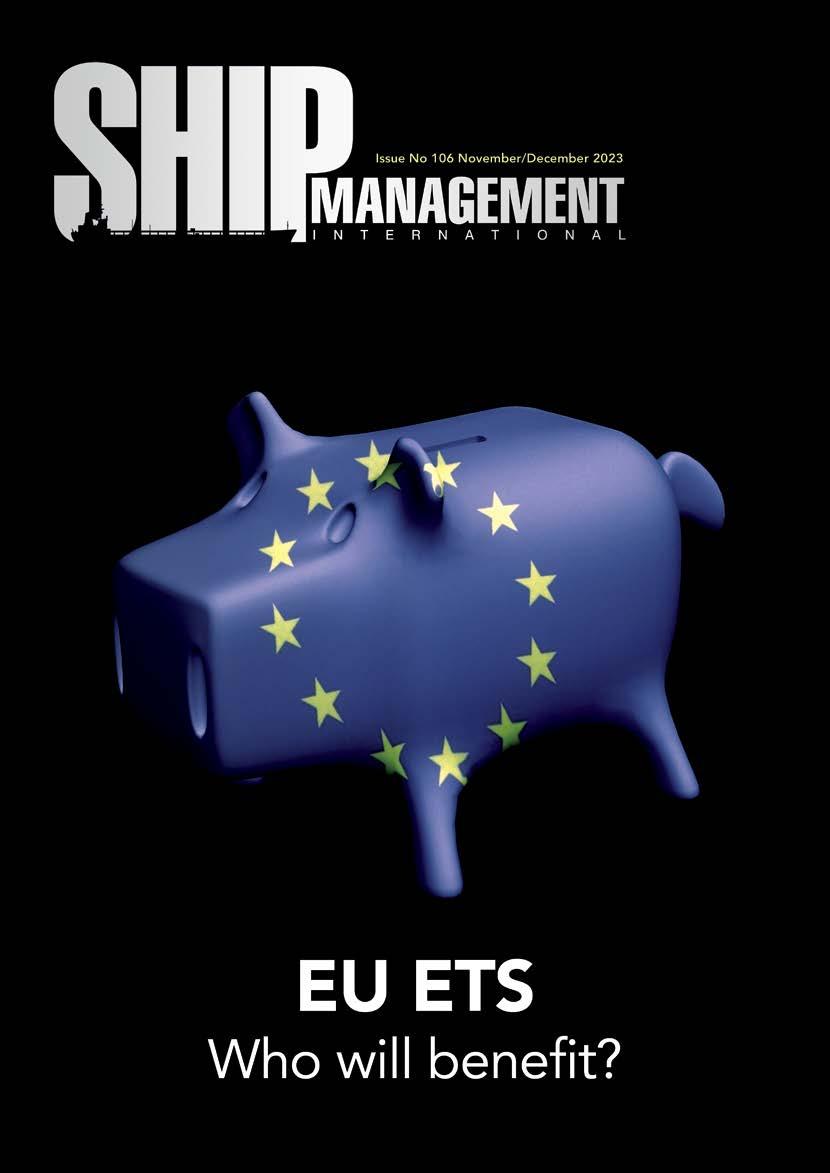
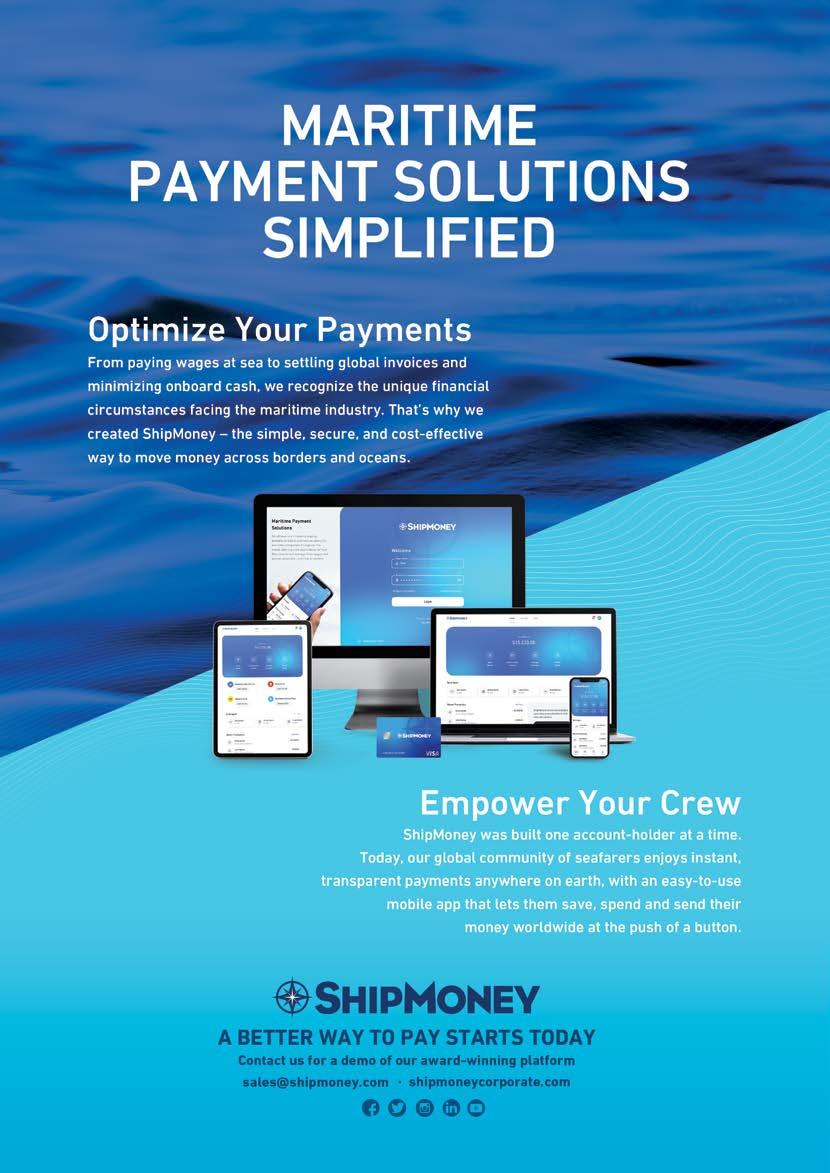


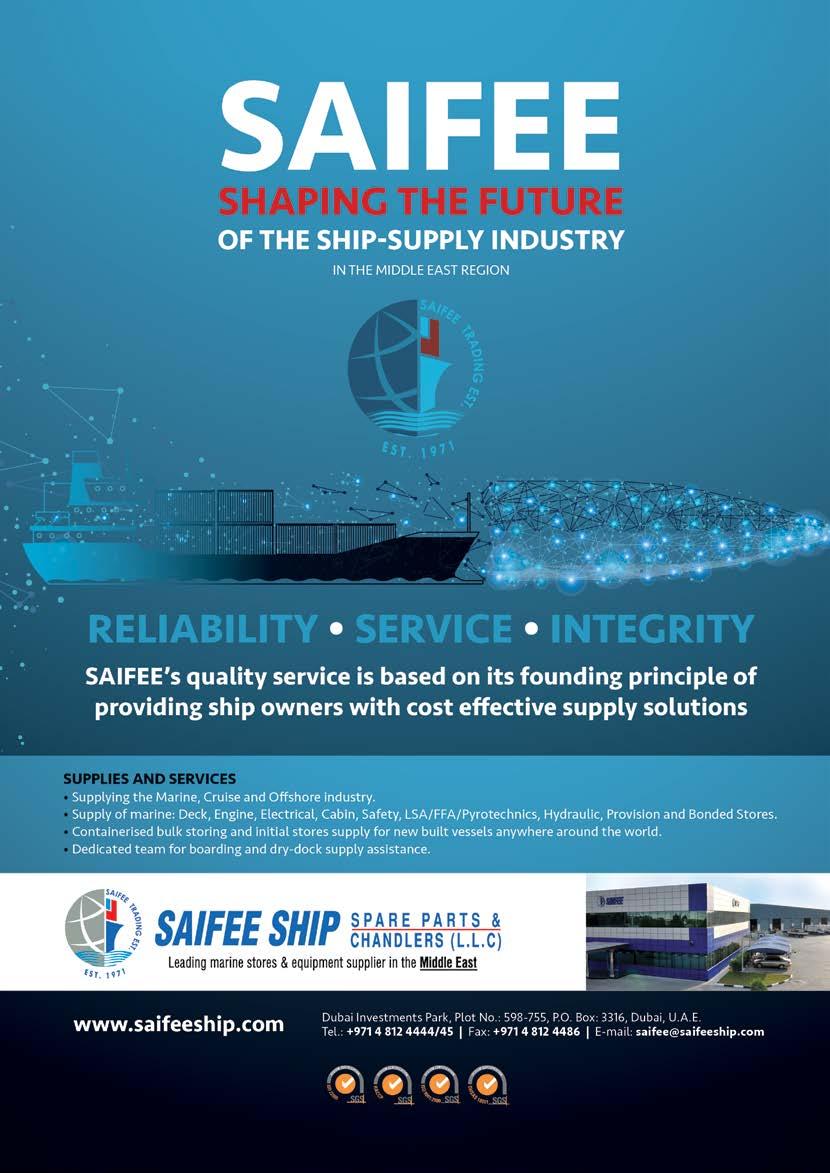
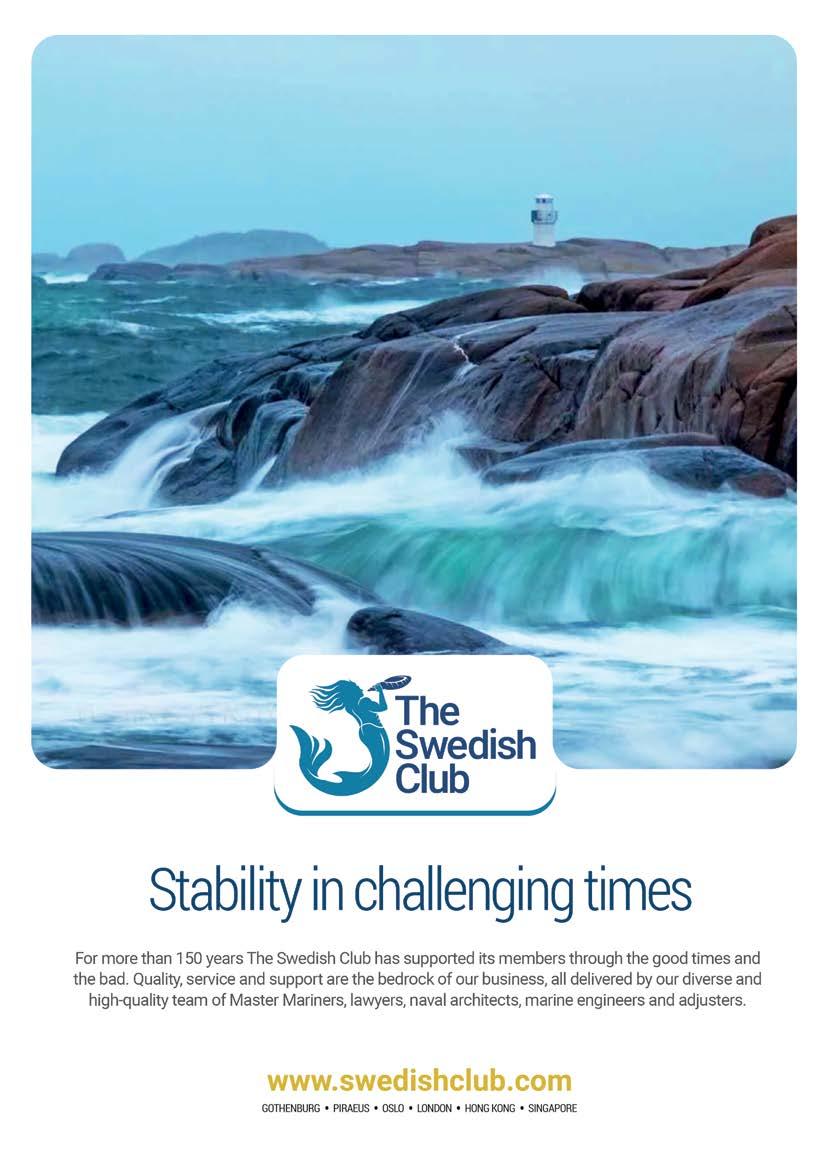


in your details to receive.

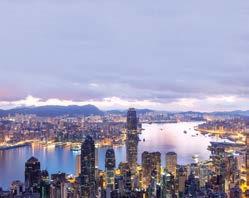


STRAIGHT TALK HOW I WORK
8 – Making heavy weather out of climate change
NOTEBOOK
10 – Training seafarers for a decarbonised future
12 – Seafarer salaries have risen but welfare still falling short
13 – ICS launches first ‘The Master’s Practical Guide to Maritime Law’
16 – Six out of 10 investors mull divestment from maritime amid ESG concerns
19 – Rafael Fernandez elected as next ISSA President
20 – EU ETS - do you feel secure?
INTERMANAGER OUTLOOK
22 – Measuring milestones as we plan for tomorrow



– Peter Smit
– Bjørn Martin Klokkernes
P&I AND LAW DISPATCHES
– Combatting evasion of maritime sanctions

– EU ETS enters into force 38 – Europe’s road to decarbonisation will be imperfect, but crucial for global shipping
EU
Get
5 106 November/December 2023 Ship Management International 34
THE MAGAZINE FOR THE WORLD’S SHIP OWNERS & SHIP MANAGERS
Cover Story
ETS Who will benefit?
our magazine digitally. Scan QR code and fill
ISSUE 106 NOVEMBER/DECEMBER 2023
28
30
34
25
SMI WEBINAR

40 – Creating a Culture of Care Onboard for our Seafarers Navigating Wellness
MARITIME SAFETY
48 – VIKING changes shape of the lifeboat market
49 – Survitec demonstrates Seahaven advantages for cruise customers
REGIONAL FOCUS
– Year of achievement
62 – Shipyards: Expertise, experience and eco-credentials
67 – Türk Loydu begins new era as proud member of IACS
68 – Newport Shipping launches new venture at Cicek Shipyard
68 – Istanbul Marıne Turbıne welcomes Garrett partnershıp
70 – Maritime Trainer pioneers digital crew ‘learning’
CLASSIFICATION
71 – Decarbonisation Now
76 – Going with the wind
AD HOC
78 – Our regular diary section
ANALYSIS
80 – LPG carriers - booming markets in all sectors
ALTERNATIVE VIEWPOINT
82 – Maritime law and the Master
TECHNICAL
83 – Russia invests in Arctic corridor
NAVIGATION
87 – Data is our new North Star
CLEAN SEAS
89 – Air lubrication can help mitigate underwater radiated noise
REVIEW OBJECTS OF DESIRE
90 – Our pick of the most coveted creations Hong Kong 51– Compelling credentials
56 – Q&A with Bjorn Hojgaard, CEO of Anglo-Eastern Univan Group
57 – Why Hong Kong will continue to thrive: Hill Dickinson

Next issue
92 – Bringing you the best in arts & culture
LIFESTYLE
94 – Road test: Toyota GR Supra 3.0 manual
SHIP MANAGEMENT INTERNATIONAL – ISSUE 106 NOVEMBER/DECEMBER 2023 THE MAGAZINE FOR THE WORLD’S SHIP OWNERS & SHIP MANAGERS
In the January/February issue of SMI we shall be looking at latest developments in Singapore, generally accepted to be the world’s leading maritime hub for some years now, as well as that small island that continues to punch above its weight in shipping terms, the Isle of Man. Also there will be a sectoral report on Ship Registries, rounding up latest developments at the world’s leading flags, as well looks at latest trends and innovation in the fields of Crew Welfare and Maritime Safety. For advertising enquiries, please contact Sales by emailing sales@elaboratecomms.com You can also keep abreast of news and subscribe to our daily newsletter at shipmanagementinternational.com 6 Ship Management International Issue 106 November/December 2023
China 58
Turkey Report 61
– Towering presence

STRAIGHT TALK
Making heavy weather out of climate change
While COP28 for the first time pledged a global transition away from fossil fuels - much to the relief of smaller nations most vulnerable to climate change, environmentalists and the strong pro-decarbonisation shipping lobby alike - the effects of extreme weather are already becoming increasingly clear around the world and across its oceans.
The maritime industry is beginning to wake up to the implications of an increased likelihood of extreme weatherrelated disruptions. On the one hand, vessels have begun re-routeing to avoid the drought-induced delays being experienced by the Panama Canal – subject of last issue’s cover story – while on the other, insurers like NorthStandard have begun introducing Weather Cover into their suite of risks, covering shipowners and charterers from landside supply chain disruption, such as port closures or delays, caused solely by adverse weather conditions.
Meanwhile, there have been undeniable advances in weather forecasting capabilities, as used by ship operators
Sales Enquiries
Julian Berry
Editorial
Bob Jaques
Finance
Lorraine Kimble
Phone: +44 (0) 1296 682 051
Email:jberry@elaboratecoms.com
Phone: +44 (0) 1296 682 089
Email: editorial@elaboratecoms.com
Email: bjaques@elaboratecoms.com
Phone: +44 (0) 1296 682 051
Email: accounts@elaboratecoms.com
Wethernews’ own answer is to introduce what it calls ‘probablistic weather forecasting’ which not only offers business decision support by analysing the ETA, fuel oil consumption, CII and cost of different routes, but also includes a percentage likelihood of the predicted weather actually occurring. And AI and Machine Learning will now be added into this process to further improve calculations - a more scientific quantification of risk or attempt at ‘squaring the circle’, you might call it. l November/December 2023 |
for optimised vessel routeing. But US-based market leader Weathernews makes the point that while forecasting techniques have become more sophisticated - in its case it now uses daily weather updates from some 6,000 vessels – so the level of meteorological uncertainty has also increased.
As a result of climate change sea temperatures are rising, low pressure systems are developing more rapidly and spreading storms and swell; maximum wave heights have increased steadily year-on-year for the past 30 years, it says. And these patterns are impossible to predict with total accuracy because of the ‘chaotic’ nature of the atmosphere.
Publisher: Sean Moloney
Editor: Bob Jaques
Sales Manager: Julian Berry
Finance: Lorraine Kimble
Design and Layout: Diptesh Chohan
Regular Contributors:
Michael Grey
Felicity Landon
Ian Cochran
Margie Collins
Ema Murphy
Motoring Journalist: Rob Auchterlonie
Technical Editor: David Tinsley
Editorial contributors: The

Issue 106 The shipping business magazine for today’s global ship owners and ship managers Join the debate @ShipManInter Visit our website www.shipmanagementinternational.com Download our App Ship Management International
Printed in the UK by Warners Midlands plc. Although every effort has been made to ensure that the information contained in this publication is correct, Elaborate Communications accepts no responsibility or liability for any inaccuracies that may occur or their consequences. The opinions expressed in this publication are not necessarily those of the publishers. All rights reserved. No part of this publication may be reproduced whole, or in part, stored in a retrieval system or transmitted in any form or by any means without prior permission from Elaborate Communications.
Wingbury Courtyard Business Village, Upper Wingbury Farm, Wingrave, Bucks, HP22 4LW, United Kingdom
best and most informed writers serving the global shipmanagement and shipowning industry.
8 Ship Management International Issue 106 November/December 2023
Published by

Notebook
Training seafarers for a decarbonised future
Anew training project will prepare seafarers for zero or near-zero emission ships, helping the global shipping industry decarbonize and ensure a just transition for seafarers.
Research commissioned by the Maritime Just Transition Task Force identified that 800,000 seafarers may require additional training by the mid-2030s in order to operate vessels run on zero or near zero emission fuels.
With seafarers at the core of the shipping industry, this training is vital to ensure a successful and just transition to a new shipping landscape. The training framework, funded through the International Maritime Organization (IMO) and Lloyd’s Register Foundation, will equip seafarers with skills in decarbonization, and provide guidance for trainers and the industry.
The project is being announced at the 2023 UN Climate Change Conference (COP 28), meeting in Dubai, United Arab Emirates, from 30 November to 12 December 2023.
Preparing the entire shipping industry for the green transition is essential. The 2023 IMO Strategy on Reduction of GHG Emissions from Ships sets a common ambition to reach net-zero GHG emissions from international shipping by or around 2050 (taking into account different national circumstances); and a commitment to ensure an uptake of zero or nearzero GHG emission technologies, fuels and/or energy sources to represent at least 5%, striving for 10%, of the energy used by international shipping, by 2030.
Kitack Lim, Secretary General of the International Maritime Organization, said: “The milestone adoption by IMO of the 2023 Strategy on the Reduction of Greenhouse Gas Emissions from Shipping shows the member States’ clear commitment to transitioning the shipping industry to a decarbonized future. To do this, we need to ensure no one is left behind and we need to
commit to training the workforce so that they are ready. This collaborative project will help ensure a successful and equitable transition, harnessing the collective strength of the global maritime community.”
Ensuring a safe working environment for seafarers, as well as the effective management and operation of future technologies is at the heart of this project. The need for dedicated training has been identified by IMO and social partners. IMO is comprehensively reviewing and revising its key treaty for seafarer training, the International Convention on Standards of Training, Certification and Watchkeeping for Seafarers (STCW), with input from industry, and seafarers’ unions.
Ruth Boumphrey, CEO of Lloyd’s Register Foundation, comments: “Moving towards a lowemission future will require new green jobs and reskilling, and the global maritime industry is no different. Future alternative fuel technologies, such as hydrogen, ammonia and methanol, means there is a vital need to up-skill all seafarers. That’s why the work of the Maritime Just Transition Taskforce and its latest training framework is essential to ensuring seafarers have the right training and skills to work in a safe environment. It puts seafarers and communities at the heart of the solution as the industry works towards achieving its target for net zero emissions for shipping by 2050.”
The project will be run by IMO and the Maritime Just Transition Task Force Secretariat. Lloyd’s Register will develop the training framework for seafarers and officers, as well as an instructor handbook for maritime training institutions. The World Maritime University (WMU), an IMO global research, education and training institute based in Malmö, Sweden, will provide academic expertise. A large number of organisations are involved through a global industry peer learning group, which will provide important knowledge-sharing.
10 Ship Management International Issue 106 November/December 2023
Once developed, the Baseline Training Framework for Seafarers in Decarbonization will be first tested out in Asia through a programme led by WMU, with support from the IMO Maritime Technology Cooperation Centre (MTCC) Asia and other partners. Training materials will be developed for all seafarers and for officers. The aim is to then expand testing of the package globally with all the established MTCCs and other appropriate organisations.
Guy Platten, Secretary General of the International Chamber of Shipping, said: “2030 is just around the corner and we cannot be complacent about the needs of our seafarers and the appropriate training being in place to support them during our transitioning sector. Without our people we have no industry so seafarers should always be at the forefront of every decision.
“As we move forward into Phase II of the Maritime Just Transition programme, we must now all continue to work together and further build on the strong relationships formed in Phase I to ensure that our seafarers have the training they need.”
This package will be available to IMO Member States, for potential use by maritime education and training (MET) institutes to develop their programmes, as appropriate. A ‘train the trainer’ programme will also be developed to assist METs further.
The Maritime Just Transition Task Force was formed at COP 26 in 2021 by the International Chamber of Shipping (ICS), the International Transport Workers’ Federation (ITF), the United Nations Global Compact, IMO and the International Labour Organization (ILO). Primarily supported by funding from Lloyd’s Register Foundation, the taskforce has worked to ensure seafarers are put at the heart of shipping’s response to the climate emergency. The timeline is to develop the training materials by mid-2025. l
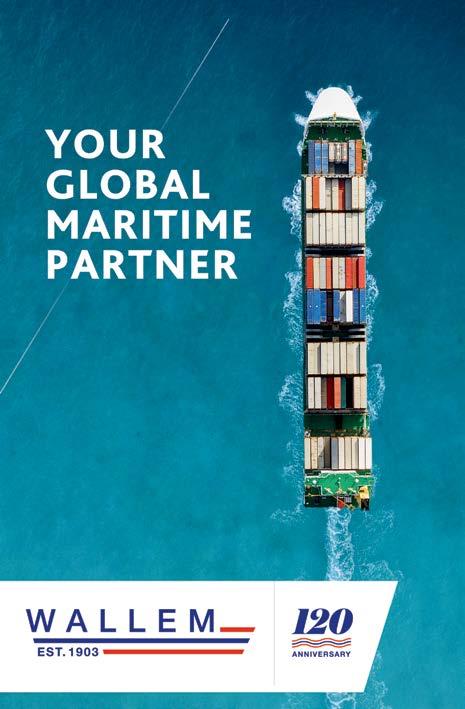
Notebook
11 106 November/December 2023 Ship Management International
Seafarer salaries have risen but welfare still falling short
Salaries are rising by at least 10% as the crew employment market tips in the favour of seafarers, reveals Danica Crewing Specialists as it announces the findings of its 2023 Seafarers’ Survey.
Across senior officer ranks salaries have increased some 10-15%, regardless of nationality, the Danica survey shows, compared to its 2021 results. Salary figures are particularly strong for the top four ranks on dry cargo vessels.
The wage gap is narrowing between Filipino and Eastern European officers, while Indian senior officers on dry cargo vessels are receiving salaries 10% higher than their Eastern European counterparts.
Salary rise is the most common reason for seafarers switching shipping companies, the survey indicates. Some 35% of crew who changed employer recently did so for a higher salary, although 26% moved for a more suitable joining time. And 98% or respondents said they check vacancies while on home leave.
Announcing the 2023 survey results during the Crew Connect Global Conference in Manila, Philippines – where Danica recently opened its latest crewing office – Henrik Jensen, CEO of Danica Crewing Specialists, said: “These are all indications that the crew employment market has tipped to be in the seafarers’ favour.
“We are witnessing a wage spiral like we saw leading up to the previous financial crisis. The root cause for these wage increases is the combination of a general shortage of very competent seafarers and a better financial situation for most vessel owners which is making employers more generous with remuneration,” he explained. “And, with a surplus of job offers, seafarers can afford to be picky.”
Seafarer shortages are more evident in certain ranks. The Danica survey identified bosuns, cooks and fitters as being in high demand, with salaries up 10% as a result, while Ukrainian fitters have had pay increases of up to 30% due to a huge shortage.
Seafarers remain largely satisfied with their careers at sea with 80% saying they would recommend their employer to a friend, while 50% would recommend seafaring to their children. But the lure of a shore position is also strong with 70% of respondents saying they would be interested in working ashore.
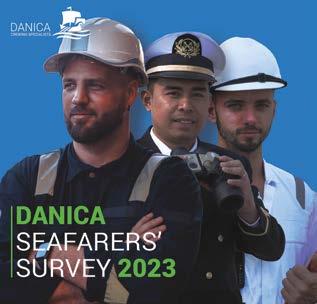
Worryingly the Danica survey revealed that as many as 36% of the respondents, drawn from the worldwide crewing marketplace, claimed their salary was not paid on time – a rise of 7% since 2021 – with 8% saying they did not receive their salary in full. Also, 23% of respondents said they had experienced a shortage of food or drinking water during their recent voyages.
Fortunately, the number of seafarers not being relieved on time has fallen to pre-pandemic levels (24%) – but that’s still almost a quarter of crew.
Other findings of the survey include that 5% of seafarers report having been bullied, 4% felt they had suffered discrimination because of race, and 1% suffered sexual harassment. Over 50% reported they had access to mental health support if needed, 70% finding this useful. Computerbased training was on the up, with 55% receiving this onboard and 60% during home periods, mainly on technical subjects. Internet connectivity at sea is now available to 96% of crew, up 6% from 2021, with 70% saying this access was free to use – a rise of 15%.
Mr Jensen commented: “Our survey revealed some interesting and surprising results which we hope will help our owners to enhance their marine crewing and HR strategies. We don’t claim this survey is representative of the whole industry or scientifically accurate but we do believe it gives a good snapshot of the seafarers’ situation in 2023.” l
Notebook 12 Ship Management International Issue 106 November/December 2023
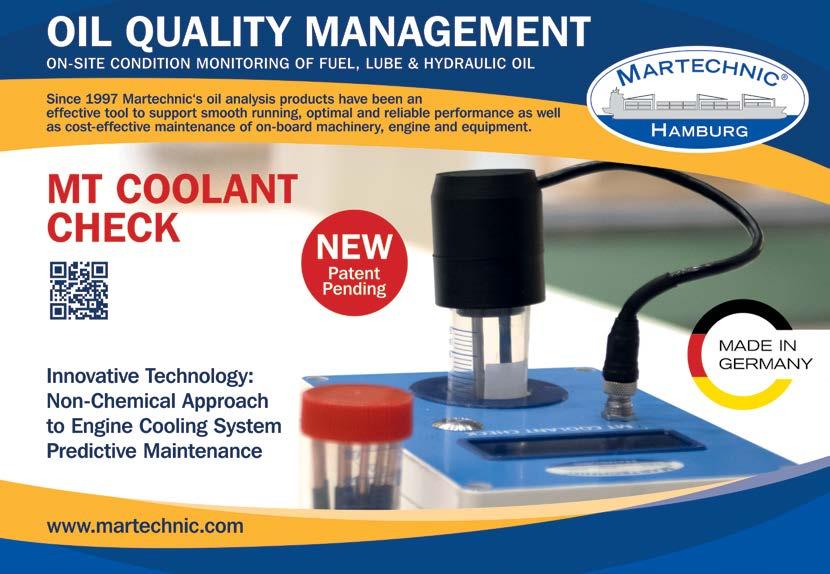
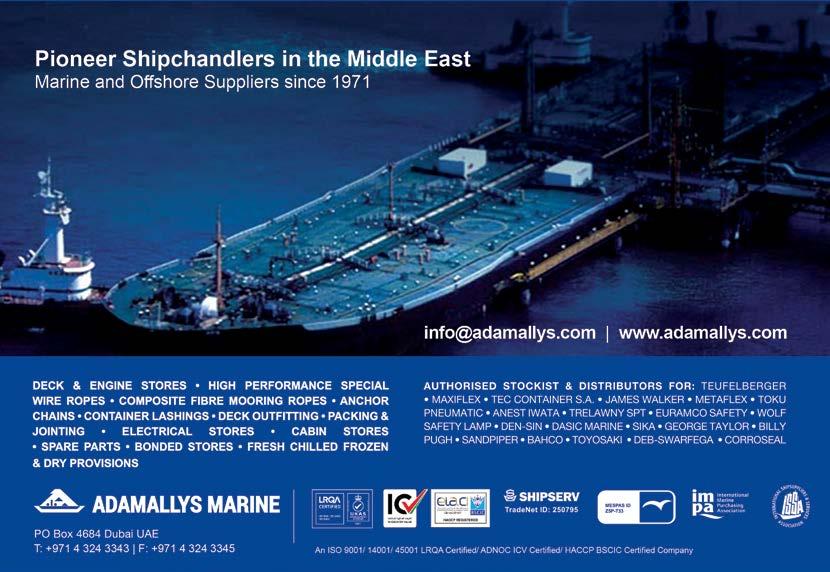
ICS launches first ‘The Master’s Practical Guide to Maritime Law’
The International Chamber of Shipping (ICS) has launched its first edition of ‘The Master’s Practical Guide to Maritime Law’ as a simple and practical legal reference book specifically to aid seafarers with incidents at sea.
Co-authored with the International Federation of Shipmasters’ Associations (IFSMA), the guide is specifically designed to help Masters at sea identify and address common legal issues. As Masters are not qualified lawyers, the guide helps them understand how to manage legal risks and respond within the confines of the law to protect the interests of themselves, the shipowner and other crew members. With such high stakes, ICS believes it is crucial for Masters to have access to this one-stop-shop for practical legal guidance.
The detailed and practical guide bridges the gap between theory and practice by bringing real-world situations, both in port or sea, to life, helping Masters navigate common legal issues and pitfalls and assist in protecting the shipowner’s interests.
Guy Platten, Secretary-General at the International Chamber of Shipping, commented: "The current maritime operating environment is rapidly changing, and this comprehensive guide is vital to supporting seafarers with incidents at sea. This first edition specifically for seafarers is essential reading not only for seasoned Masters seeking to refresh their knowledge, but also Masters who are embarking on their very first voyage and would benefit from guidance through the legal intricacies within the maritime industry.
“Working so closely with IFSMA on this guide was crucial in ensuring that the guide addresses the key legal issues commonly facing Masters today and provides comprehensive guidance in an easy to digest way.”
‘The Master’s Practical Guide to Maritime Law’ encompasses a wide range of subjects: with
each chapter, Masters will gain a comprehensive understanding of their rights, responsibilities and obligations under maritime law from the start of a voyage until the end. It covers the legal responsibilities in areas such as ship documentation, contractual relationships and commercial responsibilities for carriage of cargo, as well as dealing with crimes on board and local legal enforcement. The guide also explains the international conventions that underpin the global maritime legal framework, for example on pollution regulations.
Serving shipmaster Martin Bjorkell, who contributed to the guide and recently presented on it at the IFSMA Biennial General Assembly in Tokyo, said: “This guide will prove invaluable for our industry and help Masters know how to approach legal issues effectively, highlighting best practices and providing expert guidance on managing legal risks, with particular emphasis on the commercial aspects that form a significant part of every Master’s responsibilities on board. We wanted Masters to feel empowered to make informed decisions on matters that might have legal consequences to ensure the safety of the crew, ship, environment and cargo.”
The guide is valuable for a wide array of individuals working across the whole industry including chief officers, shipowners, P&I clubs, officers in training and training institutions.
While the guide strives to offer a comprehensive overview on legal issues which the Master may encounter, it does not replace the need to obtain professional legal advice in the relevant jurisdiction particularly when the Master and shipowner is faced with legal challenges beyond the scope of the guide.
For more information and to pre-order ‘The Master’s Practical Guide to Maritime Law’, please visit: https:// publications.ics-shipping.org/single-product.php?id=91 l
14 Ship Management International Issue 106 November/December 2023 Notebook
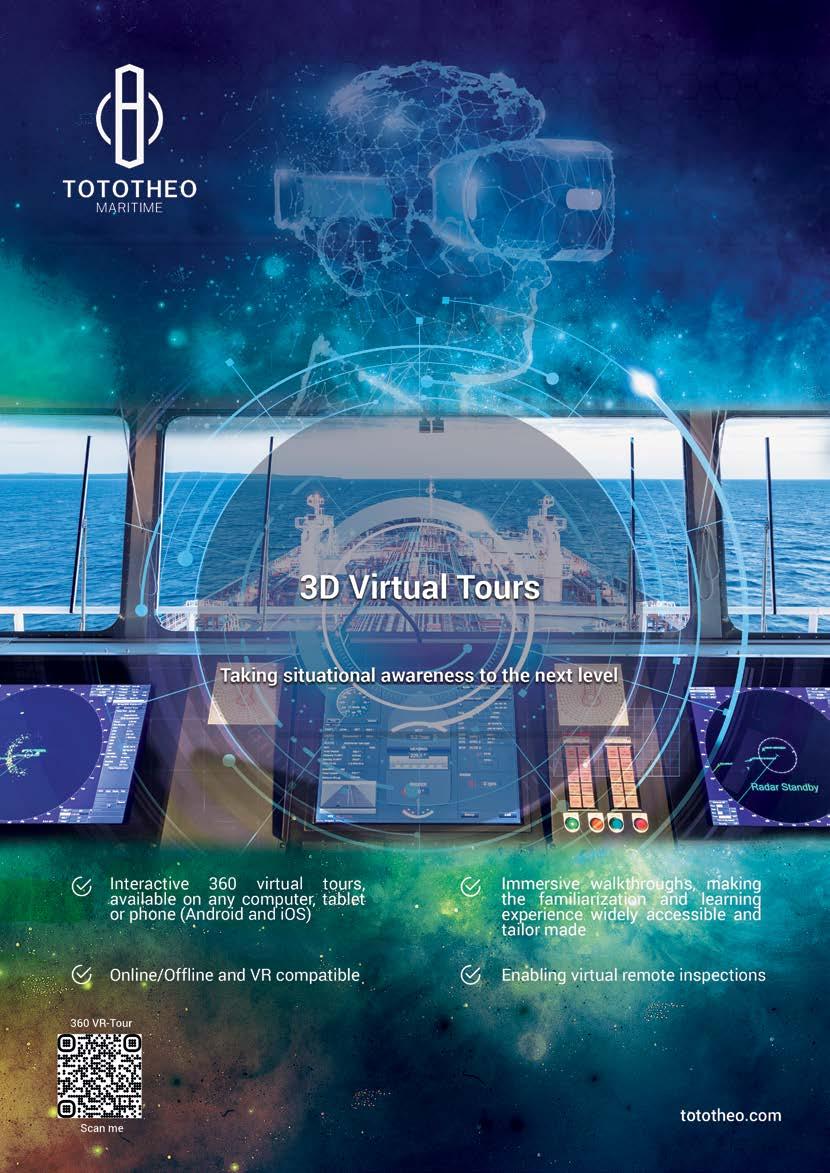
Six out of 10 investors mull divestment from maritime amid ESG concerns, finds report
Sustainability and communications consultancy
Woodrow has published a report showing that 64% of senior finance professionals in the UK are contemplating reducing their investment in the maritime sector because of Environmental, Social, and Governance (ESG) risks. The study offers insights into how ESG considerations are impacting decisions in capital markets.
The report sheds light on key areas of ESG risk perceived by lenders and investors, including labour rights, climate change and regulatory compliance. It also assesses risk perceptions in specific maritime sectors such as shipping, ports and terminals, and offshore activities like drilling.
The survey engaged 100 senior finance professionals from various segments of the UK capital markets, including commercial and investment banks, asset managers, development and multilateral banks, as well as private equity firms.
ESG factors are increasingly instrumental in shaping a company’s financial future. In the maritime sector, issues like poor wastewater management affecting biodiversity, or subpar working conditions on ships, carry potential regulatory repercussions and reputational damage. These are not just ethical concerns but critical factors that investors, lenders and underwriters are incorporating into their capital allocation strategies.
Given the capital-intensive nature of maritime activities—ranging from shipbuilding to pioneering new fuel technologies—secure access to financing is crucial, heightening the need for effective ESG risk management.
Two-thirds (66%) of respondents believe that the maritime sector faces greater ESG-related financial risks compared to other industries. This perception is particularly strong among those managing debt capital (73.5%) and among large institutions with assets under management (AUM) ranging from £10 billion to £100 billion (75%).
Perceptions differ according to the type of financial institution and its exposure to maritime assets.
Investment banks were the most concerned (83.3%), whereas multilateral banks and IFIs were less aligned, with only 40% sharing this view. High maritime exposure led to higher concern (69.7%), compared to limited exposure (52.9%).
The report unveils widespread scepticism about the maritime sector’s ESG awareness and transparency, with 57% considering the sector less aware and 56% criticising its transparency. This scepticism is heightened among those handling equity capital – 66.7% questioned the sector’s awareness and 64.1% its transparency.
The type and size of institutions influenced these perceptions. Larger institutions (AUM between £10-£100 billion) generally agreed with these negative views, while smaller institutions (AUM < £1 billion) were less convinced.
Survey participants cited several areas of ESG vulnerability for maritime assets, with worker conditions and safety at 38%, technological disruptions at 34% and climate impact at 33%. Concerns varied depending on the type of capital managed and the level of maritime exposure. Equity managers prioritised climate impact (38%), while debt managers focused on biodiversity (41%). Those dealing with hybrid capital expressed most concern about technological disruptions (41%) and water management (44%).
Henry Kirby, head of Woodrow’s sustainability practice, said: “This report reveals a paradox: while capital markets consider the maritime sector to be ahead in managing ESG risks, they also find it lacking in transparency and slow to integrate sustainable practices. This inconsistency is alarming, particularly when a majority of financial institutions are mulling over divesting from or reducing exposure to maritime assets due to ESG concerns.
“The way forward involves two key shifts: maritime companies must improve their disclosure and be more forthright in engaging stakeholders, while investors and lenders should apply a more discerning lens when evaluating maritime risks and opportunities.” l
16 Ship Management International Issue 106 November/December 2023 Notebook

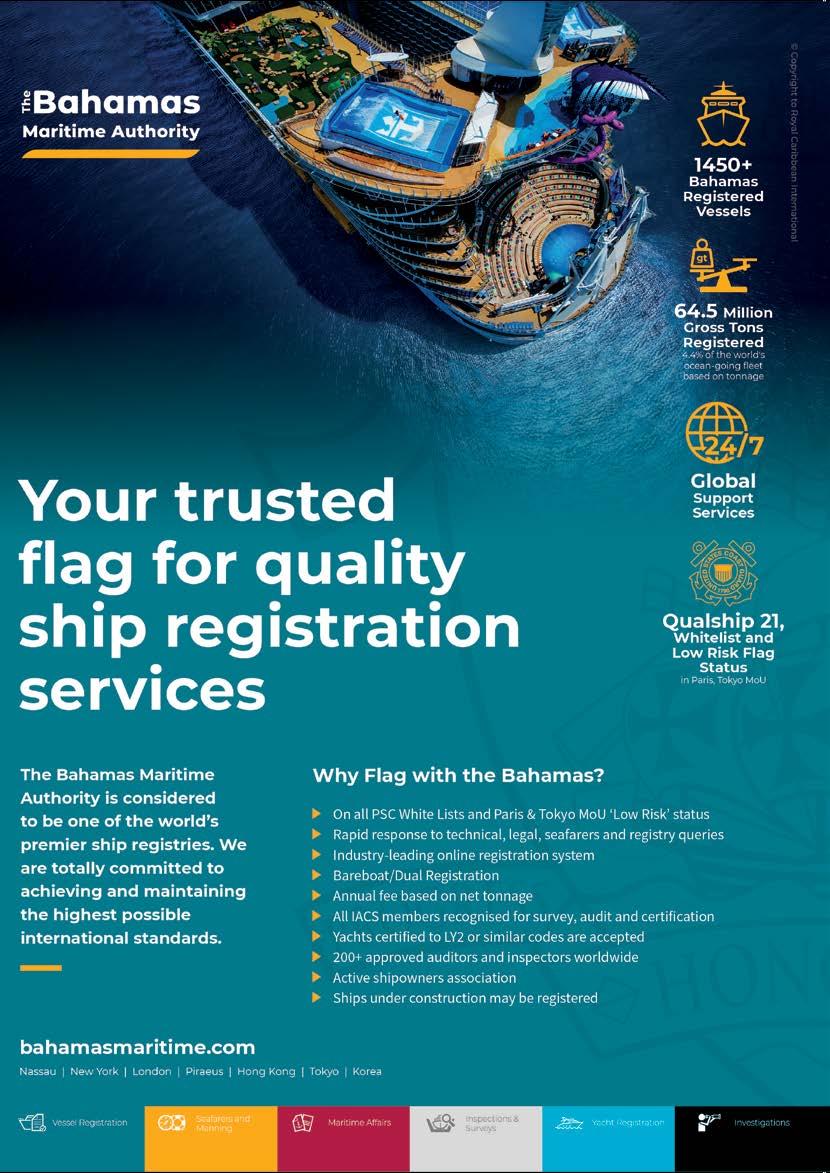
Rafael Fernandez elected as next ISSA President
Rafael Fernandez from Spain has been elected as the next President of the International Shipsuppliers & Services Association (ISSA), the global trade body representing the interests of 1,500 ship suppliers around the world.
The 40 National Associations of ISSA, who form the ISSA Assembly, elected Mr Fernandez during a vote prior to this year’s ISSA conference in Dubai.
Mr Fernandez has sat on the ISSA Executive Board for 12 years, and will take over as President from January 1, 2024.
Speaking after his election, he praised the work of the outgoing President Saeed Al Malik, saying he had created a strong foundation from which to grow ISSA.
“I am delighted to have been elected as the next ISSA President and I will work hard to ensure that ISSA continues to represent the interests of this very important global maritime sector.

“Global trade needs ships and ships cannot travel without being supplied so the work of our members is vital around the world, and I will continue to work with our fellow international ship owner and ship manager trade associations to ensure the voice of the ship supplier is heard.
“I am delighted to announce that the venue for next year’s ISSA Convention will be in Seville in Spain and we look forward to welcoming ship suppliers as well as owners and managers to that event,” he said. l
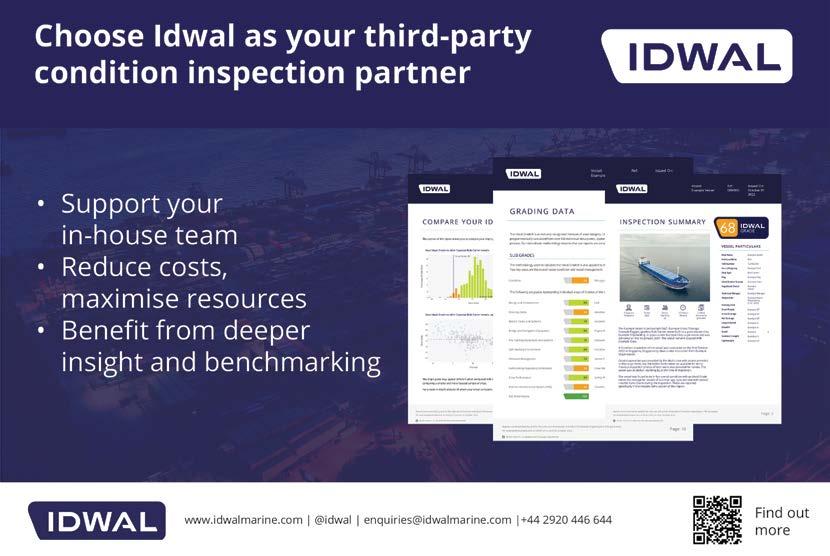
Notebook
EU ETS – do you feel secure?
 By Robert Hodge
By Robert Hodge
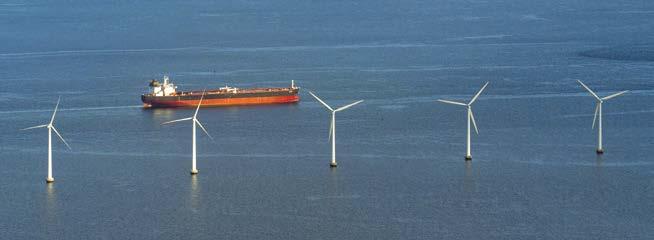
ITIC wrote an article for SMI in January 2022 critiquing draft legislation coming from the EU on the upcoming EU Emission Trading Scheme (ETS). This legislation, in part, sets out which party would ultimately be responsible for the payment (or nonpayment) of emission allowances. At that time, it placed that responsibility squarely at the feet of the Document of Compliance (DOC) holder. This was a crazy proposition, considering the manager has no control over the commercial operation of the ship, and it did not follow the usual principle that the polluter pays. A failure to comply could result in fines (EUR 100 per tonne), detention or, at worst, the blacklisting of an entire fleet from EU waters.
Thankfully, the position has changed and the legislation now being considered states that the responsible entity will be the registered shipowner.
The shipowner will then be able to transfer responsibility to the DOC holder or a bareboat charterer by a written agreement.
ITIC is on the BIMCO drafting subcommittee of the new version of SHIPMAN, which is planned to be published early next year. Much of the subcommittee’s work to date has been spent on a new ETS clause (which, at the time of writing this article, had not been finished, but is hoped to be approved and released before the ETS deadline of 1st January 2024).
There are three scenarios which are envisaged. In the first, the shipowner remains the responsible entity for the surrender of the emission allowances. It is likely that
larger shipowners who have the ability and the capacity will want to keep the responsibility within their control. However, the manager will remain crucial to the owner as they have to provide the emission data to the owner so they can calculate and surrender the allowances.
In the second scenario, the owner retains responsibility but engages the ship manager on a consultancy basis to collect the emission data, arrange for it to be submitted and range for the payment of the allowances.
The third scenario is where the owner transfers the responsibility to the manager by a strict written mandate. Amongst the requirements for the mandate are that it must be an original signed by both the shipowner and the organisation assuming responsibility for compliance, or if a copy is provided, it must be certified as a true copy. This scenario is the riskiest for the manager as the credit risk will be significant. Many owners will not want to pay the manager in advance, but only on actual emissions and paid for in arrears. If this is agreed upon, the contract must be explicit on the financial security for the manager. This could be a cash deposit or issued as a number of allowances to be held on account (such as 45 days of allowances for the ship at full steaming).
ITIC’s advice at this time is that if ship managers are not totally satisfied they have adequate financial security, they should not agree to be the responsible entity and only agree to assist the owner in their compliance with the scheme. The credit risk and penalties for noncompliance are just too onerous. l
20 Ship Management International Issue 106 November/December 2023 Notebook

InterManager Outlook Measuring milestones as we plan for tomorrow

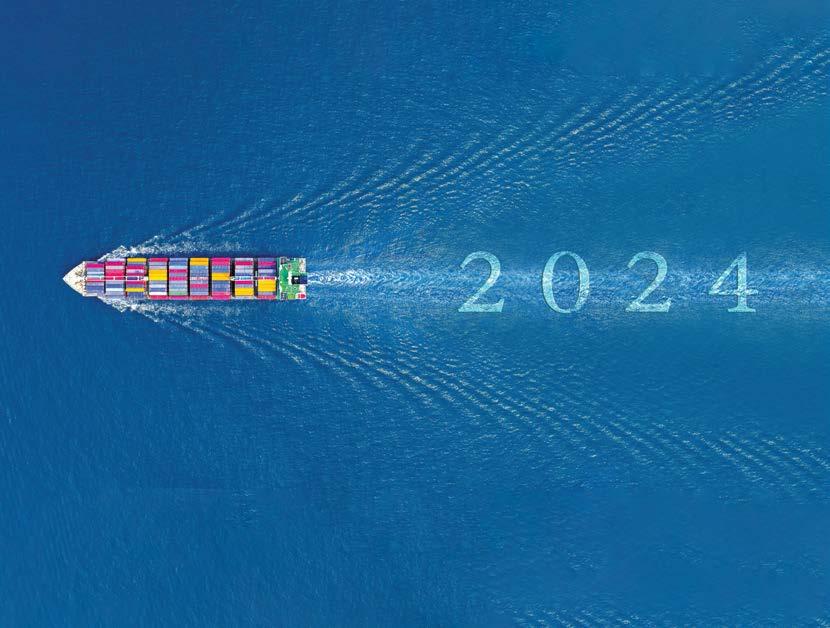
AInterManager Secretary General Kuba Szymanski looks back on an eventful 2023, and forward to 2024.
s this year draws to a close it is useful to take stock and look back on some InterManager milestones. Foremost of these is the launch of our new General Principles of Conduct and Action. These groundbreaking principles will undoubtedly raise standards in our sector and give the wider shipping industry a means by which to evaluate our services.
Ship management is evolving and today our members offer a wide range of added value and bespoke services which provide ship owners and operators with a myriad of opportunities and methods to streamline their operations in a sustainable way.
The shipping industry is moving steadily towards a more sustainable, efficient and environmentally friendly future.
This year the International Maritime Organization achieved unprecedent agreement from all its member states to adopt ambitious new decarbonisation targets. InterManager was present at these crucial debates, representing our members’ point of view and working with stakeholders and industry groups to ensure proposals are practical and workable.
InterManager continues to work closely with the IMO. We welcome the appointment of Arsenio Dominguez Velasco to the role of Secretary-General and look forward to enhancing our working relationship with him and his team. InterManager is pleased to be the record keeper for a range of industry statistics, particularly relating to lifeboat safety and deaths in enclosed spaces, and we take an active role in working groups which aim to update and improve IMO legislation to protect seafarer health and wellbeing.
The turn of the year heralds a new challenge for ship operators – that of implementing the European Union’s Emissions Trading Scheme. On behalf of its members, InterManager engaged in high-level discussions to influence
and inform decision makers, also seeking legal advice to ensure the scheme has the best chance of achieving its environmental objectives in a practical way. We will be monitoring how the scheme operates in 2024 and will provide a platform for members to raise concerns and speak out. As our President regularly reminds us, by speaking with One Voice we speak louder and have more influence!
Although small, InterManager’s secretariat is extremely active on our members’ behalf. We engage in industry dialogues, attend - and even chair - stakeholder groups, and also campaign on key issues. Our members are themselves proactively involved in sharing information and best practice and it is heartening to be part of email discussions where members raise an issue and share their experiences to identify solutions – something which happens on a regular basis.
Looking forward to 2024, we will begin the year with our Annual General Meeting which is being held at the IMO’s London headquarters on Thursday 18 January. We look forward to welcoming many members and associate members, as well as invited guests and industry colleagues to take part in our conversations. Contact me if you would like to attend or for information about how to become an InterManager member.
Meanwhile I am pleased to report that our members are already putting into action our General Principles of Conduct and Action. We have several firms currently undertaking the self-assessment process and we urge all our members to endeavour to complete their first assessment by April to enable everyone to begin this shared journey towards high standards in a sustainable, efficient, and transparent way.
I wish you a Happy Holiday Season and a successful New Year! l
22 Ship Management International Issue 106 November/December 2023

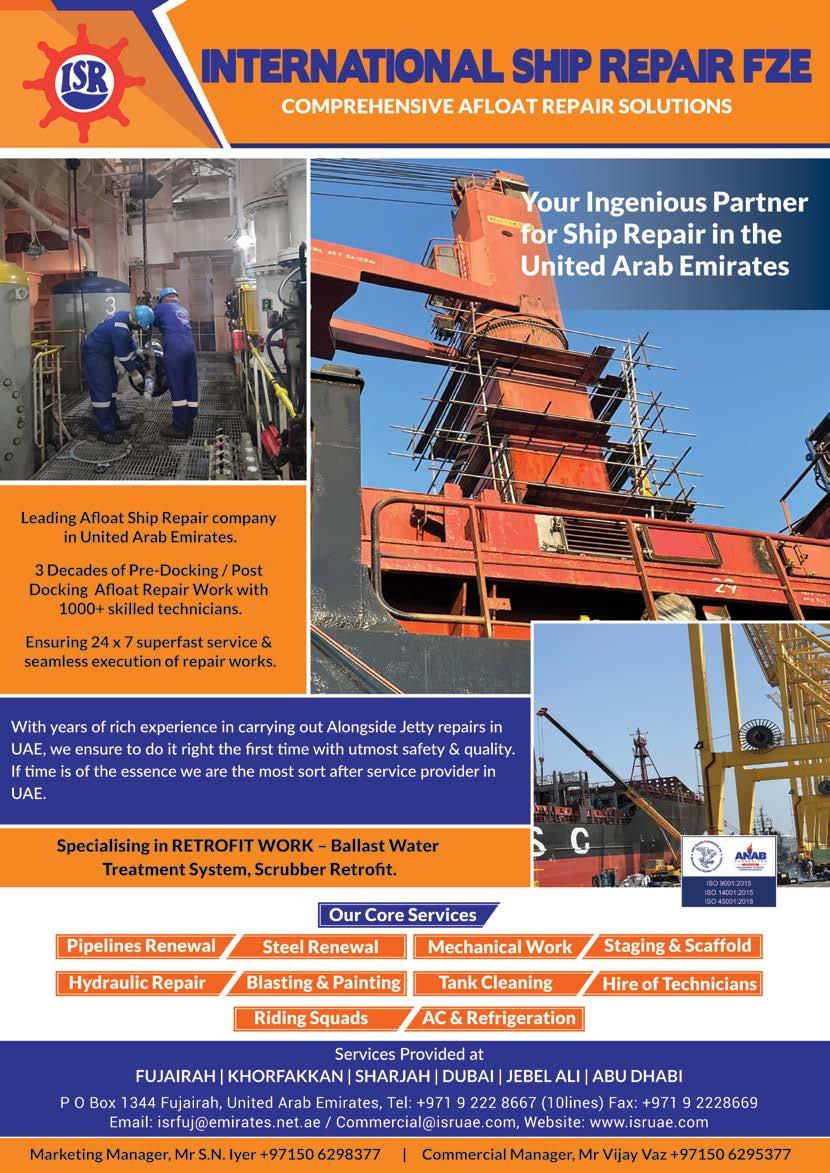
How I Work
SMI talks to industry leaders and asks the question How do you keep up with the rigours of the shipping industry?
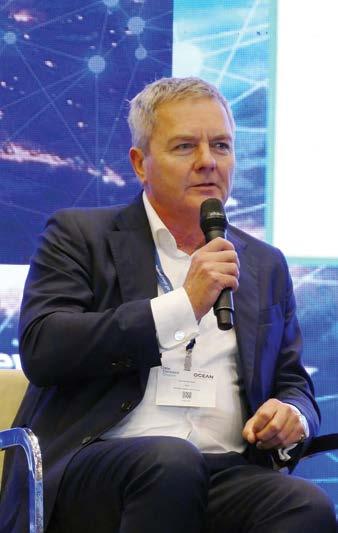
Peter Smit
Joint CEO of BCS Group – Boers Crew Services
Growing up in Rotterdam, home to Europe’s biggest port, working in the maritime industry was always an ambition for Peter Smit, Joint CEO of BCS Group – Boers Crew Services.
Mr Smit worked for many years as an independent boardroom consultant where he advised companies on how to get the most out of their business by streamlining and improving their IT processes, many of is clients being companies within the maritime industry.
It was through this work that he met Hans Boers whose grandfather started up the company as a taxi firm for seafarers in the 1940s, for whom he first carried out some consultancy work 11 years ago. At the time the company was open to further investment to help advance it to the next level, and Peter was struck by the Boers’
work ethic, culture and passion for the shipping industry and its crews, prompting him to invest in a 50% share of the business.
“It had such a family feel and was very open and transparent which I loved,” he recalls. “It was also a ‘doing’ company in that it just got things done. I was immediately impressed with what it offered and had already achieved, and I recognised the potential growth and where it could go with two partners at its helm. Hans and I work very well together and we have both brought our family members onboard to help us grow the company.
“But it’s not just working with our family that gives it a family, welcoming feel,” he continues. “ We treat everyone the same, so if I was having a meeting with my daughter we can both be open and honest and say whatever we are thinking, we also extend that respect to all staff members. Everyone is treated with respect and integrity and they are given the opportunity to be completely open and honest with us.”
Having the right team in place in also something Boers prides itself on. “We are very strict in whether an employee is the right fit for us. If we don’t feel it is right for us and the employee then we will let them go. We are a very caring, flexible employer so we look after our team and they know they are part of the Boers family,” he adds.
As Joint CEO, Peter Smit sees his responsibility as being problem-solver and decision maker when tough calls need to be made. He is responsible for the strategy and vision for the businesses. He says no two days are the same: one day he could be facilitating a last-minute visa application, and the next he could be closing on a new business deal or speaking at top-level conferences about the importance of ensuring the journey of a maritime professional is as seamless as possible for them.
He recently participated at CrewConnect’s Fireside Side Chat panel when he joined other key players in the industry to discuss decarbonisation, crew welfare, operational efficiency and the strategic measures that are going to be needed over the next five years.
He believes it is crucial that the industry looks not only at the problem of attracting seafarers but also at their retention to try to alleviate the issues stemming from crew shortages.
25 106 November/December 2023 Ship Management International
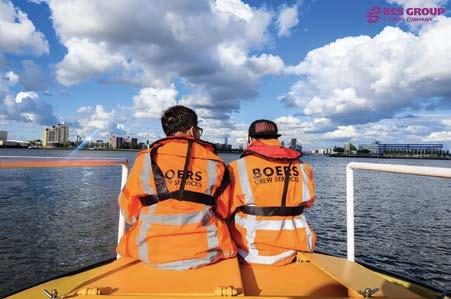
“We should be looking at why we are not keeping people at sea for long periods of time,” he says. “It seems people are gaining their training or qualifying as a Cadet but then do not last at sea for a long time. I think we need to focus on getting the right people in the job, ensure they are well paid and treated fairly… and not only fairly, treated well. That is a combination of good wages, no delays in the journeys to and from the ship, good connectivity and entertainment onboard.”
Boers has recently held its own event in Manila for the second year running where it partnered with KLM Royal Dutch Airlines, for manning agency staff, travel agents and other interested parties to discuss and share best practice over how to ensure a smooth transition process for crews.
The company has also reaffirmed its commitment to Filipino seafarers with plans next year to open an office in Manila where it will have a direct presence for crews based in Manila and will be able to work with authorities there to facilitate visa applications, which can be a complicated and complex process for the Schengen visa.
Looking back over the last five years, Mr Smit says by far the biggest challenge the company has faced was the Covid pandemic, which saw
Boers show steal a march on some competitors by doing everything it could to ensure seafarers could still travel. This despite authorities around the world either closing ports or introducing entry measures to prevent potential coronavirus carriers from entering their country, resulting in huge challenges in facilitating crew changes.
Mr Smit says Boers certainly rose to the challenge and proved itself as a company that will always go the extra mile, whatever the obstacle. While seafarers were struggling to travel with airlines cancelling flights across the globe, Boers worked with ship owner clients who had arranged charter flights to take seafarers across Europe. The company contacted other
clients who needed to move crews and managed to fill flights, thereby reducing the cost to the original aircraft chartering company.
“Nobody could travel, and seafarers need to travel to get to the vessel and then home again, and we really had to think about what we could do,” he remembers. “We came up with the idea of working with clients to charter our own planes, so that’s what we did and we were able to move crews around. Dealing with all the different restrictions in different ports was extremely challenging, but we are specialists so by utilising our contacts, knowledge and expertise, we were able to help companies who were really struggling.”
Boers Crew Services offers an end-to-end solution when transporting shipping crew members to and from ports in The Netherlands, Belgium and Germany, dealing with everything from entry visas to medical services, hotel bookings and transport services.
During his downtime, Peter Smit is a keen sportsman enjoying regular family skiing holidays to Austria. And after playing tennis since his early childhood, in the past three years he has taken up the emerging racquet sport of padel – a cross between tennis and squash - which he now plays two or three times a week. l

How I Work 26 Ship Management International Issue 106 November/December 2023
 Bjørn Martin Klokkernes CEO, Star Information Services
Bjørn Martin Klokkernes CEO, Star Information Services
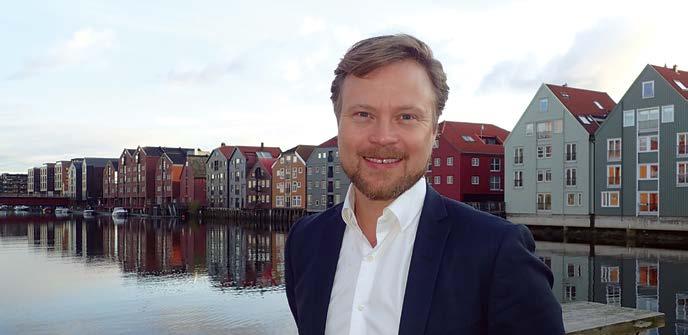
Bjørn Martin Klokkernes, CEO of Norwegian-based enterprise asset management specialist Star Information Services (STAR), is a firm believer in the need for a generational shift in digital technology skills - just as the experienced heads in the industry are approaching the twilight of their careers.
There is a pressing need to retain that deep wealth of industry knowledge acquired over decades by transferring and combining it with the new generation of digitally savvy young talent that holds the keys to future technological developments and operations, he reckons.
“We are seeing a clear trend in how the future of asset management and organising maintenance will change, as the supply chain will be handled very differently from today,” says Klokkernes.
“What is important in a transitional stage is to make sure that the whole organisation is also following. It is so easy to focus only on the generational shift in technology. However, organisations need to ensure the entire company grows together with new technology. For us, we need to make sure our
knowledge and know-how change at the same speed.
“We need to make sure that people are aware of the new technology, what needs to be done when it comes to knowledge sharing, and what kind of new skills we need so the organisation grows together with the new technology,” he adds.
Star Information Systems AS was established 25 years ago in the Norwegian university city of Trondheim and with offices also now in Singapore and Rio de Janeiro it has grown globally as a provider of software systems that enable the tracking and management of assets across the maritime and energy sectors, such as equipment on vessels or rigs, machinery and property, as well as workforce scheduling.
These systems provide a range of benefits for operators, ranging from enhanced and predictive maintenance planning, optimised performance, increased efficiency, improved safety and sustainability reporting, as well as better cost control.
“Over the last two years, we have worked hard on the technical side by developing an optimised system for the longer term with our new STAR Suite platform. But we have also focused on
recruiting new people to follow these market trends,” says Klokkernes.
“When you look at the market today, particularly on the shipping side, it is mainly staffed by an older generation of people used to working in a certain way. But we are heading in a different direction, with the development of new technologies and digitalisation.
“The generational shift in skills, including on the clients’ side, is starting to change the way the industry operates. Younger people are using more digitalbased products, mobiles, apps, and different types of screen displays. We also need younger people in our organisation to develop, produce, install and maintain these systems.”
STAR’s main office in Norway’s technology capital Trondheim allows for a close connection to Scandinavia’s largest independent research organisation SINTEF and the Norwegian University of Science & Technology. This position gives the company a front-row seat when it comes to new developments, and this includes Norway’s leading role in the march towards autonomous shipping.
“When you look at the shipping industry for the next 10 to 15 years,
28 Ship Management International Issue 106 November/December 2023
How I Work
everything will change when it comes to fuel and energy sources, and the use of autonomous vessels will inevitably become more common, posing the question - how are you supposed to handle maintenance on board a ship with no people on board?” continues Klokkernes.
“How will you plan for that when the ship is coming to the harbour? Everything needs to be ready and in place regarding scheduling, suppliers, parts and equipment. That is something we are preparing for and providing with STAR Suite, to make the whole maintenance planning cycle much easier for the future,” he adds.
Today, most of the maintenance and planning is done by the crew on board. However, Klokkernes points out that some of the equipment on board will get so complex the crew will not be able to manage it, even in person. “You will need third-party suppliers looking after maintenance, for example,” he says.
STAR has designed its platforms to allow for seamless and automated updates for operators, and under Klokkernes the company itself has been moving in that very same direction.
‘We have solid expertise gained over many, many years but our knowledge is not worth anything if it is not transferred to younger people,” he says. “The person we recruit now is the person who will be part of STAR for the next 10 to 20 years and our own next generation.
“It is hard for small companies to attract students as we are competing against the giants such as Apple and other big international players, but one way we can attract young people is to offer them the chance to be part of a company that will give them the opportunity to shape it.
“There is a genuine opportunity to add something tangible to

our growth, by being part of the whole reach, directly involved in the concept, R&D, the product, the client, the market, the whole A to Z,” adds Klokkernes.
STAR is very clearly staking its claim as a key player in the generation game, with its focus on providing seamless updates to the technology and the skills required to benefit the industry far into the future. Klokkernes himself can be considered part of that generational shift since aged 42 he took over heading up the company from
58-year-old former CEO Anders Koien in December 2022, having previously served two years as COO.
Before that Bjørn Martin spent 16 years with the consultancy industry, 10 years within Global Fortune 500 Companies, and he holds a formal background as a technician within the field of automation and a double major in Management from Queensland University of Technology. He is also an entrepreneur, investor and co-owner in a Food Tech company, describing himself as: “Driven by people, business development and growth!” l
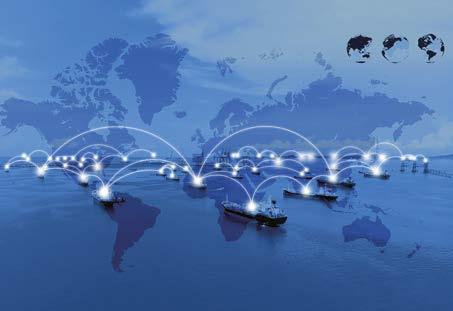
29 106 November/December 2023 Ship Management International How I Work
Connected
Star
Systems helps organisations track
manage their physical assets worldwide
Knowledge sharing - STAR is ensuring transfer of know-howacross the entire company
-
Information
and
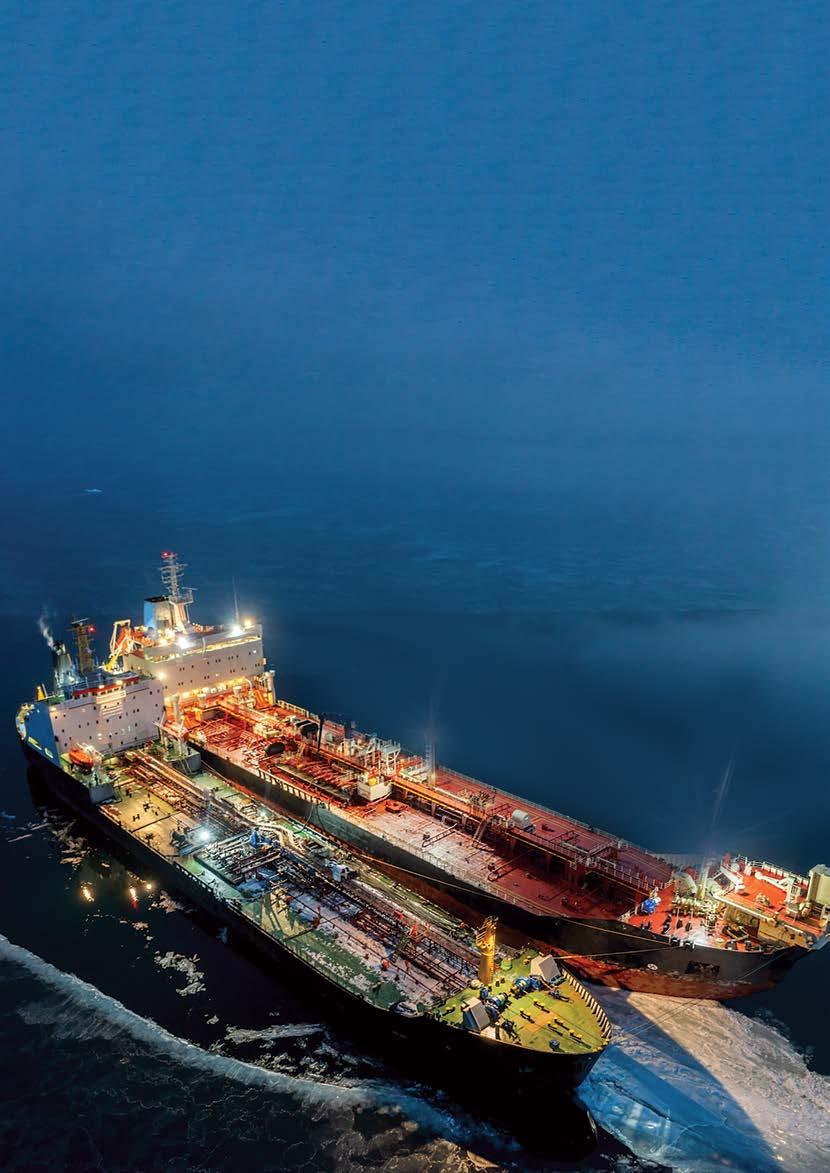
P&I and Law Combatting evasion of maritime sanctions
A new era of sanctions compliance challenges has arisen in recent years, along with a notable increase in deceptive shipping practices (DSPs), particularly in the form of AIS spoofing and dark fleet activity. Noyonika Bhaduri, CMO at Pole Star, in conjunction with Blackstone Compliance research, explains how it is possible to comprehend, detect and mitigate these practices.

The implementation of Russia-related sanctions and a price cap on the sale of Russian oil and petroleum products has led threat actors to turn towards more sophisticated forms of sanctions evasion. Their aim is to deceive authorities and financial crime compliance programs via the creation of a shadow economy that operates outside of the confines of US, UK, EU, and G-7 law.
Sanctions targets require access to allied countries’ markets, including commodities traders, financial institutions, flag registries, and ship charterers (‘covered persons’) – all of whom have compliance obligations, including those relating to the price cap on Russian oil.
The Office of Foreign Assets Control (OFAC) and other sanctions authorities have outlined an attestation process to document that Russian oil sales are within the Price Cap. However, this is not a mere record-keeping problem. The current price cap for oil leaves very little room for margin, meaning threat actors may attempt to falsify documentation, pass goods off as being of non-Russian origin, or violate other sanctions outside the Price Cap - such as acting on behalf of a blocked party or attempting to export oil to an allied country.
30 Ship Management International Issue 106 November/December 2023
The authorities have therefore warned covered persons to be aware of evasion attempts. For instance, in April, OFAC singled out P&I clubs, ship owners, flag registries, and commodities brokers to remain vigilant for DSPs as evidence of sanctions evasion.
In addition, the UK’s National Crime Agency has warned the wider financial community that sanctions targets may use proxies and enablers to gain access to the financial system - access they would otherwise be denied. This advice is equally applicable to the maritime industry.
Dark fleet activity
There are two primary methods emerging for sanctions evasion: the ‘dark fleet’ and ‘AIS spoofing’.
The dark fleet is a fleet of tankers owned and operated by persons outside of allied jurisdictions. These tankers – estimated to number around 600 vessels globally - are acquired for trading with Russia or other sanctioned countries. Owners will go to great lengths to disguise their stakes in these vessels.
That said, dark fleet vessels are not used exclusively for sanctioned trade – and not all vessels will therefore present the same level of risk. For instance, they may be shipping oil within the confines of the Price Cap. However, they do present an increased risk to covered persons. Covered persons should therefore proceed cautiously when dealing with a dark fleet vessel and conduct enhanced due diligence on the provenance of the cargo, the buyer and the seller.
Determining whether a vessel is part of the dark fleet is a subjective process. A number of criteria and factors must be considered before a ship can be categorised:
• Ownership: A vessel’s owner may be tied directly to Russia, Iran, or Venezuela. Likewise, threat actors may attempt to obfuscate their interest by owning the vessel through shell or front companies, or by making rapid changes to a vessel’s declared owners and operators.
• Movement: Dark fleet vessels may frequent Russian or sanctioned ports with deliveries to non-allied countries, and/or conduct ship-to-ship transfers in known high-risk zones, such as those used off the coast of Greece.
• Deceptive Practices: Consideration for vessels who engage in AIS spoofing or who opportunistically turn off their AIS transponder with the intent of avoiding sanctions.
• Timing: The timing of a vessel’s ownership change may indicate an intent to evade sanctions. For instance, moving vessels to new owners directly after the Russian price cap was passed. Likewise, if a vessel makes its first voyage – or routinely makes the same voyages – to Russia or a sanctioned country, this may indicate the vessel was purchased for sanctioned trade.
• Fleet coordination: Consideration of a vessel’s changes in conjunction with other vessels owned or operated by the same person. If a fleet of vessels change their flag simultaneously or incorporate into a new high-risk jurisdiction, this may signal that the owner and operators intend to misuse the vessel.
Finally, covered persons should also be aware of the increase in pop-up P&I clubs, outside of the recognised International Group consortium. Thorough and intensified due diligence on the vessel’s owner, operator, or charterer, as well as the source of the cargo, is recommended.
AIS spoofing
Spoofing was once considered a minor part of maritime sanctions evasion, but in the past six months, the practice has surged ahead to become the predominant form of evasion – at least for vessels carrying high-value cargoes such as oil and petroleum products.
In the past, high-risk countries would simply prohibit the export of AIS data, and compliance officers denied access to AIS information. These gaps in AIS coverage were easy to spot. In reaction, there’s been a major shift toward deceptive strategies, which is the provision of false AIS information. That is, inaccurate positional and navigation data is given, making a vessel appear where it is not.
This presents a far more difficult problem for the maritime community to tackle because threat actors have access to a broader range of spoofing techniques, and maritime intelligence firms will need to keep up with those tactics to counter them. OFAC recommends insurers, flag registries, and ship managers turn to “maritime intelligence services to improve detection of AIS manipulation”.
False AIS data can be uploaded through a variety of means and can be targeted towards individual AIS ground stations and data providers, or through radio frequency broadcasts targeting satellites.
31 106 November/December 2023 Ship Management International P&I and Law
Typically, an AIS position is broadcast from a vessel’s transponder, which is then received by either a terrestrial ground station (T-AIS) or an overhead satellite (S-AIS). This information is then transmitted digitally – such as through an API – to either an AIS aggregator or directly to a maritime intelligence provider.
A threat actor can insert its false data at any point in this chain. Yet, with the right security protocols or an automated ability, receiving sources can discriminate between valid and invalid transponders.
In general, spoofing can be categorised into four typologies, each having distinct signatures:
• ‘Anchor spoofing’ simulates the vessel remaining in the same place for impractical amounts of time. The vessel may appear to be at anchor or may look like offshore storage. However, a review of the vessel’s signal activity or use of human or imagery sources allows us to confirm that it is not the transmitted location.
• ‘Circle spoofing’ describes a situation where the vessel moves in geometric circles at a set location. Circle spoofing is generally used closer to shores and ports over a few days to a week - which is enough time to visit a sanctioned port and return to the station.
• ‘Slow roll spoofing’ is when the vessel pretends to be moving in a general direction of travel at very slow speeds.
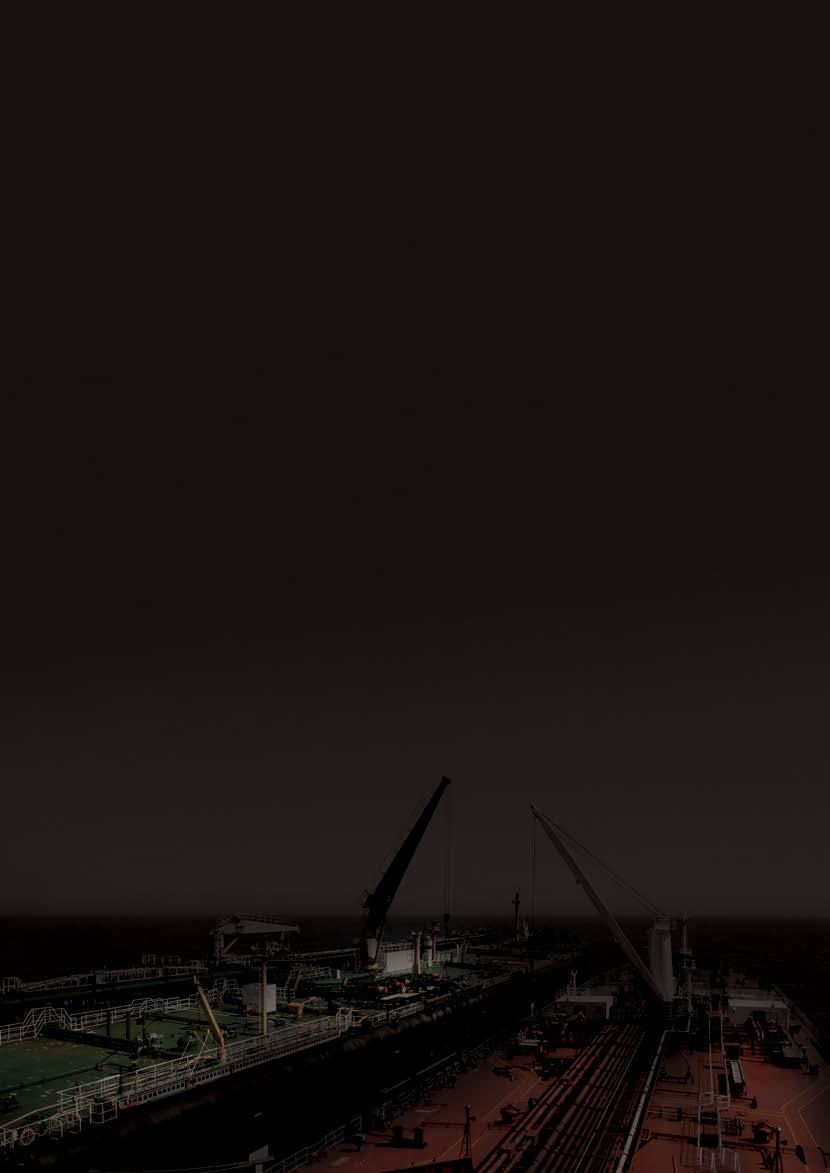
This movement will lack an economic purpose and/or be inconsistent with local traffic patterns.
• ‘Pre-programmed route spoofing’ is the most realistic technique used. The vessel is programmed to travel along feasible routes. This requires either duplicating or sourcing past AIS data to successfully mimic the vessel’s movements, or more careful planning is used to ensure that the route appears to have an economic purpose. This methodology is hardly infallible but is difficult to identify based on a visual inspection of the underlying data.
In conclusion, the threat of maritime sanctions evasion has increased tremendously over the past year. We are now seeing the wholesale creation of fleets for side-stepping allied sanctions, a drastic increase in AIS spoofing and more complex forms of maritime sanctions evasion.
With the threat environment only likely to increase; the onus is on covered persons and those involved in sanctions enforcement to conduct enhanced due diligence on all transactions involving potential dark fleet vessels and eschew – if possible – transactions involving the highest risk fleets, jurisdictions, flags, and classification societies. Working in partnership with providers of maritime intelligence services will be key to ensuring the most up-to-date data is used as part of this due diligence. l

P&I and Law
Ship Management International Issue 106 November/December 2023

Dispatches
EU ETS enters into force
There’s been a lot of scaremongering and speculating air as the European Union’s Emissions Trading System (ETS) becomes applicable to the shipping industry from January 2024. Felicity Landon navigates some of the complexities.

Exaggeration and exasperation are in plentiful supply over the entry into force of the EU Emissions Trading System (ETS) from January 2024. And while many of these dramas will not come to pass, some bizarre fallout is indeed likely to take place.
In terms of unintended consequences, there were fears of a dramatic defection by container lines from EU transhipment hubs to hubs just outside the EU bypassing the southern EU ports in the Med – or at least a reordering of port calls so the main part of the voyage would be between two non-EU ports. These concerns were addressed (or partly deflected) when the European Commission set out criteria in November which designated Tanger Med and East Port Said as official neighbouring container transhipment ports and therefore included in the ETS regime. But should we be watching (as an example) post-Brexit Felixstowe for signs of higher transhipment volumes for EU-destined cargoes? Some say so.
And then there is the money. Contrary to the suggestion that all ETS charges will pour straight into EU coffers, in fact there are random national winners here. Cyprus, Greece, Germany and the Netherlands – more of which later.
To recap, from January 2024, the EU ETS will cover CO2 emissions from vessels of 5,000 gt and above entering EU ports, regardless of flag. Emissions data must
be recorded, verified and reported for every ship calling at an EU port from 1 January; EU Allowances (EUAs), or carbon credits, must be purchased and surrendered for these. The first bills must be settled by 30 September 2025, the deadline to submit the first ETS allowances for emissions reported in 2024.
Not all emissions are equal. Shipping companies must purchase EUAs for 100% of emissions from voyages between EU ports or for ships docked at an EU port; for voyages between an EU and non-EU port, it’s 50%.
The system is being phased in: in 2025, 40% of emissions reported for 2024 must be covered by EUAs; in 2026, it’s 70% of 2025 reported emissions; and in 2027 and beyond, it’s 100%.
Shipping companies must put in place admin systems to track CO2 and other emissions, determine the volume of EUAs needed to cover these emissions, and assign the cost of the EUAs to stakeholders in order to manage their liabilities.
The uncertainty and complexity is compounded by the fact that EUAs are traded on the free market and therefore subject to price volatility.
PASSING ON THE COST
The ETS is not new. It was introduced in 2005 and already covers power stations, chemical plants, airlines
34 Ship Management International Issue 106 November/December 2023
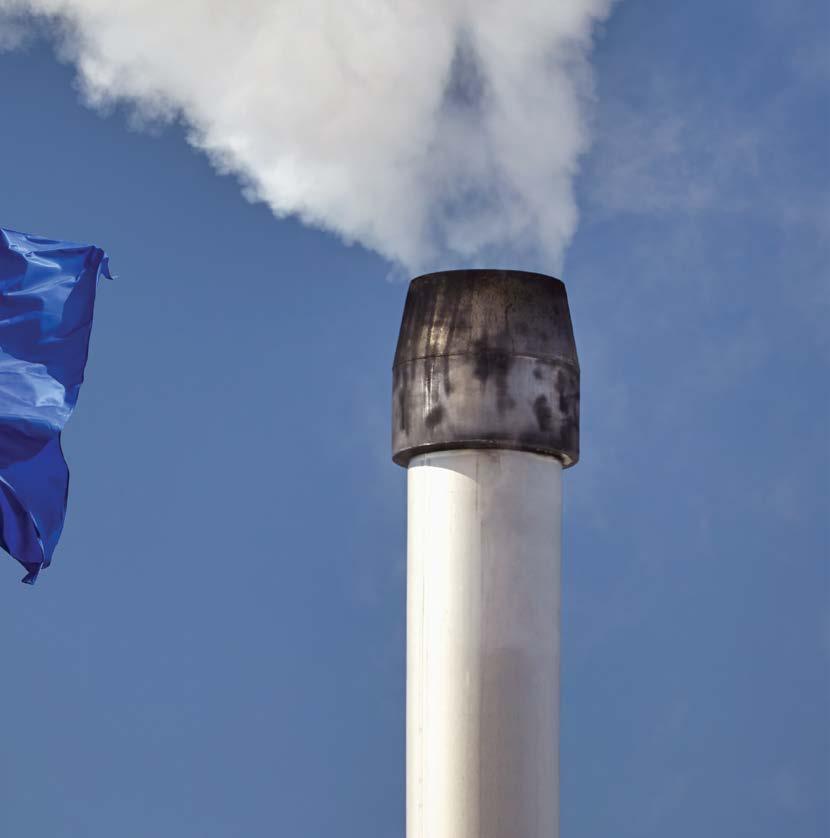
and other sectors. It’s well established, tried and tested. Now ship owners and operators must also comply. It’s time to pay for their carbon… and the costs will be passed on.
‘Esteemed customers’ have been receiving notices from shipping lines of new charges to cover the ETS dues.
For example, Evergreen published a range of ETS surcharges according to trade route and dry/reefer box, ranging from €9 to €53 per teu, with the Asia-Europe bill being €27 (dry box) or €41 (reefer) per teu. CMA CGM has indicated a €25 per teu surcharge for Asia-Europe. Maersk has predicted as much as €70 per teu; HapagLloyd has quoted €12 per teu. Project/heavy lift carrier AAL announced it would calculate an ETS surcharge based on estimated/actual voyage emissions, quoting this separately from normal freight rates. Analyst Alphaliner has noted: “It remains to be seen if the surcharge will be used by lines as a competitive tool.”
Is the industry prepared?

Martin Crawford-Brunt, CEO at Lookout Maritime and Decarbonisation Lead at the Baltic Exchange, said: “My reflections are that the shipping industry is very unprepared in general for the ETS. There are two very distinct groups;
at one end of the spectrum, large trading companies/ cargo interests that have been doing this for some time and understand carbon pricing, who are well prepared and looking to minimise the cost of exposure; and at the other end, companies in Japan and the Middle East who haven’t heard of it, or are only scrabbling around trying to understand how it works. Between these two extremes, you have shipbrokers trying to help, you’ve got carbon specialist companies trying to offer support. I don’t think it’s going to be a very smooth entry.”

At a press day in London at end-November (2023), Albrecht Grell, managing director of OceanScore, which offers an ETS management solution, gave his views on the challenges, alongside Matthias Blöte, Director Finance, Controlling & Corporate Development at Peter Dohle Schiffahrts, which is working with OceanScore.
COMPLEX FRAMEWORK
Blöte described ETS as ‘the challenge of the day’ and pointed out: “We have a vessel starting its

Dispatches 35 106 November/December 2023 Ship Management International
voyage today which will run into next year, so we already need to think about this today. It is a relatively complex framework which you need to understand, first of all. We have the ability to understand complex structures but still it is a new kind of dimension. We need to ensure we comply with the processes in all departments, including technical and commercial, and we need to make sure we have the right data.”
However, he said, despite discussions, workshops, training and preparation, “there are still a lot of uncertainties in the regulation itself, as some member states are waiting for exemptions and some member states have not ratified the directive”.
Add that to the complexity of an international shipping company – some vessels trading in the EU, some not; different ownership structures and charterers – and the challenges are considerable. “Have we done everything we could? Yes, we have tried. And we wait for the regulators to do the rest.”
The EU regulation has to be translated into national law and that has not happened in most cases, said Grell. “It isn’t necessarily a legal issue but it feels much better if you know the laws of your country protect you. There is a complex legal structure behind it. It is all doable but how much money do you want to spend on lawyers?”
At the time of writing, how many charter parties had been agreed that take in an ETS clause? Not the majority, he said.
But overall: “It is always easy to moan that shipping isn’t ready but in this case it isn’t shipping’s fault.”
The container ship sector is the most exposed, likely to be liable for 28% of the total EUAs required by the industry, said Grell. That’s because of the vessels’ size and speed. However, the most expensive according to vessel type will be ro-pax and cruise ships. “Cruise ships have a huge consumption, €500,000 per average vessel and up to £12 million for the highest cost.”
It’s estimated that 40% of EUAs will be provided by nonEuropean owners or managers, with China and Singapore both high payers, he noted.
WHERE WILL THE MONEY GO?
Whichever way you look at it, shipping companies are facing significant financial exposure from the introduction of the ETS, said Grell, and this will be further fuelled by carbon price volatility and the threat of fines for non-compliance. “The bill will be substantial,” he added, suggesting it could equate to €6.5 billion annually by the time of full implementation in 2026 based on current prices.
And so to the proceeds of the ETS. Ten per cent of the total will go to an EU fund for sustainability projects for shipping. Ten per cent goes into the EU’s social fund, for distribution. The rest – 80% – goes straight into national state coffers, based on some complex workouts. First, the money is allocated according to where the shipowner is based in the EU or where the manager responsible for ETA compliance is domiciled. Second, if the owner/manager is outside the EU, the funds go to the state according to which port the vessel has made the most port calls at in the past five years. The Netherlands looks like a strong winner here. There might be an incentive for states to attract more calls to a particular port in the hope of bringing in more money for the treasury, Grell agreed.
Meanwhile: “Cyprus wins because it is a very strong shipowning country. Also, if a shipmanager runs the scheme for you, the charterer has to surrender the EUAs where the manager is domiciled. Of the 80% of receipts, the biggest recipients will be Greece and Germany and the biggest surprise winners will be the Netherlands and Cyprus.”
Demonstrating compliance with the EU ETS is important but many people are missing an important risk factor, said Crawford-Brunt – “the reputational risk of being associated with counterparties that don’t conform”.
In addition, as pointed out by Jason Clausen, performance director at NAVTOR, the ETS is based on a cap-and-trade principle, which limits the amount of GHG emissions in the system, ensuring shipping or other companies can’t just ‘buy themselves out of trouble’ by paying for ever-increasing pollution. “Over time the cap will be reduced, with the cost of allowances rising,” he said. In other words, shipping will have to compete for EUAs even as their availability is to be reduced.
Clausen also noted: “It’s not vessel ownership that matters when it comes to paying for allowances [EUAs], but rather which party provides and pays for fuel. Owners therefore need to ensure they deliver reliable, validated vessel emissions data to charterers in a timely manner. But, to do that, we come back to the need to have a robust, reliable, real-time monitoring and management system.”
It is going to be an ‘expensive and risky environment’, said Albrecht Grell. “Every manager and owner will need to make sure they are not left to procure EUAs that the vessel’s operator should have provided. That is the number one risk to mitigate.” l
Dispatches 36 Ship Management International Issue 106 November/December 2023
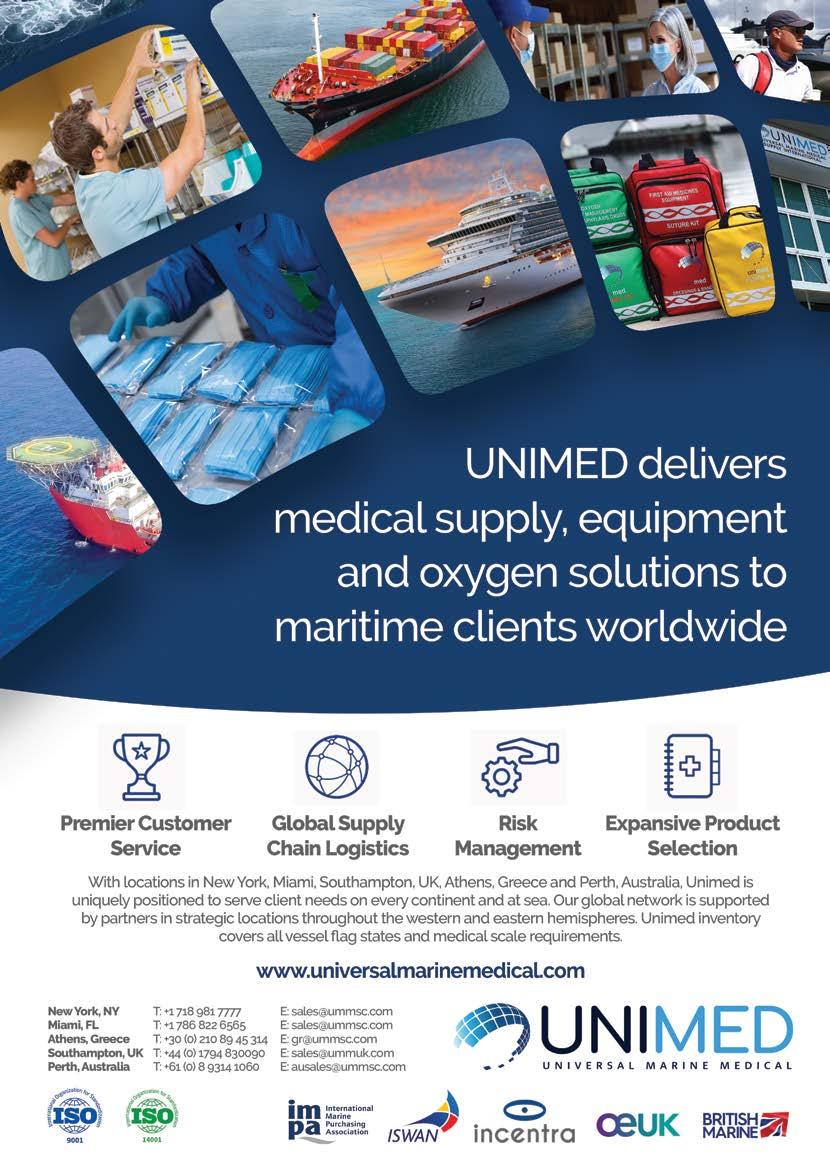
Europe’s road to decarbonisation will
be imperfect,
but crucial for global shipping
By Harriet Robson, UK Director, Transparensea


As Europe’s maritime industry takes its first steps into the EU ETS era, we will see a patchwork of fuels and technologies emerge. Limited fuel availability means that the situation will be imperfect, but it doesn’t mean that companies can’t make the transition work for their fleets and operations. Their experience will be watched closely, helping set the tone and direction for shipping’s decarbonisation globally.
A fundamental truth of shipping’s decarbonisation transition, in Europe and elsewhere, is that it will inevitably not be perfect. Supplies of purely green marine fuels will remain scarce for a significant time to come, and we will need to overcome technical and supply challenges before we can get new fuels on board ships at any meaningful scale.
Recognising this shouldn’t discourage action but should spark transparent conversations in the industry to help inform the way forward. EU regulation clearly incentivises the shipping industry to reduce its greenhouse gas emissions in the short term. Following the expansion of the EU Emissions Trading System (ETS) to the maritime sector, companies will have to pay for their ships’ carbon emissions from 2024, while FuelEU Maritime will introduce requirements on the emission intensity of the energy used on board ships from 2025.
For a number of shipowners, compliance will be achieved through one-off bunkering’s, often with partial volumes, mass balancing and carbon offsets – which do not always reflect the full picture from well to wake. This will be reality for the foreseeable future. As DNV’s latest Maritime Forecast to 2050 highlights, shipping would need 30%
to 40% of the estimated global supply of carbon-neutral fuels to meet the expected demand by 2030 in line with the IMO’s current GHG strategy – and this is not counting competition with other industries for access to those fuels.
Moving away from a single-fuel era will add new levels of complexity to the process of bunkering ships, and we can expect potential compatibility issues until there is standardization. A unified approach to the development of fuel specifications will be key to compliance with emissions reporting, but there is a lot of work to be done before we have the necessary benchmarks.
With any fuel, owners and operators will need assurances that it is not only safe to handle, but also that its origin doesn’t inadvertently compromise its sustainability credentials or those of their customers. Traceability will take on a new level of significance and will be essential for accurately reporting on the well to wake emissions required by FuelEU.
As a patchwork of fuel and technology options emerge in Europe, there is an opportunity for shipowners to carve their own - albeit bumpy - pathway to decarbonization, in a way that is tailored to the individual needs of their fleets and operations. This will be a steep learning curve, putting even more importance on the capacity to get expert, independent insight as the realities of physical fuel supplies evolve constantly.
The lessons learned from their implementation will bring better understanding for the broader decarbonization transition not just in Europe, but around the globe. This will be a transition from “wait and see” to “try, learn and try again, but better”. l
Dispatches 38 Ship Management International Issue 106 November/December 2023


Creating a Culture of Care Onboard for our Seafarers Navigating Wellness
The latest in our series of industry debates, SMI teamed up with VIKAND medical group to debate the issue of ‘Seafarer Wellbeing: Creating a Culture of Care Onboard’, looking at strategies for fostering mental health awareness and ways to improve the onboard living and working environment, including how to encourage and support social interaction among crew members, methods to improve internet connectivity and communication with family and friends, and how to ensure access to comprehensive healthcare services.
Moderated by Sean Moloney, CEO of Elaborate Communications, the panellists included: Ronald Spithout – Managing Director for VIKAND’s proactive total healthcare solution, OneHealth; Johan Gustafsson – Chief Revenue Officer, Ocean Tehnologies Group (OTG); Chris Bhatt, Chief Commercial Officer, Aon; Lorraine Hager, Loss Prevention and Marketing Advisor, The Swedish Club; and Martin Hedman, Senior Consultant and Psychologist, Marine Profile.
A video recording of the full webinar debate is available on the SMI website www.shipmanagementinternational.com
Ship Management International Issue 106 November/December 2023

Sean Moloney
Hello everybody and welcome to the lates Ship Management International webinar, for which many thanks to VIKAND for their support. We’ll be talking about the issue of creating a culture of care onboard for our seafarers and it is something that’s really important so I’m sure we have a good debate ahead. So without any further ado, I’m going to ask the panellists to introduce themselves and say a few opening words on the issue of creating a culture of care onboard and what’s important in this respect, in order to set the scene for discussing how we as an industry can improve the wellbeing, safety and mental health of our seafarers.
Lorraine Hager
Thank you very much, Sean. I’m Lorraine Hager, Loss Prevention and Marketing Advisor at the Swedish Club. I’ve been with the Club for 11 years now. I’m a proud Filipina, but I’ve been living in Sweden for the past 16 years so as I said to my colleagues here, I’ve been ‘Swedified’ for a bit. Well, we all of us bear crucial responsibility in safeguarding the physical and mental health of our crews who navigate the world’s waters on our behalf, and ensuring the wellbeing of these crews requires an in-depth understanding of seafarers’ working environment, appreciation of the commercial pressures faced by operators and, of course, a knowledge of the best practice support that is available. We need to look not only the provision of adequate medical care and safe working conditions but also the need for mental health support, social integration, and access to essential amenities.
As a P&I club, we are a mutual body owned by our members, so this gives us a remit of assisting and giving guidance to our members and enabling them to give support to the crew. At the same time, we have a commitment to a wider aim of improving safety at sea for all seafarers. Our mission is twofold; firstly, we must foster a culture of prevention through rigorous training, education, and implementation of best practices. This means identifying and rectifying potential hazards before they escalate into critical situations. So we talk about loss prevention in regard to vessel casualties but the same approach must be taken with wellbeing of the most precious resource, our seafarers and secondly, and perhaps more importantly, we are committed to providing a steadfast support system that crews can rely on in times of need and this includes with access to medical
SMI Webinar


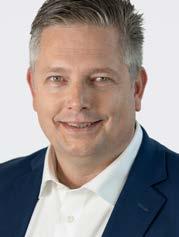

assistance and a commitment to, of course, respond to the many challenges that seafarers encounter in the course of their duties.
Just to mention, the International Group of P&I Clubs (IG) Personal Injury Committee has been discussing all of these issues and just recently gathered to discuss the subject more, also inviting charitable institutions to take part.
Sean Moloney
Thank you very much, Lorraine. Some good sort of food for thought there and good to see the industry working with the charities and with the welfare organisations. I’ve been in shipping for 40 years and still find it very strange that these important people at sea are in need of charitable assistance to the level they are. Johan, let me come on to you and ask you to introduce yourself and give your policy views on creating a culture of care.
Johan Gustafsson
Thank you, Sean and good afternoon, evening or morning, everybody. I work for a company called Ocean Technologies Group and we are providing human capital management services to our customers. In relation to what Lorraine just said, I want to come to a point where we power the people that power world trade because without the individual seafarers that are out there every day, 365 days a year, 24 hours a day navigating the sea, the world would soon see the consequence on daily living conditions.
I think that the industry is still too fragmented. There are good things happening, but not in a combined measure. There are many people taking some very
good actions, but for me, it starts from the top. If we are going to create this culture of care, it needs to start from leadership and commitment. I mean, the very top people, from the CEOs down to the captains onboard.
Then the second part of this is for me, mental health and for that you need work and life balance. Just look at ourselves, if we work too much, we will also not be satisfied with our situation. So I think that is really important onboard a ship as well, because you have vessels that has five port calls in a week and I can only imagine how they manage to get through the work and rest hours demanded today.
I also think that we need to provide a comprehensive learning situation for the people onboard because training, or repetition of training, is the mother of all knowledge for me. I come from the Navy and that’s what we did, we practiced every day for something that we wish never happened. So the same thing needs to be given to the seafarers’ health and we need to make sure that this platform or the way to get the knowledge needed is available. And it’s not only training, because training is just a tick box. Learning is what we are after and that is also important. Also, mental health for me means fair wages and living conditions, so a lot is included.
I want to finish off by saying that anyone that thinks what we are discussing here today is expensive has never had an incident or an accident because the cost of that is going to be way much more than the money that you spend on this. So for me, this is not a cost, it is an investment for the future.
42 Ship Management International Issue 106 November/December 2023 SMI Webinar
Ronald Spithout
Lorraine Hager
Johan Gustafsson
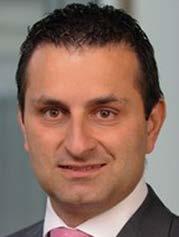


Sean Moloney
Johan, thank you very much indeed. Martin, let me come on to you. If you could introduce yourself, please, and give a little insight into your thoughts.
Martin Hedman
Sure, thank you, Sean. So my name is Martin Hedman and I’m the Head of Assessment and Organisational Management at Marine Profile. We’re a company that has conducted for more than three decades psychological solutions for the maritime industry and our focus is safety mitigation and emphasising the human factors. My background is I’m a licensed psychologist, and have been working in the maritime industry for the past 12 years, mainly conducting psychological assessment for officers and crew, for various purposes but also leadership training on a group and individual level.
Mental health is, of course, an area that’s very close to me and that I have been working on every day. In my work as a psychologist, I very often get asked the question whether or not it is possible to make changes on this level, like cultural changes.
It’s like a societal change, an industry change that we’re talking about here, and I know the first step for change is always the awareness that there is some deficit, something going that needs to be changed, and I would say the industry is at this stage on mental health at the moment. We’re having these seminars and panels and a lot of discussions now and the industry has never been more aware than it is right now, maybe because of the events we’ve been through, like the pandemic and so on. The second step of making a cultural change, as Johan was pointing out as well, is such a complex topic when
we’re changing the entire industry, it means that we have to have people aligned at all levels, not just on the ships. We should have the best tools and the services provided for the ships but they won’t be used, won’t have any impact unless we also have the entire hierarchy with us in the process. So that’s where the challenge is, as I see it, to create such an alignment and that’s what I hope this discussion today is going to be a little bit more about.
Sean Moloney
But in talking about that alignment, everybody coming into the same mode, the issue is that shipping is very fragmented and you’ve got companies that are accelerating at a fast rate and you’ve got the laggards or the slow adopters. That must create a bit of a problem when you’re trying to create this changes culture.
Martin Hedman
Exactly, and that’s the complexity of it and I think we can all break it down to time, that we have to be patient about it. It’s something that has to take its course of time and I believe that we’re going to get there. I mean, we have kept this discussion alive now for a couple of years quite intensively and we have seen a lot of progress in that and that’s why I’m very optimistic.
Sean Moloney
Thank you very much, Martin. Ronald, let me come on to you and if you can introduce yourself, please, and make a few comments non the subject under discussion.
Ronald Spithout
Thank you very much, Sean. My name is Ronald Spithout, I’m the Managing Director for One Health at VIKAND. For many years, I have been providing satellite services
SMI Webinar
Chris Bhatt
Martin Hedman

around the world for various companies, where the central theme always was what to do with that satellite connectivity, because connectivity in itself is not solving any problems, it t’s what you can do with it, the application, that is solving problems. In that way, I ended speaking with Peter Hult, the owner of VIKAND, which is a pretty large organisation with many hundreds of doctors, originating from the cruise industry where they provide doctors, nurses, infirmary medicines, x-ray machines onboard of cruise vessels. We met to see if we could use technology to provide a similar type of service on a commercial vessel. That may sound insane because there are only 20, 25 people on a commercial vessel, so you can’t place a doctor there permanently, but you could place the digital equivalent of the doctor over there and that’s what we have been building over the last few years.
The industry seems to be at a turning point talking about crew welfare and wellness and health onboard of vessels, probably in the aftermath of the Covid period where suddenly it became clear that we are depending on the welfare of the people onboard. But not a lot is happening in practice, there’s not a lot being done to keep people healthy. It’s like Johan says about learning and not training, in a similar way it’s about keeping people healthy and not just reacting when they are getting sick.
So crew healthcare should really be caring in such a way that they stay healthy. We, the healthcare and technology companies, have all the tools in our hands to provide such a healthcare so that people stay healthy but currently it’s not the case because we all know that 10,000 seafarers have to leave their job every year because of some kind of chronical illness. So we are not very good at keeping them healthy, which comes at a cost because if more and more of these experienced people are losing their jobs and younger people, who we have a problem with training and getting them up to speed, are getting onto the vessels, the risk profile is just going up. And it all comes at a cost and that’s what
we have to tackle. We have to show the industry that they are currently at a high cost level by being reactive to healthcare. And if we are reaching that turning point, and I really feel that we are getting closer, then we’re on the right way.
Sean Moloney
Thanks Ronald, some very good points there. I mean, I suppose it comes back to that point also, looking at the demographic of the seafarer, they’re getting older. And I remember talking to a ship manager a number of years ago about the importance of good food onboard ship…
Ronald Spithout
And that has a physical aspect, that has a mental aspect, as we all know, and it has also environmental aspects and there comes, well, not only the eating, but also the sleeping and the exercising and the air and the sunlight and whatever comes around the corner, and also the social aspect. So yes, I think we should tackle them all one by one under the premises that not doing it is costing money.
Sean Moloney
Let me bring in Chris here. Would you like to introduce yourself and give your perspective?
Chris Bhatt
Thanks Sean. I work for AON, a big global insurance broker. I think from the advice point of view, we sit right on the intersection between people risk, the risk associated with having employees in your business, and asset risk, the risk associated with the assets that you own. Our job, I think as much as anything else, is to keep reminding everybody of that link between people and assets, which I think often gets separated too easily within an organisation, because so many of the risk incidents onboard vessels are down to people, deliberately or otherwise.
Everyone is right saying that the industry’s fragmented, which is not unsurprising given it’s a global industry
SMI Webinar

with multiple cultures and languages, etc. But I think that when you put in place all these benefits for crew, you’ve also got to be careful about exploitation because, from a vessel owner’s perspective, you’ll also get stories of how ‘ambulance chasing’ lawyers will sit waiting on the docks for these seafarers to disembark and then encourage them to fall ill after being onshore, looking for the opportunity to either earn themselves some money or the seafarer. So you’ve got to be careful about the exploitation. I completely agree with everyone’s points around creating a better culture of health but with that comes the responsibility for putting sufficient controls in place.
Sean Moloney
Thank you very much indeed, Chris. So really, I want to come on to the first question and that’s do seafarers currently receive the level of care they deserve while at sea?
Chris Bhatt
I’d say no, the answer is they don’t get what they should get onboard. I think there’s a big disparity between shore-based employees of any description in any industry and those at sea and I think that we need to be more proactive.
Johan Gustafsson
I definitely agree that we are not giving the level of healthcare and culture onboard as we should do, never before Covid having considered seafarers a key workforce suffering from being stuck onboard ships for long periods, and now sometimes for more than a year.
So there’s a lot more that I, from my perspective, think we need to be doing, but again this is a fragmented industry with different flag states, different authorities so it’s going to be really difficult to reach some sort of global policy on this. But I think that this needs to be raised at every meeting, in every conversation like here, and next time maybe bring in a seafarer, because for me that is normally a missing part in all major conferences and seminars - that
we don’t have a seafarer themself who is on ship right now to tell us what is actually going on.
Ronald Spithout
First of all, do seafarers currently have the level of care they deserve? Well, the answer is clearly no, because I mentioned the 10,000 seafarers losing their job because physical stuff. But I also read an article pointing out that up to 12% of the deaths at sea are still due to suicide and a number of deaths at sea on commercial vessels is on average 100 to 120 per year. So if on that number, up to 12% is suicide, then you would clearly say they’re not that happy onboard of the vessels.
But speaking to the seafarer, and I spent a week in Greece last week speaking to quite a few in various workshops, if you ask them what they want, it’s not necessarily that they shorter stints or shorter shifts. I mean, if you’re very happy in what you do and the technology around you is providing you the right level of social interaction with whoever you want, then that should not be a problem in itself… but we don’t do that.
Regarding internet connectivity, the discussion needs to be a little bit smarter on what you do with that communication. You can bring tools onto the vessel to encourage social interaction, for instance, in-between the people. If you just bring internet onboard of the vessel, it’s no surprise that people are taking their iPhone and sitting in their private cabin and then… well, they get depressed. But if you’re using that same internet connectivity and put stuff on it so that you bring people together again, so that it almost becomes a family apart from your family, then the actual number of weeks that you spend at sea is a little bit less relevant.
And is there a difference between companies? Yes, of course there is. I spoke to smaller owners, operators, last week in Greece, who proudly told me that most of their people are with them for 30 years or plus, right, but there are also still larger companies who really believe that seafarers are expendable and you have everything
SMI Webinar

in between. Clearly they are not expendable. There are less and less people willing to go, not only to sea, but also to go to the maritime colleges to get trained being an officer and so you see from the numbers that the problem is building up for the next two, three, four years. So I think it’s time for action, as I said, on all kind of aspects.
Johan Gustafsson
And it’s not from you and me. We need to have the engagement from the seafarers, and to be honest, we have not really made a good commercial [advert] for the shipping industry over the last couple of years, especially during Covid.
Sean Moloney
Lorraine, let me bring you in on this. I think at the bottom of all this, it’s talking about reducing accidents, reducing suicides, reducing areas of fatigue onboard because seafarers are overworked and they’re going in their cabins and they’re texting for hours to their loved ones and not getting any sleep and things like that because they’re depressed. But from a P&I and loss prevention perspective, what are the owners, your members starting to think about this? Are they starting to understand that they need to actually take action as an industry?
Lorraine Hager
Well, most of the members are actually doing something for their seafarers as well, for the mental wellbeing or for the wellbeing of the seafarers. And even the industry, the IG Group, as I mentioned is also doing something for the seafarers with the Personal Injury Committee just having had a seminar last month and they are furthering this discussion. So I think that since the pandemic, a lot of the shipowners are focusing on the wellbeing of the seafarers but it’s just fragmented and, as we’ve said, it’s time to collaborate and maybe work together to make a ripple effect, because we all have the same goal to have our seafarers healthy, in mind, body and soul.
Chris Bhatt
Yes, I was only going to say that what’s interesting is that the shipping companies will often turn to the P&I clubs for everything that isn’t standard. But there is nothing like the P&I club in any other industry and I think that’s probably where we’ve got to be a little bit more disruptive, we’ve got to get people’s minds away from automatically relying on the poor P&I clubs all the time, or we equip the P&I clubs to sufficiently deal with it, one or the other.
Sean Moloney
I think I’m going to bring Martin in on this, Martin, you talked about creating awareness and acknowledging that there is a problem here but from a psychologist’s point of view, how do you see this?
Martin Hedman
Well, we’re talking about care and how we can increase the care onboard the ships and for our seafarers and care doesn’t just come in terms of services and tools and trainings and so on, it’s also about how we treat each other. And then it comes down to leadership, how we communicate, how we treat each other through talking. And what I encounter when I talk with a lot of seafarers who are in distress for some reason or having a problem on the ships, it’s normally triggered by not being treated in a good manner, which is also a very important aspect of it. Not just the isolation and all of these other aspects [of life at sea] but just having people show good attitudes is something that provides a lot of care in the longer perspective, make people more motivated and enthusiastic about their work, instead of trying to get off as soon as possible and being even more isolated and using the connectivity, as Ronald put it, to go in the room instead of socialising and being out. It’s because they feel they’re being treated in a bad way.
I get the feedback and feeling sometimes that on ship it’s more what you say rather than how you say it and that, for me, is still a little bit old school. If we take it one step higher, it about trust in psychological matters.
SMI Webinar

I get comments sometimes that, from industry leaders, that I don’t believe in psychology and that surprises me. The industry is fragmented and it’s a question of where we go in. On some ships, we need leadership training and awareness training there, while on some others, we have the P&I clubs and the discussion on that level in a different area.
Ronald Spithout.
Yes, so you see now initiatives of vetting agencies who are suddenly putting all kinds of questions in their questionnaire about whether the crew or officers have had mental first aid or awareness programmes. So it can come from anywhere but eventually I think you will create a better atmosphere onboard as well because the people are better fit to deal with it.
Chris Bhatt
I think also, to your point Martin, you’re right, you’ve got to create the leadership culture but we must also not forget that some of the loneliest people onboard a vessel are the senior crew.
Sean Moloney
Well, look, let me, we’ve been getting some questions coming in. One is to the effect how can maritime charities like Stella Maris work more closely with the maritime industry to support seafarers?
Lorraine Hager
With the case of the Stella Maris where they send priests onboard the vessels, I think for the mental wellbeing of the seafarers who are Christians this is very helpful. It contributes to the whole thing of achieving the desired result and, of course, we are open for collaboration and maybe doing a project together for seafarers.
Sean Moloney
At London International Shipping Week we saw the charities coming together and really identifying some of the issues there. In whole issue of ESG (Environmental, Social and Governance), how
important is the ‘S’ is and as far as seafarers are concerned that’s always the key one.
Ronald Spithout
Well you mentioned ESG, Sean, but if over the last years the ESG discussion was mainly focused around the E and how to comply with tightening fuel regulations, you have to look very hard into the annual statements of any shipping company to find the social chapter on how they invested in their crew over the over the periods, right? So I think we should focus on the S of ESG not only in the reports but as I said also, for instance, on the vetting side. It became an accelerator a couple of years ago already in the discussion when it became clear that an environmental friendlier vessel was breaking into the P&L of the ship operator, and I think in a similar way, a more social engaged shipping operator should find similar benefits in his P&L, not only on the cost side but also on the revenue side. So I’m a firm believer that we should have some health-related checklists as part of a vetting operation.
Sean Moloney
Well, ladies and gentlemen, thank you very much indeed for your time today. I think this is probably one of the best debates we’ve had and I’d like to thank all our panellists. When you’ve got a good group of people to talk and to share ideas, it certainly makes my job an awful lot easier, and I look forward to seeing and speaking with you all again very soon.
Thank you also to our audience and please don’t forget that a full recording of this entire debate is available on our website www.shipmanagementinternational.com l
SMI Webinar
Scan QR code to watch Webinar
VIKING changes shape of the lifeboat market
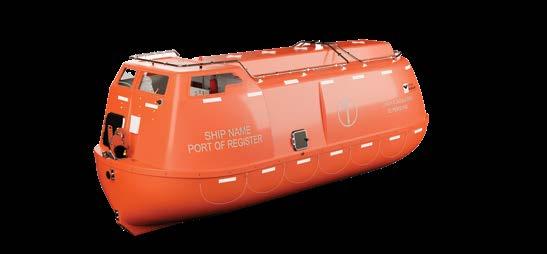
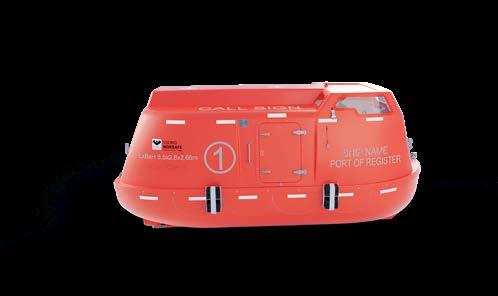
Maritime safety solutions provider VIKING LifeSaving Equipment is launching an innovative range of lifeboats and davits which it says set new standards for compact and lightweight lifeboat-based evacuation solutions. By challenging traditional lifeboat design, the 40- and 52-person VIKING Norsafe Totally Enclosed Lifeboats (TELB) respond to a rising tide of industry demand for space- and weight-saving boats for typical crew capacities.
Major shipbuilding clients have requested alternative concepts for vessel types - especially for Offshore Service Operation vessels (SOV) - where onboard space is at a premium and space for the lifeboat and davit installation must be optimised. VIKING’s response is the ‘VNJY’ range of lifeboats, (pictured) which feature a minimal deck footprint, while optimizing capacity and
serviceability. In addition, the VNJY features a shorter and wider hull than usual and incorporates an innovative forward steering position that allows for additional space on board.
Using significantly less materials in manufacturing, the new VNJY lifeboats also deliver lower height and weight (up to 400 kg lighter) and are designed to achieve a reduced carbon footprint compared to previous models. The lower weight also reduces loads and the required capacities for the gravity- or hydraulic-powered davits used to launch and recover lifeboats.
The design is certified by DNV to meet SOLAS and LSA requirements. First deliveries, due in Second Quarter 2024, will feature on vessels whose flag states require EU Marine Equipment Directive verification or USCG certification. On the logistics side, two VNJY lifeboats can be shipped
VIKING Norsafe VNJY-68 TELB
48 Ship Management International Issue 106 November/December 2023
on a single 40 ft flat rack, benefiting convenience for VIKING’s global customer base.
“VIKING Norsafe lifeboats are built to last, which is one reason we have taken so much care over what is truly a step change for lifeboat design after over 20 years of continuous orders for our popular JYN range,” says Thomas Thompson, VIKING Technical Director, Boats & Davits.
“Some customers will continue to prefer designs that have served them so well, but VNJY lifeboats offer the space-saving, lightweight solution others have been hoping for. Operators will also appreciate the way the steering position improves visibility, and the stability gains brought by extra width.”
Manufactured in a modular design, the VNJY is easy to adapt to new sizes and requires reduced maintenance efforts. Serviceability has been further enhanced by the smart placement of engines and the hydrostatic release for on-load release hooks. For boats installed where hydrocarbons are present and fire protection is necessary, the new range will come complete with a compressed air system and external seawater deluge.
“The extensive work VIKING has completed to optimise the new lifeboat range is based on the years of experience available to our team of naval architects and boat-builders, from preliminary design to full prototype testing,” Thompson concludes.
VIKING is a privately held corporation, founded in 1960. In recent years, VIKING acquired the Norwegian company Norsafe, whose lifeboats have been used around the world since 1904, and Drew Marine’s FSR division, one of the world’s three largest providers of Marine Fire Service. Headquartered in Esbjerg, Denmark, VIKING products are manufactured in Denmark, Norway, Bulgaria, Greece, China, and Thailand. l
Survitec demonstrates Seahaven advantages for cruise customers

The global cruise industry in early November convened at the Port of Belfast, the home of the historic Harland & Wolff shipyard, and world-famous Titanic Belfast Museum, to witness the successful demonstration of Survitec’s Seahaven, the world’s largest inflatable lifeboat.
In welcoming representatives of the international cruise ship industry, Survitec CEO Robert Kledal said: “Since we introduced Seahaven in Miami in April 2022, the industry conversation has been inspiring. It signals a new era of potential for the passenger industry.”
Mr Kledal furthered: “The development of Seahaven has been one of the most exciting journeys for us at Survitec. It builds on our pioneering history, allowing cruise owners and operators to explore a wide range of vessel design possibilities.
“I take pride in presenting Seahaven to you, and I encourage you to seize the opportunity to experience the remarkable potential of Seahaven,” he said.
Born from the extensive collaboration between Survitec’s aerospace, defence and maritime divisions and a 100-year plus history of pioneering Survival Technology, the two-lifeboat Seahaven system is deployed at the touch of a button in under 4 minutes with the ability to evacuate up to 1,060 passengers in under 22 minutes.
Seahaven, which replaces conventional lifeboats and davits, can free up to 85% of deck space, creating opportunities for revenue generation for cruise operators. “We are rewriting what’s possible in terms of safety, reliability, and deck footprint in one revolutionary product,” Kledal told cruise industry leaders.
In April last year Survitec teamed up with Norwegian Cruise Line Holdings Ltd. (NCLH), Independent Maritime Advisors Ltd, and a major shipbuilder to deliver a cruise ship design that incorporates Seahaven as the primary means of evacuation.
Developing new Survival Technology, such as Seahaven, is a meticulous process. From initial concept, through research and design, rigorous testing, where Seahaven surpassed the minimum regulatory requirements, to successful heavy weather sea trials and type class approvals, has taken more than five years and a dedicated team of more than 30 engineers. l
Maritime Safety 49 106 November/December 2023 Ship Management International
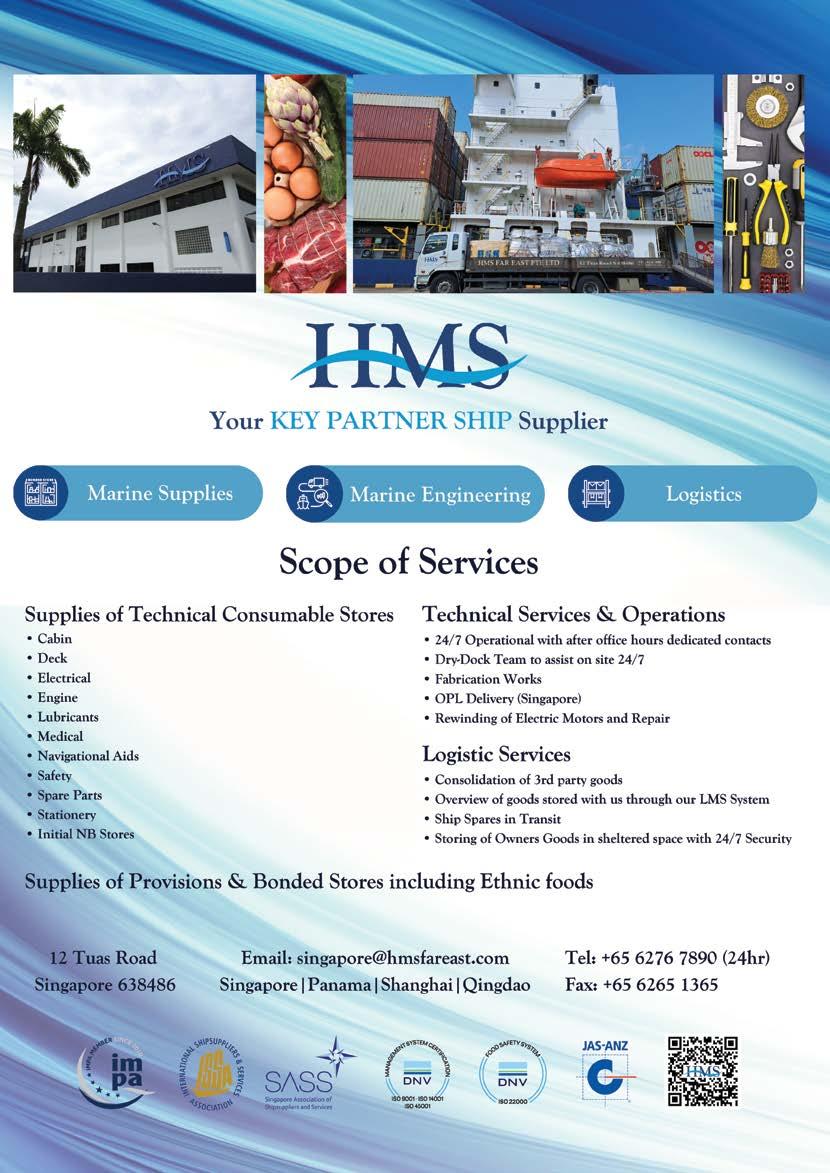
Regional Focus
Compelling credentials
The many advantages and future growth prospects of Hong Kong as a maritime hub were spelled out by various ministers of the Special Administrative Region during Hong Kong Maritime Week (HKMW) in late November.

Addressing the opening ceremony, Chief Executive Mr John Lee reminded that China’s National 14th Five-Year Plan supports Hong Kong’s role in the global maritime sector with a focus on the development of high value-added maritime services. He added that the maritime professionals in the city would contribute to “the prosperous development in Hong Kong, along the Belt & Road, and beyond.
“In the coming weeks, the Transport & Logistics Bureau will publish a detailed action plan on maritime and port development strategy,” he continued. “The plan will enhance high-end maritime services, facilitate transformation
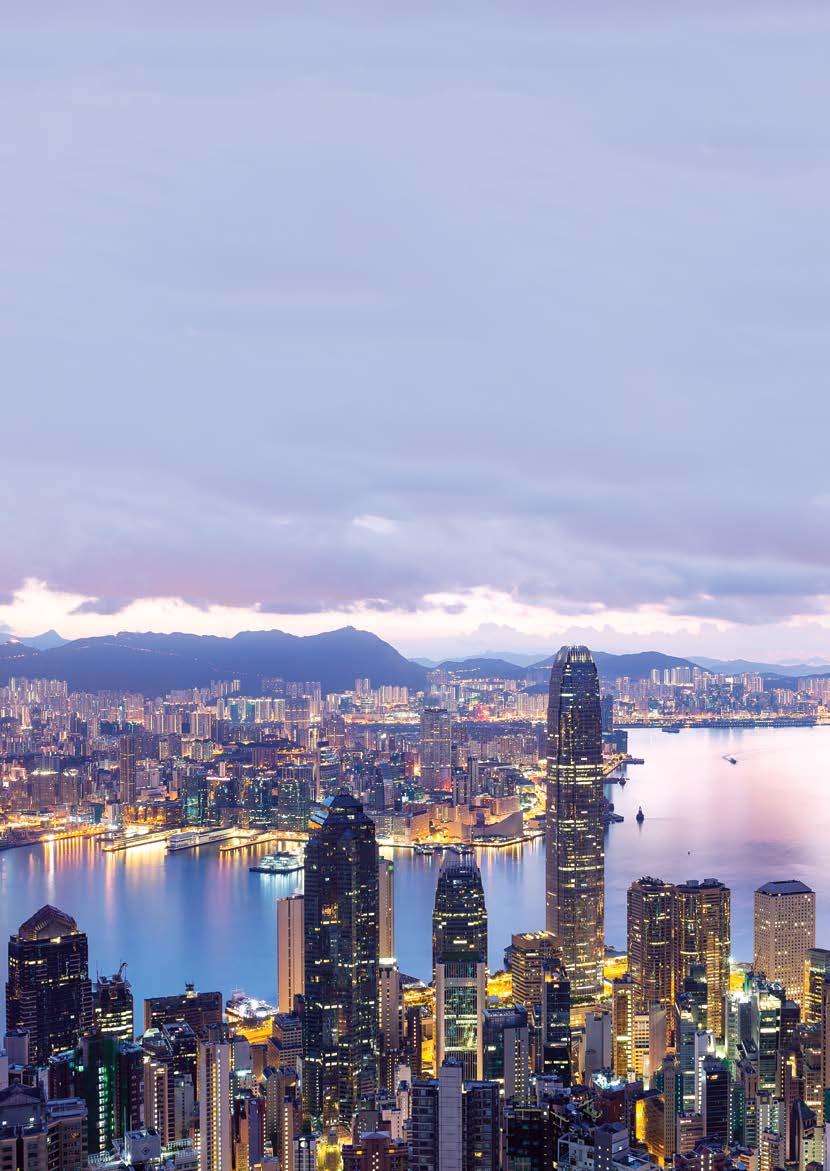
towards zero emissions, promote smart and digital initiatives in the industry, and promote global exchanges.”
Specifically, the Chief Executive mentioned that his administration was committed to decarbonisation and would “soon kick-start a feasibility study (into) providing green methanol bunkering for both local and ocean-going vessels. In the coming year, we will set out an action plan for the construction of bunkering facilities and (the) development of supply chains.”

Meanwhile, Maritime & Port Board Chairman and Secretary for Transport & Logistics Mr Lam Sai-hung said the Government will continue to give full play to Hong Kong’s distinctive advantage of being simultaneously connected to both Mainland China and the world. In this way Hong Kong could act as a “super-connector and super value-adder” in the Guangdong-Hong Kong-Macau Greater Bay Area (GBA) - also incorporating China’s third
51 106 November/December 2023 Ship Management International
Regional Focus: Hong Kong

largest city Shenzhen – adding that Hong Kong was “working closely with our peers to promote the overall competitiveness of the region.”

Speaking at the Gala Dinner of the 3rd World Maritime Merchants Forum, organised by China Merchants Group, Financial Secretary Mr Paul Chan highlighted why Hong Kong remains the preferred hub for many companies in the maritime industry to set up their regional or global headquarters.
“First, it is the institutional strengths that Hong Kong has under the “one country, two systems “ principle, which President Xi Jinping and the Central Government have reaffirmed on multiple occasions in the past year or so,” he said. “This means that the very essence of our success: in particular the common law system and the rule of law; a low and simple tax regime; free flow of goods, capital, people and information; the linked exchange rate system; alignment with the best international business standards and practice, will continue for the long term to support our status as a vibrant international trade, shipping and financial centre.
“Second, we are the top international financial centre in Asia,” he continued. “Seventy three of the top 100 global banks are operating in Hong Kong. Our stock market is the most international in Asia with a market capitalisation of over US$4.1 trillion. Green bonds issued in Hong Kong last year captured one-third of Asia’s market share. They are denominated in USD, Euro, RMB and HKD with tenure as long as 30 years. In a nutshell, the capital market here is international and vibrant, with a very deep liquidity. Hong Kong is an ideal location for you to seek ship financing.”
Third, Hong Kong can serve as your risk management centre. Here in Hong Kong, we provide convenient access to a worldclass insurance market. Eleven of the top 20 global insurance companies are operating here. And we have adopted very conducive policies and measures to develop our insurance market.
“Fourth, a prime maritime cluster across the marine value chain is emerging here, forging partnerships of actors in the clusters,” he concluded. “Currently, we have more than 1 100 port and maritime companies that stand ready to offer an array of quality maritime services, ranging from shipowning and ship finance to maritime insurance and legal services. Besides, we have also rolled out competitive tax concessions for ship leasing business. Last year, we went further to cut the profits tax rate applicable to ship agents, ship managers and ship brokers to 8.25 per cent, that is half of our standard rate. And there will be further supportive measures from the Government coming,” the Financial Secretary promised.
Further elaboration on the city’s marine insurance strengths came from Transport and Logistics Secretary Mr Lam Sai-hung, this time speaking at a seminar co-hosted by the International Union of Marine Insurance – the first time IUMI had organised an event during HKMW, itself a sign of the city’s growing importance in marine insurance terms.
“We have a flourishing marine insurance market, with more than 80 local and foreign insurance companies that offer a broad range of marine insurance products,” he said. “Over the past 10 years, gross premiums on ships, damage and liability in Hong Kong witnessed a cumulative growth of 72 per cent, amounting to over HK$3 billion (close to US$400 million) in 2022.
“Protection and indemnity (P&I) associations are active in Hong Kong. Twelve out of the 13 members of the International Group of P&I Clubs have a presence in Hong Kong, which is the largest cluster of representatives outside London. And let’s not forget the Asia Hub, established by the IUMI since 2016, which marks the organisation’s first permanent presence outside Europe.”
Mr Lam Sai-hung went on the stress how Hong Kong’s strong core of ship owners, managers and operators, together with a ship registry that is the fourth largest in the world in gross tonnage terms – with 126m gt at end2022 - was key in fuelling business prospects for all maritime business services sectors in the city, including marine insurance.
52 Ship Management International Issue 106 November/December 2023 Regional Focus: Hong Kong
To strengthen the Hong Kong Shipping Register (HKSR) further, the government is expanding its service coverage through the setting up of seven regional desks around the world, he added, and other work is underway to further enhance the services of the HKSR and explore potential new markets.
The private sector is equally important to the success of the city’s maritime cluster and its efforts are coordinated through highly proactive body the Hong Kong Shipowners Association (HKSOA), one of the world’s largest shipowner associations whose history stretches back 65 years. It currently numbers more than 180 members, representing companies owning, managing and/or operating a fleet, as well as providing professional services to the shipping industry.

During Hong Kong Maritime Week, The Caravel Group’s Chief Operating Officer, Angad Banga, also on the board of Caravel company Fleet Management Limited (FLEET), was appointed Chairman of the HKSOA, succeeding Wellington Koo of Valles Steamship Co.
In his acceptance speech, Mr Banga paid tribute to the work his predecessor, saying: “Faced with the challenges posed by the pandemic, unique local issues, and an evolving regulatory framework, Wellington’s strategic acumen and steadfast commitment have reinforced our Association and left an indelible impact on the entire maritime community in Hong Kong.
“As we continue to operate within the maritime industry, we are acutely aware of the challenges we face,” he continued. “These include a complex regulatory environment, the imperative of environmental sustainability, the urgency for digital transformation and enhanced crew welfare. These challenges should not be viewed as obstacles but as catalysts for innovation, new ideas and change.”
Under his tenure, the HKSOA would further enhance its efforts to “facilitate dialogue and cooperation, promote technological and environmental advancements, and advocate for equitable and effective policies,” the association’s new head promised. “Together, we can transform these challenges into opportunities for growth and development.”
Dr Harry Banga, Chairman and CEO of The Caravel Group, said: “I’m proud of my son, Angad, on his appointment as Chairman of the HKSOA. We have been an active member of the Association for many years, and I look forward to following its continued success under his leadership.”
Meanwhile, FLEET prepares next year (2024) to celebrate its 30th anniversarythe last 10 under Caravel ownership – with co-founder and MD Dr Kishore Rajvanshy continuously at the helm over the past three decades. During that time the company has grown to now have more than 650 ships under full technical management, over 450 of which are handled out of Hong Kong.
In July 2023, FLEET signed an important agreement with Transworld Group of the UAE
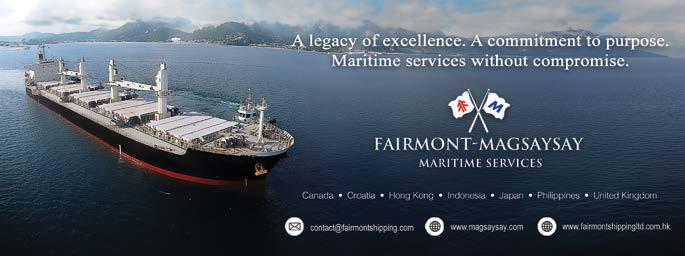

Regional Focus: Hong Kong
106 November/December 2023 Ship Management International 53

to set up a new shipmanagement joint venture, Transworld Fleet Management. The new company will provide dedicated technical management services to Transworld Group’s diversified fleet as well as to Transworld associated and affiliated vessels belonging to other shipowners in the Middle East region.
Another shipmanagement company that has been celebrating a milestone anniversary this year is Hong Kong-based Wallem Group, now completing its 120th year. Wallem was in fact founded in Shanghai and quickly moved into third party shipmanagement, becoming one of the first companies in the world to do so, when it took over running two Chinese coastal vessels.
During 2023, two dual fuel (DF) LR2 tankers built under Wallem supervision at Guangzhou Shipyard International in China were delivered to their owner Viken Shipping, immediately passing under Wallem technical and crew management. The first of these deliveries, in June, became the manager’s first DF-capable newbuilding, and other DF vessels have since entered the managed fleet or are planned to do so in 2024, underlining Wallem’s commitment to industry decarbonisation goals.

“These stateof-the-art ships are worthy additions to the Wallemmanaged fleet in our 120th anniversary year,” the group’s Shipmanagement MD Ioannis Stefanou observed. “Wallem has positioned itself at the forefront of maritime services since its formation in 1903 and always has a keen eye on adapting to industry change. Today, decarbonisation heads the sector’s agenda, and these ships embody Wallem’s continuing drive to offer expertise where it counts.”
A proud Hong Kong resident for over 40 years, ship manager Bernhard Schulte Shipmanagement (BSM) sees the
strength of HK’s maritime community lying in its depth of knowledge, diversity of experience, and an unwavering commitment to continuous change. Even as general conditions and the business environment evolves, it remains an international premier maritime centre providing extensive business opportunities in the Guangdong-Hong Kong-Macao Greater Bay Area.

Ian Beveridge, CEO of BSM, participated in the panel discussion at the 3rd World Maritime Merchants Forum, coinciding with the opening of Hong Kong Maritime Week 2023, on how to achieve high-quality development within the shipping industry in an age of upheaval.
Mr Beveridge pointed out that even though the shipping service industry faced great challenges during the pandemic, it was still able to overcome these difficulties, proving the resilience of the industry. He pointed out how shipping companies now need to focus on enriching the training and development of shipping talents, such as crew, offshore staff, and personnel in various functions as attracting, retaining, and developing talent in these different functions will be a key issue for all the shipping companies going forward.
Theophanis Theophanous, Managing Director of BSM Hellas, was invited to take part in a panel discussion on LNG vessel management and how to build global capacity and resilience for LNG shipping. With around 120 gas carriers under full and crew management, of which more than 60 are LNG carriers, BSM is the largest third-party ship manager of vessels in this segment. The company also actively invests in crew training and development in this demanding sector through its own training facilities, Maritime Training Centres (MTCs) in Cyprus, Kochi and Manila, equipped with LNG training facilities and state-of-the-art Liquid Cargo simulators. l
Regional Focus: Hong Kong
Ship Management International Issue 106 November/December 2023 54

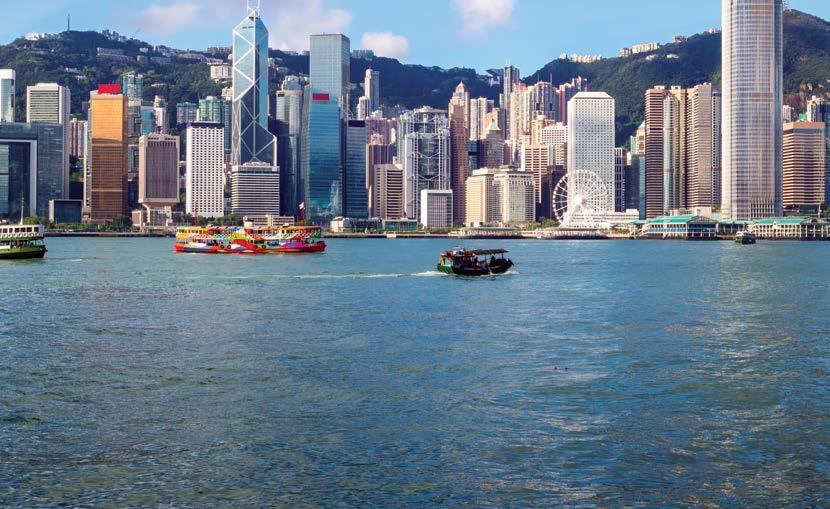
Q&A with Bjorn Hojgaard, CEO of Anglo-Eastern Univan Group
Q) What is the importance of Hong Kong within your overall Group activities?
Bjorn Hojgaard: Anglo-Eastern was founded in Hong Kong in 1974 and has been headquartered in the city since its inception. In April 2020, Anglo-Eastern’s head office relocated to Kowloon Bay where it occupies three floors in Kingston International Centre, 19 Wang Chiu Road. The office manages approx. 300 vessels including bulk carriers, tankers, container ships, heavy lift carriers, and offshore vessels, representing a large percentage of our managed fleet.
Q) Please list 3 factors that you think will see Hong Kong continue to grow as an international maritime centre.
Bjorn Hojgaard: Firstly, strong collaboration between the Government and industry. For example, the government has introduced incentives for green shipping, enhancing port competitiveness, and aiming to develop the Greater Bay area as a world-class port cluster.
Secondly, maintenance of a favourable tax environment. Hong Kong has implemented maritime-specific tax incentives since 2020, which have contributed to the growth of the sector.
Thirdly, building on HK’s several institutional strengths such as the ‘one country, two systems’ framework, a robust legal system, and a business-friendly environment, all of which provide stability, certainty, and confidence to international companies operating in Hong Kong.
Q) What initiatives is Anglo-Eastern taking to help owners with decarbonisation?
- Fleet Performance Centre: Anglo-Eastern’s Fleet Performance Centre now monitors over 530 FOS-enabled vessels, enabling voyage optimisation, asset optimisation, and machinery performance monitoring, with a focus on fuel usage and carbon emissions. By utilising data-driven approaches, the company can assess the medium and long-term benefits of energy-saving devices. Furthermore, Anglo-Eastern provides estimates of related allowances before voyages, helping owners better understand the cost impact, in addition to complying with the EU ETS.
- Technical Services: We now have 91 dual-fuel vessels under project or technical management, with

Anglo-Eastern’s Technical Services division involved in designing prototypes that operate on alternative fuels. Notable projects in progress include the company’s active development of ships that are ammonia-ready and ammonia-capable in collaboration with our clients and partners. Crew training and simulations have also been enhanced across our training centres to help crew deal with new fuels and technologies.
- Offshore Wind Division: A new Offshore Wind division launched in October further reinforces our environmental, social, and governance (ESG) commitments by supporting alternative energy production.
- Nuclear Energy: Anglo-Eastern remains a keen supporter of nuclear energy as a potential source of decarbonisation. The company is collaborating with CORE Power to harness the potential of nuclear energy over the long-term.
- Collaborations with Industry Enablers, like Rightship, the Global Maritime Forum, and the Maersk Mc-Kinney Moller Center for Zero Carbon Shipping. Our representatives also occupy key roles on committees including MEPC and SGMF, further giving us a voice at the table and allowing us to contribute to the broader objectives of decarbonisation within the shipping industry.
Q) Please provide an update on the rollout of Starlink maritime broadband connectivity across the managed fleet
As of end November, we have successfully deployed almost 140 installations of Starlink on our ships since March, with the goal of 200 to be reached by year end.
We are extremely pleased with the service. Our internet speeds consistently exceed 100 Mbps wherever Starlink is available. Additionally, we have observed a remarkable 90% reduction in connectivity-related issues on Starlink-equipped vessels, while the connection speed has made it 30% faster to resolve IT support issues.
A recent survey across our crew garnered 569 responses, with an overwhelmingly positive response. The successful deployment of Starlink has revolutionised our connectivity at sea, improving crew well-being, productivity, and overall operational efficiency. l
56 Ship Management International Issue 106 November/December 2023 Regional Focus: Hong Kong
Why Hong Kong will continue to thrive in the decades to come
By Hill Dickinson’s Damien Laracy (left), Partner and Head of Hong Kong Office, and Raymond Chan (right), Associate.
It is no secret that in recent years Hong Kong’s position in the world’s maritime map has been facing increasing competition from nearby container ports. Nonetheless, the core strengths of Hong Kong as a maritime hub do not lie solely on container throughput, but also on the bundle of first-class maritime services that the world city offers.
Specifically, the Hong Kong Shipping Registry’s status as a world-renowned ship registry, coupled with Hong Kong’s long standing as an international financial centre and one of the most popular seats for international arbitration, places Hong Kong in a distinguished position in offering a combination of vital services in finance, law and ship management, which are the cornerstones of every international maritime hub. This is demonstrated by the fact that, inter alia, Hong Kong has the largest presence of members of the International Group of P&I Clubs outside London, as well as the presence of other major players like the China P & I Club and the International Union of Marine Insurance.
Moreover, what distinguishes Hong Kong from other nearby port cities is that Hong Kong is the only common law jurisdiction in China.
In addition, Hong Kong is also part of the Greater Bay Area (GBA) which aims to create an integrated economic and business


hub and connectivity with eight other cities in Southern China. This has made, and will continue to make, Hong Kong a uniquely attractive forum for resolution of China related disputes as well as disputes related to the “Belt and Road” jurisdictions.
In particular, the Arrangement on Reciprocal Recognition and Enforcement of Judgments in Civil and Commercial Matters by Courts of the Mainland and of the Hong Kong Special Administrative Region signed on 18 January 2019 (‘Arrangement’) will enable the mutual recognition and enforcement of most civil and commercial judgments between the Mainland China and Hong Kong. Following the implementation of the Arrangement (which is set to come into effect from 29 January 2024), commercial disputes determined by the Hong Kong Court can now be recognized and enforced in the Mainland China with minimal need (if any) of re-litigation and vice versa, which will likely make Hong Kong an even more competitive forum for resolution of disputes connecting to the Mainland China.
The unique connectivity that Hong Kong has with Mainland China – both geographically and as a matter of legal comity –together with its depth of maritime experience and talent means that Hong Kong will continue to thrive as an international financial and maritime hub in the decades to come. l
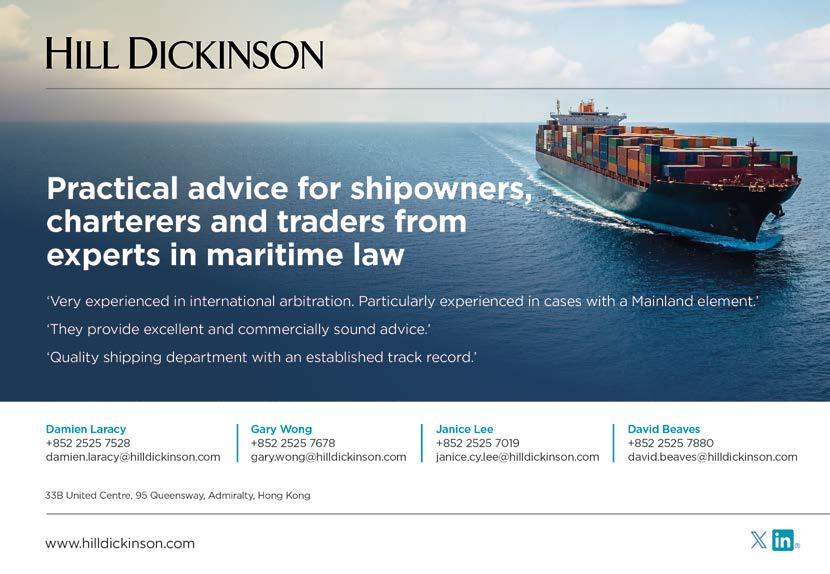
Regional Focus: Hong Kong
Towering presence
China in the space of just a few decades has emerged as the world’s foremost shipping nation. The country is now neck-and-neck with Greece in terms of owning the largest fleet, while in both the shipbuilding and port sectors it is clear fronrunner.
And as far as global maritime hubs are concerned, Shanghai and Hong Kong rank third and fourth respectively in the world, according to the Xinhua-Baltic International Shipping Centre Development Index, behind only Singapore and London.
In latest BIMCO statistics, China owns the second largest cargo carrying fleet with 15% of the world total in deadweight terms, behind only Greece with 19%. But broker Clarksons suggests China’s total gross tonnage has already edged ahead of that of Greece at 294.2m gt (versus 294.0m gt), while the value of its fleet is comfortably out front at $180bn (vs. $163bn).
Moreover, growth of the Chinese fleet is predicted to outpace that of its main rival over coming years since the newbuilding orderbook held by Chinese shipowners is 21% larger than that of their Greek counterparts, with in-demand vessel types LNG and car carriers featuring strongly.
Regarding the emergence of China as a shipowning nation, BIMCO notes that the entry of Chinese financial institutions into the leasing market has significantly contributed to the growth of the Chinese owned fleet in recent years, and five out of the 10 largest Chinese shipowners are leasing institutions. Combined, the ten largest shipowners control 41% of the Chinese owned fleet.

Editorial credit: Adam Yee / Shutterstock.com
58 Ship Management International Issue 106 November/December 2023 Regional Focus: China
Nor are these owners shying away from investing in environmentally friendly vessels able to burn alternative fuels. Over the past year COSCO, the world’s fourth largest container line, has ordered a series of 24,000 TEU and 16,000 TEU methanol dual fuel (DF) boxships. Then at the Marintec China event in early December (see picture) it contracted with engine manufacturer MAN to retrofit the same methanol DF capability to up to 13 existing large containerships, which will become the Chinese line’s first methanol-capable vessels.
Meanwhile, China Merchants recently opted for a quartet of methanol DF car carriers as part of a $500m newbuilding spree that also included kamsarmax bulkers and multipurpose carriers. China Merchants Energy Shipping (CMES) separately ordered what was said to be the first methanol dual fuel VLCC in August.
On the shipbuilding front, China State Shipbuilding Corporation (CSSC) is now largest shipbuilder in the world after a merger in 2019, while Chinese yards overall ranked top globally for all three main metrics for in first half of 2023 ,with 24.09m dwt of newbuilding completions (+15% year-on-year), new orders booked of 44.76m dwt (+74% y-o-y) and orderbook of 127.9m dwt (+23% y-o-y), according to the China Association of the National Shipbuilding Industry. Tanker orders in particular have soared this year, almost tripling over the previous year’s levels during the first 10 months of 2023.
Complexity-wise Chinese yards are also stepping up a gear, building new vessel types such as LNG carriers and cruiseships once thought the preserve of the more

high-tech Korean/Japanese and European shipbuilding industries respectively. China’s first domestically produced large cruise liner Adora Magic City completed her sea trials in July. And with the Russia-Ukraine conflict having boosted the demand for large LNG carriers, CSSC said that it had received 49 LNG carrier orders in 2022, taking China’s share of carrier orders for the year to around 30% from less than 7% in 2021. That trend has continued in 2023 with Xinhua News Agency reporting that Chinese yards received orders for another 14 large LNG carriers in the first half of the year.
With orders for methanol fuelled vessels increasing, Guangzhou Shipyard International (GSI) recently pioneered China’s use of best-in-class high performance polymer MarineLINE cargo tank lining on the latest pair of methanol dual fuel MR product tankers it has built for Proman Stena.
Meanwhile, CSSC’s Jiangnan Shipyard turned heads at Marintec China with its concept design for a nuclear-powered 24,000 TEU containership.
And LNG-powered vessels built in China are becoming commonplace, such as the 13,000 TEU containerships ordered by CMA CGM at Hudhong-Zonghua Shipbuilding, or series of 20 boxships of between 10,000- TEU and 11,000 TEU that Zhoushan Changhong International Shipyard is constructing for MSC.
Retrofit work at Chinese yards is also becoming more complex, again in line with industry trends towards more environmental vessels. Zhoushan Xinya Shipyard recently signed a contract with Maersk for retrofitting an existing containership with a MAN powerplant
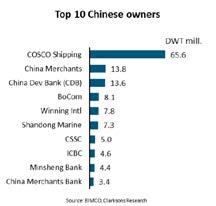
able to run on methanol, believed to be an industry-first conversion, while Chinese company Dealfeng has developed a rotor sail system for wind-assisted propulsion, certified by China Classification System, that is being installed on newbuildings and is suitable for retrofit.
But perhaps it is the port sector where China’s rise has been most dramatic. Seven out of the 10 busiest container ports in the world are now in China, namely Shanghai – world leader with over 47m TEU throughput - followed by Ningbo-Zhoushan, Shenzhen, Qingdao, Guangzhou, Tianjin and Hong Kong.
More surprising still is the extent of China’s port interests the world over. According to Drewry’s Global Container Terminal Operators Annual Review and Forecast 2023/24, China Cosco Shipping and China Merchants Ports (CMPort), ranked 2nd and 3rd respectively in the world as far as 2022 throughput was concerned, handling 52.9m TEU and 50.6m TEU respectively, behind only PSA International (61.0m TEU) but ahead of APM Terminals (48.8m TEU), DP World (46.5m TEU) and Hutchison Ports (45.1m TEU). l
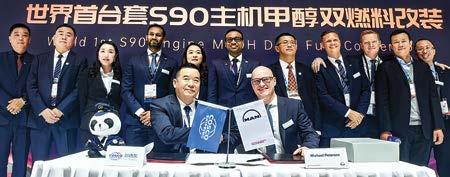
59 106 November/December 2023 Ship Management International Regional Focus: China

Year of achievement
Turkey, officially the Republic of Türkiye, was in buoyant mood in late October when it celebrated its 100th anniversary, having been founded by Gazi Mustafa Kemal Atatürk as successor state to the Ottoman Empire. KOSDER, the Turkish Coaster Shipowners and Operators Association, held a special celebration to mark the anniversary (pictured below), Chairman Hakan Çendik announcing KOSDER scholarship support to 100 students to mark the occasion.
The national economy has also surprised observers this year with its resilience, bouncing back from the negative effect of two massive earthquakes that struck the southern and central parts of the country (and northern and western Syria) in February 2023. GDP rose by 3.8% in Q2, although economists expected that growth to slow later in the year as government measures to tackle inflation curbed consumer spending.

signed a strategic partnership with StormGeo, an Alfa Laval company, back in March. Under the deal StormGeo’s complete s-Suite system will be made available to all TSA members. “For over one year, TSA has been looking for a solution to help us decarbonise and digitalise our operations,” said its Chairman Cihan Ergenc, adding that offers from some 15 software companies had been evaluated in all.
One issue affecting Turkish shipowners has been Russia’s ending of the Black Sea Grain Initiative in midyear, followed by incidents of vessels being damaged by collisions with mines laid to deter vessels entering or leaving Ukraine. RoRo operators, including those importing cars, have also been impacted by severe congestion at Turkish ports, a situation that is hoped will ease with DP World’s taking over Evyap Port in Izmir.
Like ship operators around the world, Turkish owners are also facing the twin challenges of decarbonisation and digitalisation and to this end the Turkish Shipowners’ Association (TSA)
The growing importance of Turkish shipping on the international stage has been demonstrated by a number of developments this year, such as classification Türk Loydu’s accession to membership of IACS (see later article) and Turkey’s joining the Institute of Chartered Shipbrokers’ (ICS) governing body. Also, Columbia Group opened an office in Istanbul, headed by Capt. Ozgur Gunes, offering the full spectrum of what the Group calls its ‘second party’ technical and crew management services, while semi-liner breakbulk operator Varamar likewise set up a branch in the Turkish capital.
But perhaps the biggest success story this year has been the continued advance of Turkish shipyards, attracting
a growing raft of newbuilding and repair/retrofit work across a wide spectrum of vessel types, involving work of increasing complexity (see following articles). Leading tug builder Sanmar attributed this to the weak forex value of the Turkish Lira, coupled with the Turkish government’s policies prioritising exporters and other foreign currency earners.
Recent high-profile newbuilding orders at Turkish yards have included a quartet of passenger vessels for Norwegian fjords operator Havila, as well as a series of methanol dual-fuel CSOVs for Dutch offshore vessel owner Actu Marine, both at Tersan Shipyard.
Indeed, Tersan Shipyard surprised many international observers in November when it agreed a deal to take over Havvyard Leirvik yard in Norway, a move described by vendor group Eqva ASA as signalling the Turkish yard’s “clear ambition to further strengthen its position in Northern Europe with Havyard Leirvik as a stepping stone.” Watch this space. l
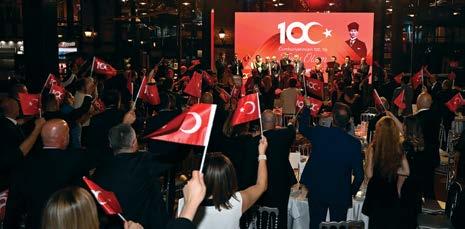
61 106 November/December 2023 Ship Management International Turkey Report
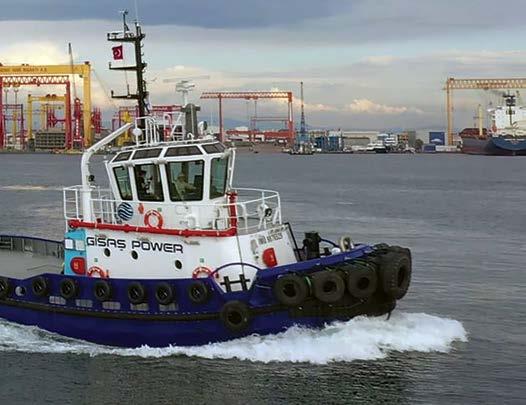
SHIPYARDS:
Expertise, experience and eco-credentials
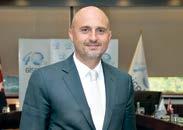
SMI) Please provide an introduction to GISBIR, the number of its member yards and size of workforce.
MK) The Turkish Shipbuilders’ Association (GISBIR) is one of the oldest non-governmental organisations (NGOs) in Türkiye established in 1971.
As a shipbuilding country with 600 years of experience, Türkiye has the oldest shipyard still under operation in the world (Imperial Arsenal Shipyard). As of 2023, Türkiye has 85 active shipyards and GISBIR represents the vast majority of the industry. The shipbuilding industry has 35 floating docks and 11 dry docks, quite a extensive infrastructure for repair and maintenance.
The shipbuilding industry’s average workforce consists of 85.000 direct shipyard employees as well as 200,000 employees who work for the supply chain of shipbuilding/ repair/maintenance business.
Maximum annual new shipbuilding capacity is 4.74 million DWT and the maximum annual ship maintenance and repair capacity is 26 million DWT.
GISBIR is a member of SEA Europe (The Shipyards’ & Maritime Equipment Association of Europe) and the ASEF Council (Active Shipbuilding Experts’ Federation), which are the umbrella organizations of the shipbuilding industry in Europe and the Asia. GISBIR also is a member of the Waterborne Technology Platform (ZEWT Partnership) for involving EU maritime projects.
SMI) How many vessels of what type have GISBIR members delivered this year and have on order?
MK) The Turkish shipbuilding industry has shown remarkable development through the last two decades especially and is still evolving today with the new demands of the maritime sector. This development is supported by the know-how and experience gained over the past decades.
‘Having this background, our shipyards can offer a wide variety of vessel types and have proven their abilities by successfully delivering a number of ‘world firsts’ with some 35% of output being eco-friendly and innovative ships. These include:
• The world’s first battery-powered fully electric tugboat (awarded Tug of the Year and the Green Apple)
• The world’s first LNG-powered tugboat
• The world’s first remotely operated commercial ship,
• Battery, LNG and hybrid-driven ferries
• The world’s largest zero emission ferry
• Zero emission 100% battery powered ferries with autonomous functionality
• Powerships, a new innovative solution for generating electricity onboard and supply to onshore grid, used for mainly African countries
• Offshore Supply Vessels powered by methanol and MDO/HVO
• Successful fitting of sulphur emission treatment (‘scrubber’) and ballast water treatment systems.
• In addition, Turkish yards are leaders in the production of fishing vessels, including the world’s largest live fish carrier; high-tech naval vessels, including the largest ship in the Turkish Naval Fleet; and are the third-largest builders of yachts in the world.
In conclusion, beyond the remarkable examples above, Turkish shipyards employ modern technologies, are certified to international standards, and are capable of building a wide variety of different ship types. Among their areas of specialisation are: oil and chemical tankers, bulk carriers and container ships, heavy lift vessels, multi-purpose ships, platform support vessels, naval ships and coast guard boats, tugboats, mega yachts & sailing yachts, fishing vessels, car & passenger ferries, and power ships
62 Ship Management International Issue 106 November/December 2023

SMI) Can you please provide example of Turkishbuilt reference vessels and international projects or technology developments in which Turkish shipyards are involved?
MK) A few specific examples would be:
• ‘From Zeetug to Zeeport’ GİSAŞ POWER, the world’s first zero-emission all-electric tugboat, was commissioned by GİSAŞ in 2019, and today provides pilotage and tugboat services at Tuzla Port located in Tuzla shipyard region. GİSAŞ POWER was designed by Turkish naval architects and engineers constructed by a Turkish Shipyard and awarded as Tug of the Year 2021 and as Green Apple in the global market. As of 2023, GİSAŞ with its four zero emission tugs is the biggest zero-emission tugboat fleet owner and manager in the world. In addition, it plans to add two more zero-emission tugs and electrify port handling equipment in order to become ‘The World’s First Zero Emission Port Operator’.
• The EU-Funded H2020 Project ‘RESURGAM: Robotic Survey, Repair and Agile Production for Shipyards’ With 13 partners. RESURGAM project aims at a decisive break-through with Friction Stir Welding (FSW) as a high-integrity, low-distortion, environmentally friendly welding technique to be developed for steel, to facilitate the modular construction of ships across multiple yards, with final assembly at one master yard. It also aims to develop the process of underwater, robotic FSW to allow repairs to be carried out on marine structures without needing to bring ships or platforms ashore to a dry dock. The first demonstration of the new welding technique was carried out by a GISBIR member shipyard.
• Digitalisation of shipyard worker training
GISBIR is successfully finalising the EU-funded ‘Safe Shipyards with Technology-Based Trainings’ project, in which we aim to digitise OHS training by LMS and Virtual Reality Modules. SMI) Are there any particular challenges or new regulations impacting Turkish shipyards?
MK) The Turkish Shipbuilding Industry is fully aligned with IMO and EU environmental goals and has wide experience of the implementation of new technologies and fuel systems. Some member shipyards have already carried out technology pilots for EU-funded projects.
At the same time, such new requirements can also cause unfair or unbalanced competition among countries. Some countries may use governmental incentives that do not comply with WTO requirements or some countries may create marketbased mechanisms or huge R&D funding mechanisms to support their own maritime industries. In Türkiye, maritime business is mainly managed by private and not state-owned owned companies so the private sector tries to deal with competitive issues using their own abilities, but in some cases, a Governmental Strategic Approach is crucial for the sustainability of the industry.
As an example; although Türkiye as a candidate country for the EU can participate in some EU funds it cannot participate in the EU Innovation Fund. This means Türkiye should find a solution in order to balance competitiveness whether by establishing a Turkish ETS Shipping mechanism or by negotiating EU policymakers about participating Innovation Fund. We know that good strategy is a crucial element to improve our industry and support progress.
SMI) Are there any other issues that you would like to share with the readers of SMI?
MK) As GISBIR, we attach great importance to the promotion of our industry in international events. We also participate in many exhibitions and conferences in EU, USA, Singapore etc. as well as organise events ourselves as a host organisation. For 2024, GISBIR will host the ASEF General Assembly, ASEF Forum, SEA Europe Board Meeting, Mare Forum Istanbul and Superyacht Türkiye. We will be happy to meet all of our international partners in Istanbul.
SMI) Thank you very much Mr Murat Kiran. l
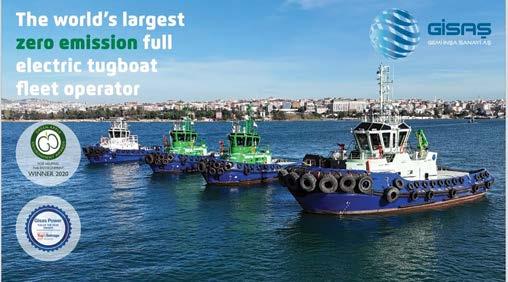
We know that good strategy is a crucial element to improve our industry and support progress
64 Ship Management International Issue 106 November/December 2023 Turkey Report
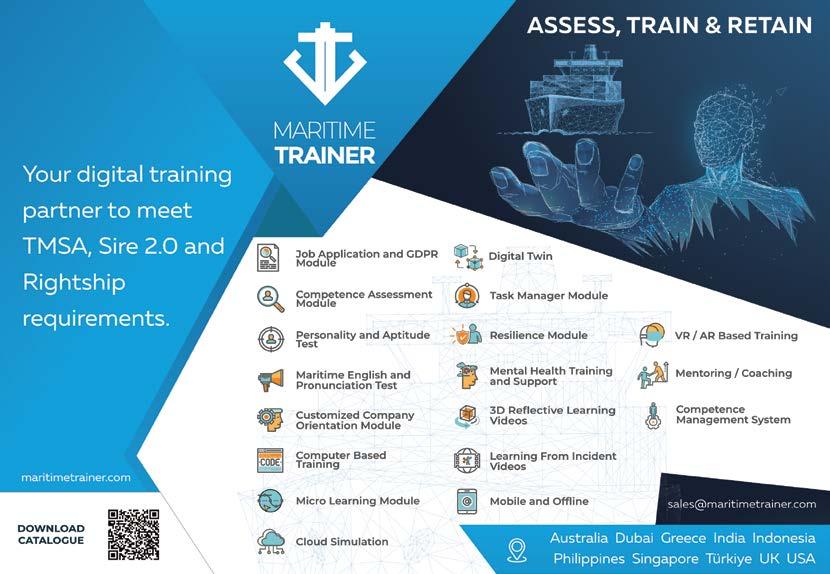
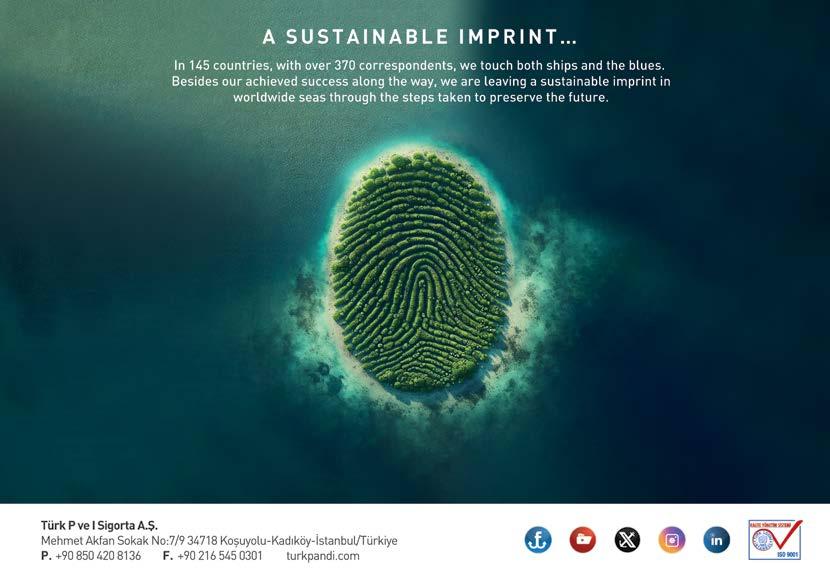
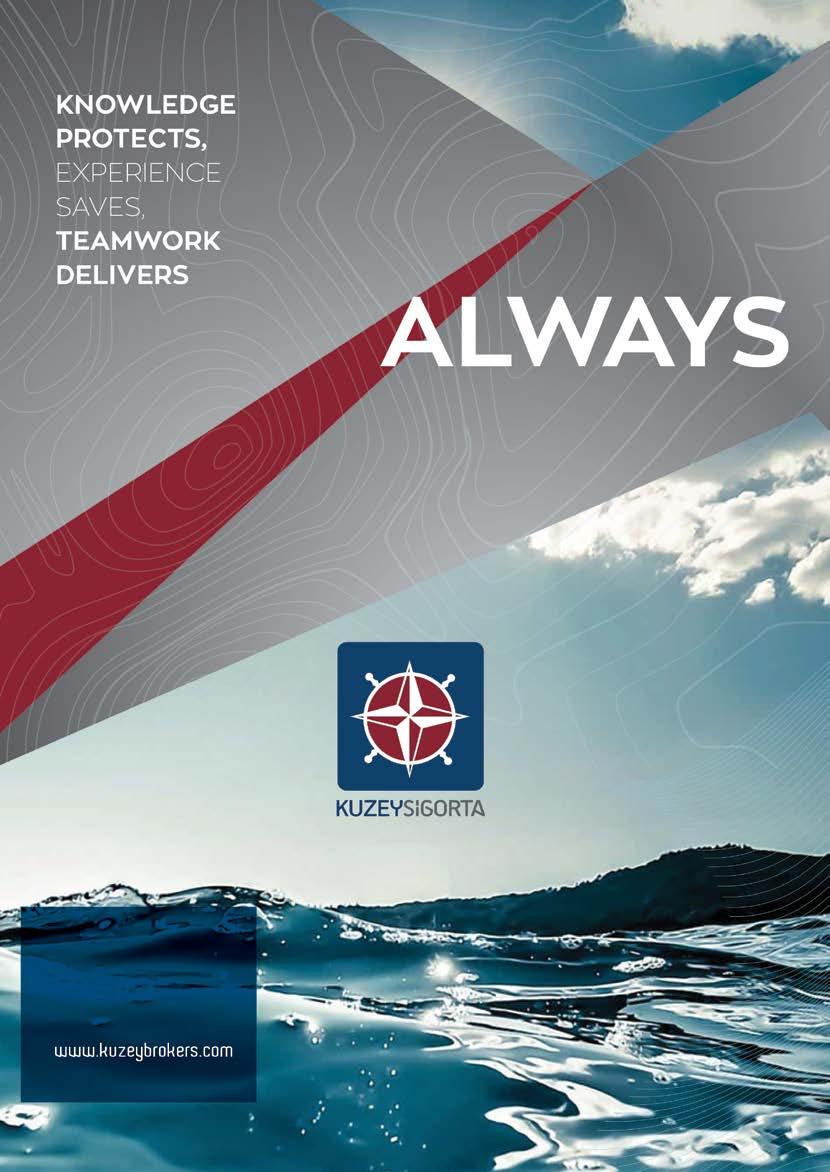
Türk Loydu begins new era as proud member of IACS
A special message from Lutfu Savaskan, General Manager, Türk Loydu AS, upon his company’s acceptance as a member of IACS.
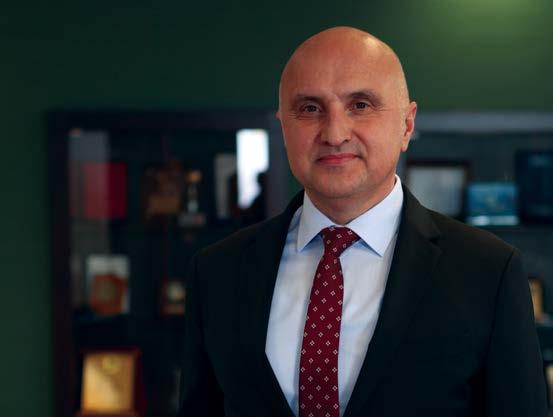
In a groundbreaking stride towards the future, we are thrilled to announce that Türk Loydu has officially joined the esteemed International Association of Classification Societies (IACS) as of November 1, 2023. This marks a colossal leap for us, as a global powerhouse in Classification and Conformity Assessment.
Since our inception in the vibrant city of Istanbul in 1962, Türk Loydu has not merely sailed; we’ve navigated the tides of innovation and excellence for over six remarkable decades. Our journey has been one of continuous evolution, fostering a diverse spectrum of services that include ship classification, statutory services, certification of marine products, systems and personnel certification, industrial and risk assessments, notified body activities, and a comprehensive range of certification services.
As a proud member of IACS, Türk Loydu stands shoulder to shoulder with 11 other dynamic entities, collectively safeguarding over 90% of the world’s cargo-carrying tonnage. Our commitment is unwavering - to ensure ships’ safety and the seas’ purity. We share in the mission of IACS, upholding professional integrity and soaring to the highest standards. Our journey to IACS membership was not just a procedural triumph but a commitment to global excellence. We earned our wings in 2022 with a ‘Compliance Certificate’ under the rigorous ‘IACS Quality Management Certification System’, validated through audits by an accredited certification body. Today, we stand tall, officially embraced by IACS.
Horizons do not confine our vision; they span the seas and beyond. Türk Loydu is not just a symbol of reliability; we are torchbearers of maritime evolution. From pioneering innovations in autonomous and unmanned maritime vehicles to championing zero-emission ships, alternative
fuels, and cybersecurity, we are at the forefront of shaping the marine landscape.
The IACS affiliation isn’t merely a feather in our cap; it’s a seal of assurance and a pledge to international standards. Türk Loydu represents a commitment to safety, quality, and environmental sustainability for ship owners. Every vessel we classify proudly carries the stamp of recognition from a globally revered organization.
Beyond the waves, Türk Loydu is not confined to maritime prowess alone. We are trailblazers in defence projects across seven nations, with negotiations ongoing in three more. In the industrial arena, we’ve recently made significant strides in energy projects, particularly in the dynamic field of nuclear energy. Our footprint extends to the construction inspections of unique structures, bridges, and airports and active participation in the aerospace industry.
Our membership in IACS is not the culmination; it’s the commencement of a new era. We are set to infuse more innovation and excellence into maritime safety, environmental protection, and sustainability. Our commitment isn’t just about quality processes; it’s about redefining industry standards, ensuring a future where the maritime sector shines brightly and securely.
We are not just sailors; we are pioneers of a maritime revolution. Turk Loydu’s journey with IACS is a testament to our unwavering dedication to safer seas and boundless accomplishments. We extend our heartfelt gratitude to our stakeholders, partners, and supporters. Join us as we embark on this thrilling voyage towards a future where the seas are safer, and our achievements know no bounds. Thank you for your unyielding support and trust in Turk Loydu. l
Turkey Report
67 106 November/December 2023 Ship Management International
Newport Shipping launches new venture at Cicek Shipyard
Newport Shipping is a UK-established company offering vessel management, design, construction and repair experience dating back to the 1960s. Starting out with Cicek Shipyard in Tuzla, the company today has a collective of 15 yards around the world with 38 docks capable of handling approximately 2,500 repairs annually of all vessel classes and sizes.
Cicek Shipyard has undertaken projects for chemical/ oil tankers, bulk carriers, container vessels this year. One project of particular significance currently going through drydocking is chemical tanker Anuket Sapphire for Scottishbased Norbulk Shipping.
Erdal Turk, Sales Manager – LNG Retrofitting and Dry Dock Projects, Newport Shipping, comments: “The vessel’s bottom plates have almost all have been thinned down. We are renewing the bottom plates with removing/adding keel blocks and in order to reposition centre keel blocks, we are planning to make intermediate undocking and re-docking for her.”
In an important development this year, Newport Shipping has launched new entity NAV, a naval architecture
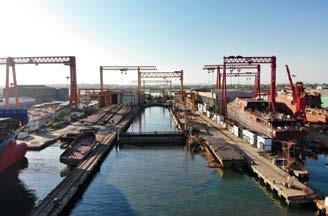
design and construction company for newbuildings. Its first project is an adaptable and hybrid-powered Crew Transfer Vessel for the Offshore market, with the first units expected to be constructed at Cicek.
Ingmar Loges, Founding Partner of NAV, comments: “This is a logical next step in our business approach. We cater for the ship repair and retrofit market, but at the heart of what we do is good engineering. For us it was a natural move to develop in this area.” l
Istanbul Marıne Turbıne welcomes Garrett partnershıp
Established in 1992, Istanbul Marine Turbine Service (IMTS) is the largest turbocharger service company in Turkiyë and has the largest number of service engineers, capabilities and machine park. The company maintains a strong network of service locations, both in Europe and stretching from North America to the Far East, allowing around-the-clock support to customers on a global basis.
With its headquarters located in Tuzla, IMTS has a convenient access to major shipyards at Tuzla and Yalova bays, and the company has further affiliate workshops in Izmir. With close
links to the marine industry, all its service engineers are from marine backgrounds with oceangoing experience, including in senior roles such as chief engineer.
In addition to the marine sector, IMTS’ business extends to other areas of turbocharger service management, such as power plant plant applications and power ships.
The IMTS workhops are equipped to overhaul all types of turbochargers from small size Garrett, KKK, Holset, IHI to large-scale turbochargers of KBB, Napier, Mitsubishi, MAN, and Accelleron (ex-ABB). Facilities include all equipment needed for dynamic balancing and repairs;

refurbishments can also be carried out under strict quality control. Capabiliities include shaft and blade repairs and components such as oil pump and roller bearings reconditioning.
The company is authorised as a service centre for both Napier and KBB turbocharger and happily welcomes Garrett as a new partner starting from 2023 with engineers and technicians trained by those OEMS. It is also certified supplier of genuine spare parts for those companies’ products, working to provide proactive support for all equipment operators. l
Turkey Report
68 Ship Management International Issue 106 November/December 2023


Maritime Trainer pioneers digital crew ‘learning’
Crew training specialist Maritime Trainer started up operations at end 2013, initially serving clients in its native Turkiye where it became market leader by end-2021. Over the past 10 years it has continuously improved its platform and content, and two years ago began marketing its services globally, winning important international reference clients suc such as Oldfendorff Carriers of Germany and Neptune Lines of Greece. Today it employs more than 60 staff around the world, serving around 100 clients with long-term contracts.
The company’s founders, including MD Capt. Ozgur Alemdag (pictured), have maritime backgrounds and collective experience of maritime safety training and software totalling more than 50 years. Its training experts are also ex-seafarers, and like all other team members possess a sound understanding of the shipping industry and its needs.
The company works to meet TMSA, OCIMF SIRE 2,0 and Rightship, also following industry best practices like Partner in Safety. In addition, it sees itself as pioneering different innovative developments on behalf of the industry, acting like a ‘third-party digital academy for clients’. Indeed, it views its close relationship with clients and constant attention to their feedback and that of seafarers as a key differentiator from its competitors.
Readiness to use digital platforms clearly increased during the pandemic, advancing by around 10 years in the space of three, Maritime Trainer believes. While a firm believer in the benefits of technology, it never loses sight of the human users and designs its process and content in an interactive and blended way that is aligned with their learning styles. It has also developed various modules to measure the happiness of the seafarers to let companies act proactively to improve the situation.
End goal. It says, is to provide a tool to transform teaching into learning, “which the new generation is very familiar with, and an easy way to expand knowledge in a sustainable way.”
Recent innovations on the Maritime Trainer platform include:
- A proctoring system that the company has developed, powered by vision analytics, helped us make reliable remote assessments.
- A pronunciation evaluation system that it started to implement in its Maritime English test that also created a great value in measuring the pronunciation skills of seafarers. This technology can also enable seafarers to practice and improve their skills themselves.
- VR-based serious games and digital twin-based learning courses giving a great opportunity to create immersive learning experiences for onboarding, emergency response, operational training, and hazard

identification. With the integration of cloud simulation technology, simulators are brought to the homes of seafarers and allow them to learn from tutorials without an instructor using self-learning scenarios. They are also to create their own scenarios for specific cases without the need to ‘spend a fortune for the simulator centre’.
In conclusion, Maritime Trainer thinks the industry is facing a huge skills gap as it needs to adopt advanced technologies and handle the challenges of decrabonisation, while seafarer sources are shifting to undeveloped and developing countries. Most of the standards for safety and training are simply not ready for the new systems that are starting to be implemented, it says, so there is a real need to “work with platforms that enable the technology to expand knowledge in the best way and close these gaps. We do find ourselves in a very good place to reply to these demands and assist shipping companies to comply with competent seafarers.” l
70 Ship Management International Issue 106 November/December 2023
Turkey Report
Classification Decarbonisation Now
SMI looks at how classification societies are on the front foot when it comes to helping the maritime industry wean itself off fossil fuels.
Increasing regulatory pressure to decarbonise, including stricter targets set by the IMO this July, means the shipping industry now needs to achieve a 20% reduction in emissions by 2030 and net-zero emissions by or around 2050. But faced with tough competition for greener fuels from other sectors, this first 2030 target for maritime emissions already hangs in the balance.
That’s the finding of the latest edition of the DNV Maritime Forecast to 2050, launched in September, which emphasises the need to consider all alternative approaches to reducing emissions and to take action now to secure future success. To meet the anticipated demand of 17 million tonnes of oil equivalent (Mtoe) annually by 2030, the maritime sector needs to access a staggering 30-40% of the projected worldwide carbon- neutral fuel supply, it says. Shipowners must therefore focus beyond fuels, in particular on what can be done now to achieve energy efficiencies and carbon emission reductions.
A companion report Pathway to Net Zero Emissions, published in November, found that high-income countries and leading demand sectors must move faster than currently planned, reaching net zero earlier than stated targets, for which immediate and permanent fossil fuel cuts are necessary.
“The 2020s marks the decisive decade for shipping,” commented Knut Ørbeck-Nilssen, CEO DNV Maritime. “Securing greener fuel supply is critical. However, focusing on fuels alone can distract us from making an impact this decade and ambitious future declarations are not good enough. What we need is tangible actions that will reduce emissions. Energy efficiency measures can deliver decarbonisation results now and towards 2030.”
The Maritime Forecast to 2050 presents an updated look on a range of regulations and drivers for the decarbonization of shipping, the most important being new
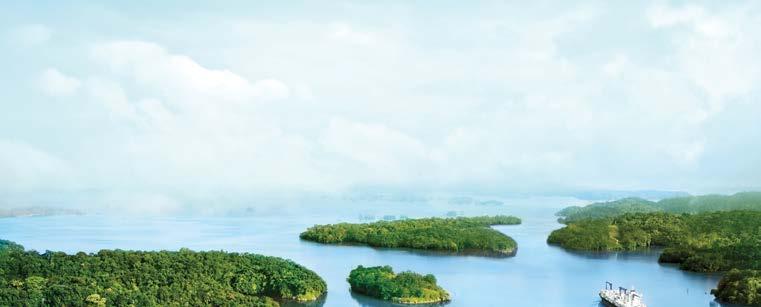
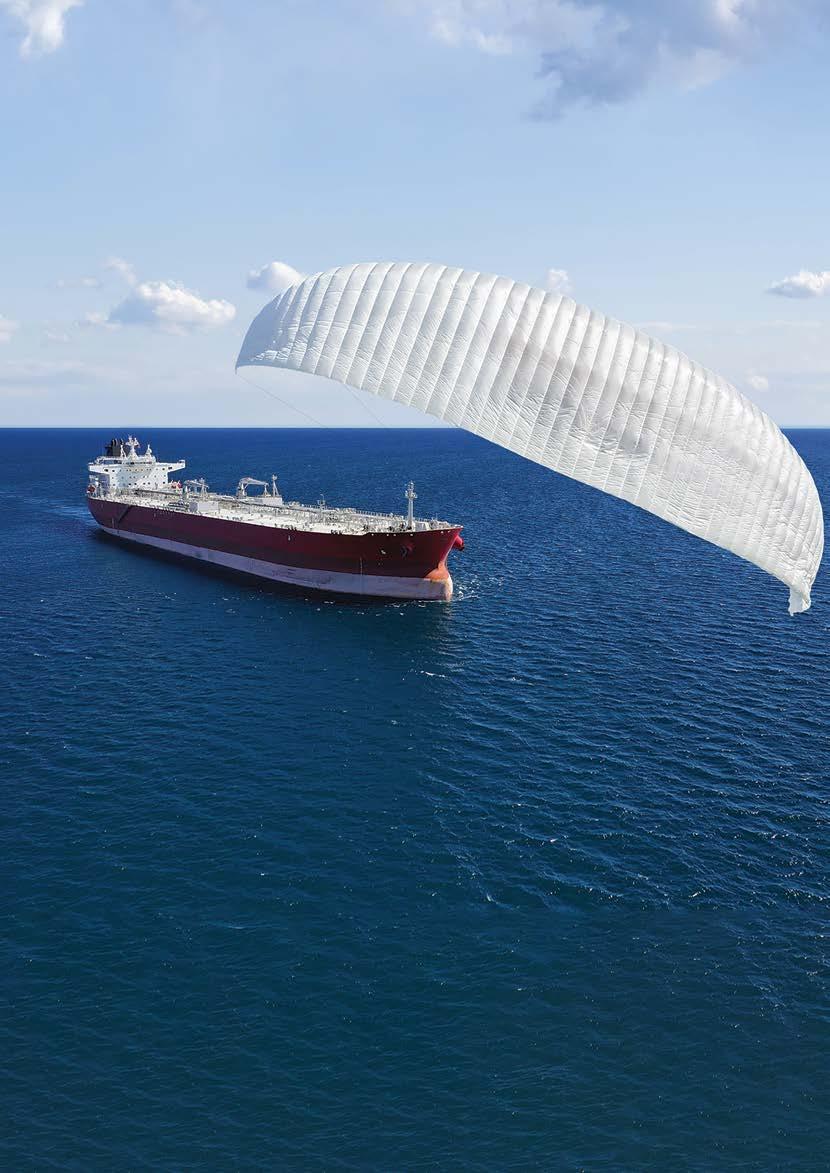 PHOTO: BUREAU VERITAS
PHOTO: BUREAU VERITAS
IMO regulations, the inclusion of shipping in the European Union’s Emissions Trading Scheme (EU ETS) and incoming well-to-wake requirements. These regulations will increase the operational cost of using carbon fuels, incentivising shipowners to put plans in place today to reduce their carbon output.
Operational energy efficiency measures recommended by the report and available today include air lubrication systems and wind assisted propulsion. The latter has already been installed on 28 large vessels, delivering fuel savings of between 5-9% to date, it says, while the potential when retrofitted on existing ships can reach 25%.
Other findings include that a fuel technology transition is already underway, with half the ordered tonnage capable of using liquefied natural gas (LNG), liquefied petroleum gas (LPG), or methanol in dual-fuel engines, compared to one third of the tonnage on order last year. For ships in operation, 6.5% of tonnage can now operate on alternative fuels, compared to 5.5% last year. The uptake of methanol and LPG is also starting to show in the statistics together with the first hydrogen-fuelled newbuilds. There are currently several ongoing demonstration projects for ammonia-fuelled ships, and a growing pipeline of ammoniafuelled ships soon to hit the order book.

Carbon capture, energy efficiency and green fuels are the pathway to net zero by 2050 defined by the 2023 Outlook, Beyond the Horizon: View of the Emerging Value Chains, published by ABS earlier this year.
The research from into shipping’s progress on the green energy transition examines in depth the carbon, ammonia and hydrogen value chains and concludes that the industry will need to accelerate investment in carbon capture technology, energy efficiency technologies and new fuels to achieve net zero by 2050.
“Our findings show there is a significant amount of work to be done between now and 2050 if we hope to hit net zero,” commented Christopher J. Wiernicki, ABS Chairman and CEO. “But crucially, our research shows it can be done, and maps out a pathway for the industry to get there.”
Reducing shipping’s CO2 emissions to net zero will require the industry to harness the potential of energy efficiency improvement technologies to reduce aggregate fuel consumption by 15% on the existing fleet and newbuildings.
At the same time, carbon capture will need to be rolled out across much of the fleet that uses fuel oil, reducing onboard CO2 emissions by 70%. Ships that cannot adopt carbon capture will need to switch to e-fuels and biofuels.
Vessels with conventional single-fuel engines will still be constructed until well into the next decade. As a result, widespread adoption of retrofitting of energy-saving and carbon capture technologies will be required for the shipping industry to meet its targets.
The report also considers the obstacles and opportunities for adoption of alternative fuels and the actions shipowners must take in order to secure their future fuel supply chain. Growing demand for higher volumes of synthetic and green bunkers will be matched by competition for these fuels by other industry sectors.
As a result, it will be essential that shipping companies demonstrate to fuel producers that sufficient demand exists to justify investment in production, pooling their buying activity in order to secure sufficient volumes.
“Conversations around which alternative fuel will lead the market will continue, and we expect dominant contenders to emerge over the next decade, but the best alternative fuel today is efficiency,” added Wiernicki.
“The maritime industry continues to be shaped by extensive uncertainty, influenced by a changing regulatory framework and evolving boundary conditions of safety, fuel availability and scalability and ship-to-port infrastructure,” he concluded.
The Lloyd’s Register Maritime Decarbonisation Hub’s (LRMDH) latest update of its Zero Carbon Fuel Monitor, which tracks technology, investment and community readiness of prominent alternative fuels for the maritime energy transition, has found that technology progress across fuel supply chains is evident, especially for ammonia and green hydrogen.
Significant milestones have been achieved for ammonia in 2023, with WinGD’s two stroke ammonia engine having received LR approval in principle as well as MAN Energy Solutions’ (MAN ES) successful completion of the first test engine running on ammonia. Green hydrogen production is also on the rise, and a bunkering license has now been granted in the Netherlands.
Overall, there has been an increase in readiness levels scattered across the key fuels and their supply chain stages, notably ammonia, methanol and hydrogen. A key factor is the success of government strategies for decarbonisation in driving land-side infrastructure expansion.
Classification
72 Ship Management International Issue 106 November/December 2023
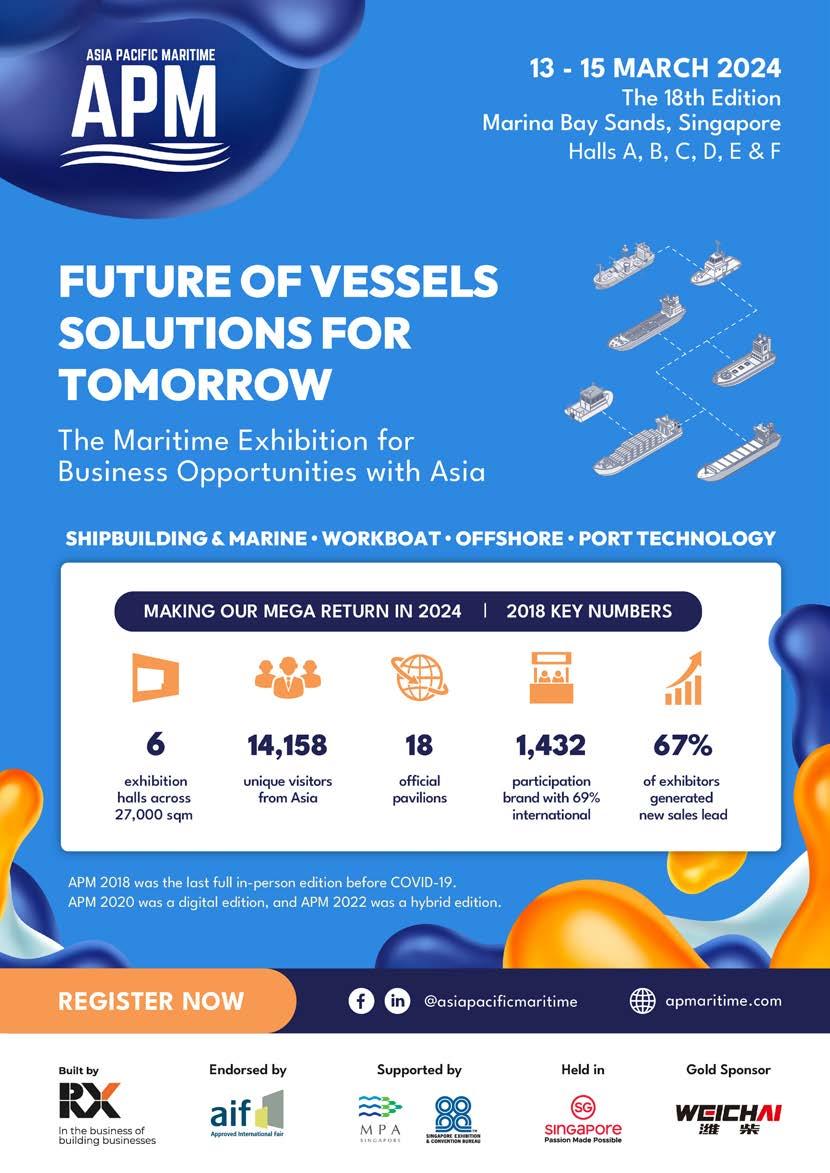
These investments and support at government level have the potential to contribute to fuel availability, port infrastructure and regulatory advancements that will benefit shipping. There has been an increase in national hydrogen energy strategies worldwide, with major countries such as the UK, China and India actively investing in renewable energy and land-side hydrogen infrastructure.
Separately, LR in November awarded the first Type Approval for a dual-fuel hydrogen - to ‘BeHydro’, a joint venture between CMB.TECH and Anglo Belgian Corporation (ABC).
The Zero Carbon Fuel Monitor update also found that demand for biodiesel has increased, although long term availability of sustainable biofuel feedstock remains uncertain. Efforts to cultivate third-generation feedstocks (characterised by high yield and rapid growth rates) like macroalgae are underway, which can be used for advanced biofuels production.
Amelia Hipwell, Decarbonisation Innovation Manager, LRMDH, commented: “Shipping’s transition to zero carbon fuels cannot be achieved through individual action or in isolation, and requires cross-sector collaboration, transparency and knowledge-sharing across the shipping industry. Although technology readiness across the supply chain is increasing for key candidate fuels, significant barriers to adoption remain in terms of investment and community readiness. Hence the need for collective action across stakeholders in the industry to drive forward the transition.”
LRMDH and the Maritime and Port Authority of Singapore (MPA) also recently signed a Memorandum of Understanding (MoU) aimed at collaborating on a fleetspecific decarbonisation strategy and implementation plan for ‘The Silk Alliance’ – a cross-industry initiative to enable low- and zero-emission shipping across the Indian and Pacific Oceans on a series of ‘green’ corridors based around major transhipment and bunkering port Singapore.
Senior Director - Global Marine Commercial & Strategy of Italian classification RINA, Pino Spadafora, emphasised how maritime sectors must work together to enable the shipping industry to meet the challenges such as decarbonisation in a video interview recorded for London International Shipping Week 2023 in September.
Highlighting the importance of engaging with fellow shipping industry colleagues across many sectors, Mr Spadafora said: “We have to work together, there is no solo approach.”
He outlined how RINA is acting as an integrator to bring together industry colleagues from throughout shipping and taking a holistic approach encompassing information sharing. He also advised of the usefulness of gaining inspiration from best practices in other business sectors such as aviation.
Within the marine sector, a good example of his collaborative approach is the Approval in Principle recently awarded by RINA to a phased green retrofit package solution designed by naval architects AURELIA, in partnership with Econowind, Wattlab and Vertom. Initially designed for a Newcastlemax bulk carrier, the retrofit solution meets CO2 reduction targets in compliance with CII (Carbon Intensity Indicator) based on five annual sailings between Brazil and China.
The resulting solution proposes two investment steps for shipowners looking to comply with the CII index. The first involves the installation of Solar Flatrack technology, batteries, and the SafePlan software developed by HMC (Hydrographic and Marine Consultants). The combination of such technologies will aim to reduce the hours in service of the auxiliary engines. Any surplus energy not consumed by the vessel is used to charge the battery bank.
The second stage of investment for the Newcastlemax, required by 2025, then includes the installation of six rigid, 30m high sails to provide supporting wind propulsion, along with switching from fossil to biofuels. Each deployed from a standard 20ft container, the Econowind solution is also deemed suitable for general cargo vessels.
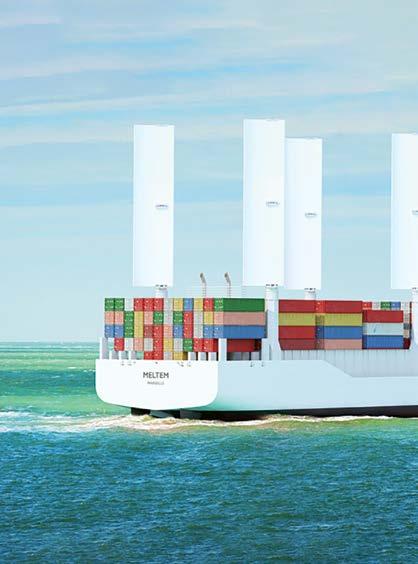
Classification
74 Ship Management International Issue 106 November/December 2023
Meanwhile, Japanese class society ClassNK recently issued an Approval in Principle (AiP) for an ammonia and liquefied CO2 (LCO2) carrier which has been jointly developed by Mitsubishi Shipbuilding Co., Ltd. and NYK Line.
Ammonia is projected to be widely used as a source of clean energy for decarbonization since it does not emit CO2 when combusted, and is expected to be increasingly transported by sea, At the same time, efforts toward carbon dioxide capture, utilisation, and storage (CCUS), a process that either uses captured CO2 as a resource or stores it in a stable underground geological formation, are also progressing. The necessity of LCO2 carriers has been highlighted for the efficient transport of captured CO2 to facilities for utilization and storage sites.
The ammonia and LCO2 carrier developed by Mitsubishi Shipbuilding and NYK Line is designed to carry both ammonia and LCO2 safely and economically using the same carrier. This would enable operations such as transporting ammonia to thermal power plants on the outbound route and transporting CO2 emitted from thermal power plants to storage sites on the return route.
IMAGE: BUREAU VERITAS
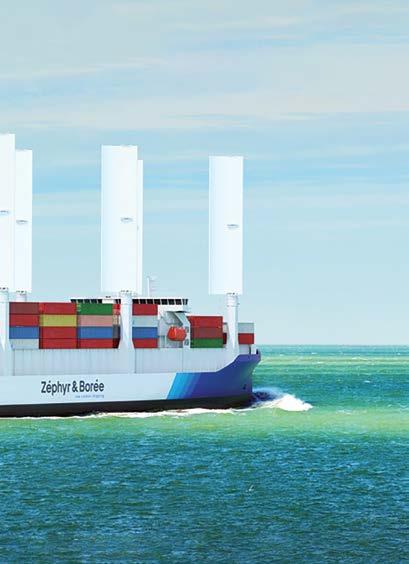
The Japanese classification society also issued an AiP for a parcel layout concept for a hydrogen-fuelled multi-purpose vessel developed by MOL, MOL Drybulk, Onomichi Dockyard, Kawasaki Heavy Industries and Japan Engine Corporation (J-ENG). This is believed to be the world’s first AiP certification for a ship equipped with a large low-speed two-stroke hydrogen-fuelled engine as the main propulsion engine.
MOL and MOL Drybulk will be in charge of ownership and operation management of the vessel and Onomichi Dockyard will be in charge of the development and building of the vessel – for which J-ENG will supply the engine in FY 2026 - and these companies will all cooperate on the demonstration operation expected to begin in FY 2027 and be conducted for two years.
Korean Register (KR) has signed a Memorandum of Understanding (MOU) with Ulsan Port Authority (UPA) to support methanol-fuelled ships and establish the South Korean port as a low-carbon, eco-friendly energy hub. Both organisations will now collaborate on regulatory reform, deregulation of methanol-fuelled ships and methanol bunkering, utilising independent tank terminals in Ulsan as methanol storage facilities, testing methanol bunkering at Ulsan port and building methanol supply infrastructure in Korean ports.
KR notes that a growing number of dual fuel methanol vessels are being ordered by international shipping companies, and in October 2022 South Korean shipping company KSS Marine took delivery of the country’s first methanol powered vessel, MV Savonetta Sun, a 50,000 dwt product tanker.
KR also recently signed a MOU with K Shipbuilding, Sunbo Industries and Dongsung Finetec to jointly develop a 12,000 m3 liquefied CO2 (LCO2) carrier design. As Carbon Capture, Utilization and Storage (CCUS) technologies become increasingly important as an aid to decarbonisation, the demand for LCO2 carriers to transport captured carbon dioxide by sea is expected to grow significantly, notes KR, which will verify the safety and suitability of the ship design in accordance with the classification rules and international conventions, ultimately granting Approval in Principle (AiP).
Separately, KR has granted an AiP for a 200,000 m3 ultra-large ammonia carrier with ammonia fuel developed by Samsung hHavy Industries, as well as for a LCO2 cargo tank design developed by Hyundai Mipo Dockyard and HD Korea Shipbuilding & Offshore Engineering.
Indian Register of Shipping (IRS) hosted a Round Table discussion entitled ‘Seascape 2030 - Decarbonisation and the Human Element’ during London International Shipping Week 2023 (LISW23) in September, debating the critical issue of how the transition to a new fuel ecosystem and continuous technological evolution will impact the
75 106 November/December 2023 Ship Management International Classification
future workforce. Also, an IRS Technical Seminar was held during LISW23 which again focused on Decarbonisation, Alternative Fuels & the Human Element.
Arun Sharma, IRS Executive Chairman, said: “IRS is committed to innovation, sustainability, and collaboration within the maritime sector. Hosting these impactful discussions during LISW reaffirms IRS as a leading voice in promoting responsible practices in shipping. IRS remains dedicated to driving positive change and encouraging the adoption of sustainable technologies and maintaining focus on the aspect of human element during this transition.”
One month earlier, IRS had secured an order for providing classification services for six hybrid electric catamarans for the Inland Waterways Authority of India (IWAI). The vessels will be constructed at Hooghly Cochin Shipyard Ltd., Kolkata and are intended to carry up to 50 passengers each. They will be propelled by electric motors powered by Lithium-Titanium Oxide (LTO) batteries – able to be charged by onshore power when at berth – and diesel generators, operating in a hybrid mode, providing electrical power to propulsion motors and other ship systems. The vessels will be assigned the additional Class notation ‘BATTERY PROP’ which is assigned to vessels where the battery systems are used for ship propulsion and are in accordance with the rule requirements.
China Classification Society (CCS) this October became the first class society to sign an Agreement in Principle with leading air lubrication technology specialist Silverstream Technologies, confirming that CCS has reviewed and verified the Silverstream® System’s design drawings and providing an independent class verification of its generic system design. Furthermore, the organisations will collaborate on project-specific engagements and approvals for the integration of the Silverstream® System in ships classed by CCS.
The AIP further strengthens Silverstream’s ties to the Chinese shipping market. The company has an office and team in Shanghai, 20 of whom are purely dedicated to onthe-ground support for Asian installations of its technology.
Noah Silberschmidt, Founder & CEO, Silverstream Technologies, said: “We are delighted to sign our first agreement of this style with a classification society, especially with CCS. CCS is one of the most influential class societies in the Chinese market, particularly for intranational projects between Chinese shipowners and Chinese shipyards. Through this important agreement, we look forward to further building our relationship with a key industry player, and to continuing commercial success in Asia and worldwide.” l
Going with the wind
By Julien Boulland, Global Market Leader for Sustainable Shipping at Bureau Veritas Marine & Offshore
There is no doubt that wind propulsion systems have enormous potential to help decarbonise shipping, and we see a new generation of wind propulsion solutions for the maritime sector emerging at an impressive pace. In this era of fast-paced technology development, our role as a classification society is to independently assess and validate new systems, ensuring safety above all.
Several safety aspects must be considered when installing wind propulsion systems on a ship, be it a retrofit or a newbuild project. The ship’s stability, for instance, is a key consideration. Depending on its type and characteristics, a ship’s stability profile may limit the conditions in which the wind propulsion system can be

used, due to the heel induced by those systems. Another requirement aims to ensure that any system placed in front of the ship doesn’t restrict visibility, to ensure compliance with current regulations.
Therefore, it is essential to have a holistic approach, where we address the safety risks associated with wind propulsion systems, the management of operations in various environments, as well as the broader impact of the system on the ship’s structure and weight, and how it will interact with other systems on board.
The foundation for these assessments is our Rule Note for Wind Propulsion Systems (NR 206). These dedicated Rules serve as the key classification framework for windassisted propulsion, outlining requirements for risk analysis
76 Ship Management International Issue 106 November/December 2023 Classification

and hazard identification (HAZID) studies, load cases and critical situations, automation and release systems, and ship strength and safety. Furthermore, BV is currently updating NR 206 to clarify the stability requirements for ships equipped with wind propulsion systems.
A recent example of BV’s work with the industry is our partnership with Hyundai Heavy Industries – Hyundai Global Service (HHI), TotalEnergies, and Mitsui O.S.K. Lines (MOL) on a joint development project (JDP) which validated the potential of wind assisted propulsion for a Very Large Crude Carrier (VLCC) and a LNG carrier. Focusing on three technologies, two of which were wing sails and one a rotor sail system, the project and the subsequent issuance of an Approval in Principle (AiP) demonstrated that all these systems are compatible with existing classification rules and regulations for VLCCs and LNG Carriers. This paved the way for more detailed work to address
specific risks that would enable detailed design and arrangement work to proceed.
In addition to working directly with a number of developers of wind propulsion technologies, BV participates in partnerships such as the Joint Industry Project WiSP (Wind-Assisted Ship Propulsion), which aims to improve methods for transparent performance prediction and use those methods to provide ship owners and operators with fast low-cost
predictions for their fleets. The project’s objectives also include a review of the regulatory landscape to recommend improvements and clarifications, and the development of a basic performance prediction tool, to be used by participants.
Finally, BV contributes to a number of industry workshops to share knowledge and best practices relates to wind-assist technology. For example, the NORVENT project aims to carry out an inventory of the needs and approaches used to evaluate the performance of wind propulsion systems for ships. It constitutes the first step in harmonising evaluations in order to give strong credibility to the results produced among users of these services, an issue regularly raised by players in the sector.
This is where BV is a key ally for the industry, and where our role goes far beyond just assessing compliance. By developing common sets of standards that are recognised across the sector, we provide guidance that supports the developers of wind propulsion technologies, while giving shipowners confidence in these innovative solutions. l
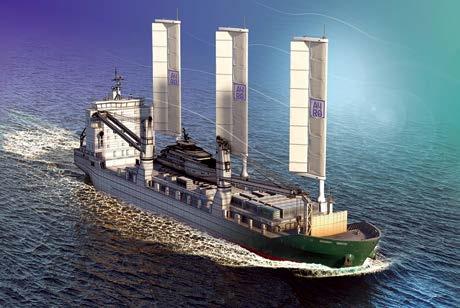
77 106 November/December 2023 Ship Management International Classification
French research body CRAIN’s suction wing design approved by BV
Columbia moves to a dynamic beat
News and pictures reach us of the Columbia Group party held during Maritime Cyprus in mid-October, just as our last issue was going to press, where drummers from Limassol’s Batoukinio percussion group added exotic glamour to an impressive evening of top networking and socialising for more than 600 attendees.
In his welcome address, Columbia President and CEO Mark O’Neil said it was the people who worked in, and alongside, the Group, both ashore and at sea, that were the driving force behind its growth and success. Columbia was the first company to introduce a code of conduct for all its staff, he said, and was a leader behind the decision to create guiding principles for the global shipmanagement sector.

“Columbia has spent $1 million of its own money setting up sanctuaries in Romania and Poland for Ukrainian seafarers and their wives and children, and has invested an additional $500,000 in an international maritime rehabilitation centre, open to all in the industry to help trauma victims as a result of the Ukraine war,” he added.
And the future looks very rosy for the group, he concluded, as the company launches its own Columbia 2.0 programme to ensure it is fit for purpose for the next 5, 10, 15 and 20 years. l
ONE provides more clean water in Africa
Global container shipping company Ocean Network Express (ONE) has joined forces with Project Maji, a non-profit safe water enterprise to launch another transformative water project providing sustainable access to safe drinking water.
Representatives from both organisations and the local community celebrated the successful installation of the MajiPlus system at an inauguration ceremony in Mwingi, Kitui County, Kenya. In early November. This followed on from the successful ONE sponsored Project Maji clean water system installed on the banks of the river Volta in Ghana in August.

“Our shared vision of clean water access for all is now a tangible reality for the communities we serve,” remarked Christian Goetz, Country Head of ONE Kenya. “This is just the beginning of what we can accomplish together.”
This partnership signifies ONE’s commitment to Sub-Saharan Africa, with their established offices in Ghana, Ivory Coast, Kenya, Nigeria, and South Africa, reinforcing its dedication to sustainable development and corporate social responsibility. l
Ad Hoc 78 Ship Management International Issue 106 November/December 2023
Three of the world’s leading academics were honoured for their work, in fields in which Aristotle Onassis also excelled, at a London white-tie gala dinner hosted by the Onassis Foundation in early November.
The Onassis Prizes were awarded to Professors Darrell Duffie, Marc Melitz, and Siri Pettersen Strandenes at the Banquet for their contributions and achievements in the fields of Finance, International Trade and Shipping respectively. The awards of $200,000 each are given every three years to academics of international range for the entire body of their work.
‘Global liner chiefs’ call at COP28 Onassis Prizes 2023 awarded at London’s Guildhall

Prof. Siri Pettersen Strandenes of the Norwegian School of Economics [inset, top] paid tribute to the “challenging and inspiring exchange of thoughts and ideas with co-authors and colleagues” which had helped to the honour of wining this year’s Onassis Prize in Shipping.
“Now more than ever, we must focus on the importance of academia to tackle what lies ahead,” said Anthony S. Papadimitriou, President of the Onassis Foundation [inset, bottom].
Shipping industry luminaries attending the event included ex-P&O supremo Lord Stirling, member of the judging panel Prof. Costas Grammenos, Posidonia Exhibitions’ honorary chairman Themis Vokos and past Onassis Prize winner and regular SMI contributor Dr Martin Stopford. l
The CEOs of leading global shipping lines issued a joint declaration at the COP 28 climate conference in Dubai calling for an end date for fossil-only powered newbuilds and urging the IMO to create the regulatory conditions to accelerate the transition to green fuels.
The declaration was signed by (l to r) Vincent Clerc, CEO of A.P. Moller – Maersk; Rodolphe Saadé, Chairman and CEO of the CMA CGM Group; Rolf Habben Jansen, CEO of Hapag-Lloyd; Soren Toft, CEO of MSC Mediterranean Shipping Company; and Lasse Kristoffersen, President and CEO of Wallenius Wilhelmsen.

The CEOs called for the establishment of four regulatory ‘cornerstones’ to guide shipping’s decarbonisation, namely: an end date for new building of fossil fuel-only vessels and a clear GHG Intensity Standard; an effective GHG pricing mechanism to make green fuel competitive with black fuel; a vessel pooling option for GHG regulatory compliance where the performance of a group of vessels could count instead of only that of individual ships; and a Well-to-Wake or lifecycle GHG regulatory basis.
In an unprecedent action, these major players of the shipping industry expressed their shared conviction that regulation can play a key role in mitigating the cost of the green transition as well as the risk of extreme weather events. Given the cost of climate change is far greater than the cost of the green transition they look forward to being joined by other companies. l
79 106 November/December 2023 Ship Management International
Ad Hoc
Analysis LPG carriers - booming markets in all sectors
In this market update, SMI looks at the liquefied petroleum gas (LPG) carrier sector. By
Ian Cochran
LPG carriers come in different size ranges of which three are usually taken as benchmarks. These are - Handy Gas Carriers (Handies), which are between 15,000 and 25,000 cu m capacity, Midsize of between 25,000 and 50,000 cu m capacity, and Very Large Gas Carriers (VLGCs) of around 70,000 to 90,000 cu m capacity. There are also a few in the 50,000 to 70,000 cu m range.
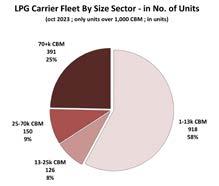
Handies are the most diverse segment and include semirefrigerated, fully refrigerated and a few larger pressurised vessels. They can carry a wide range of cargoes, such as ethylene, petrochemicals, LPG and ammonia on short to medium haul trades worldwide. Midsize vessels tend to be fully refrigerated and transport ammonia or LPG on intra-regional routes, such as within the Americas, Asian
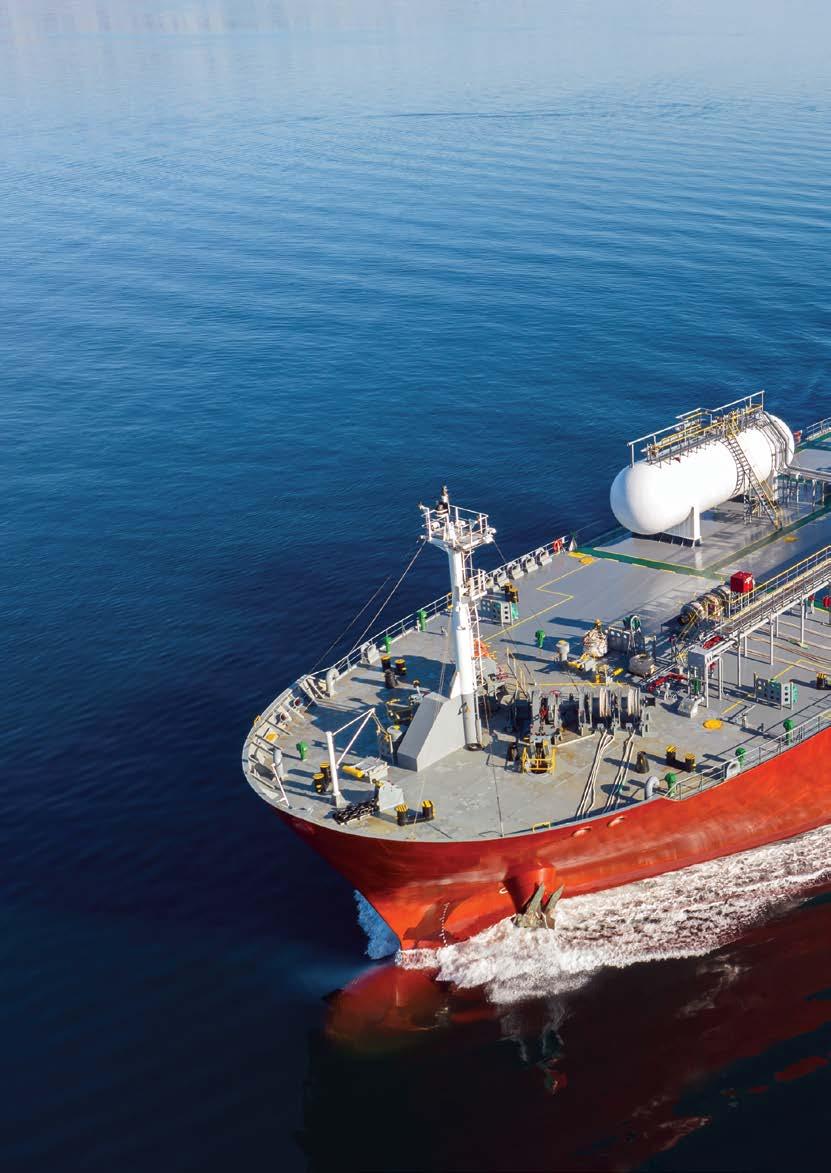
countries and medium haul cross trades, e.g. North Sea and Europe.

VLGCs are mainly employed on long haul trades, for example, between the Middle East and US to Asia. Most tend to be fully refrigerated.
In its regular sector update, Genoa-based broker Banchero Costa said that VLGC spot rates were ‘really excellent’ last year, especially in the second half and have remained firm thus far this year.
In September 2023, indicative timecharter rates for a 72,000 cu m VLGC were in the region

of $1.48 mill per month, while for a small 3,500 cu m coastal LPG carrier, rates were around $303,000 per month.
Antwerp-based LPG carrier player EXMAR agreed, saying that VLGC spot rates remained at historical highs in the company’s third quarter results presentation.
The high rates were supported by an increase in US LPG production and by China’s LPG imports to cater for the growing number of propane hydrogenation (PDH) plants in the country.
BW Gas also said that in the third quarter of this year, VLGC voyage freight rates averaged $61,800 per calendar day, or $63,100 per available day, when reporting its strongest quarterly results on record.
Into 2024, BW Gas said the market looked positive amid high volatility. The current energy price level should encourage increased oil and gas exploration, which in turn will drive steady LPG export growth from the US and the Middle East.
Demand growth from new Chinese PDH plants, increased use of LPG in the Asian residential market, and the increase in Panama
80 Ship Management International Issue 106 November/December 2023
Canal restrictions, are expected to underpin firm market fundamentals going forward, BW Gas said.
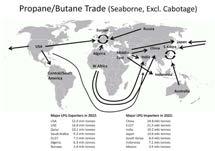
Expanding on the Panama Canal problems, Greek-based shipbroker, Xclusiv said that the current unprecedented drought will be exacerbated by the El Niño effect.
As a result, the Panama Canal Authority (ACP) is putting restrictions on the number and size of ships transiting the Gatun Lake, the largest artificial lake feeding into the canal system, due to a 41% reduction in rainfall, which has seriously affected water levels.
By 1 February 2024, the average daily transits will have been reduced to 18, way below the normal 31 ships per day, and the maximum sustainable capacity of 38-40 daily transits.
As a result, VLGC transits are likely to be curtailed, as only one vessel will be allowed go through the canal. This should provide a further optimism of firming VLGC spot rates.
“This will result in dramatic changes in seaborne gas and oil trading patterns, stretching the tonne/ mile picture in the process,” Xclusiv said in its report.
The US Energy Information Administration (EIA) also said VLGC rates had reached record highs, due to the Panama Canal delays.
VLGCs, which carry primarily propane (and, to a lesser extent, butane), on the Houston/Chiba (Japan) route, saw voyage rates reach $250 per tonne during
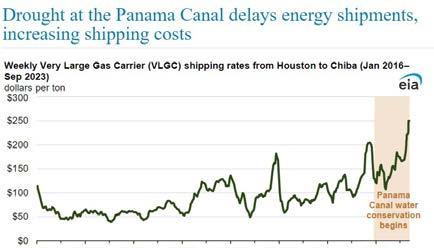
the week ending 29 September, the highest since rates were first published in 2016.
The unpredictability of waiting for transits resulted in some vessels, especially VLGCs, returning in ballast from East Asia back to the US Gulf Coast via the Suez Canal, or around the Cape of Good Hope, according to ship tracking data, the EIA said.
EXMAR also benefited from improving Midsize gas carrier rates on the back of the strong VLGC market. However, the demand and tonne/mile for ammonia shipments were reduced from last year’s strength, due to lower natural gas prices.
In the Far East, China’s construction industry was under pressure affecting propylene demand for pressurised ships. The volatile
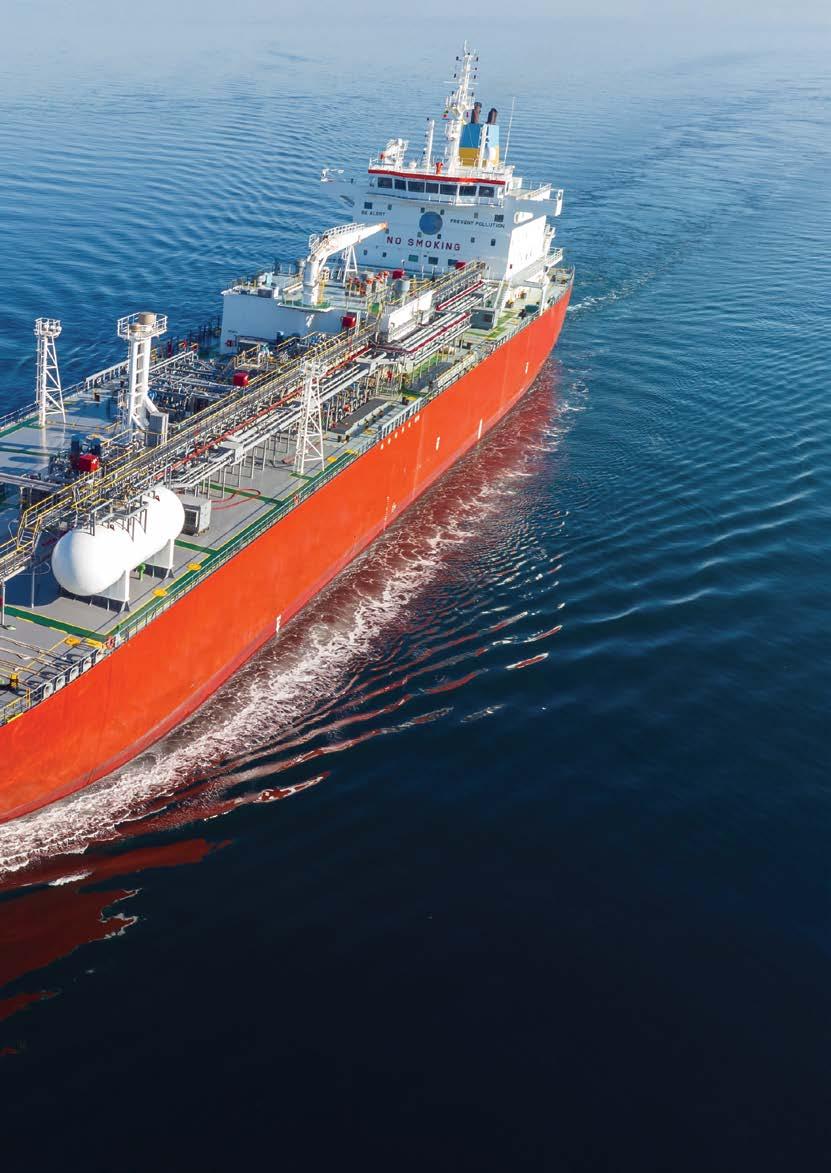
Chinese economy may further temper demand and rates in this segment, EXMAR said.
As for coaster rates, Stealthgas’ Harry Vafias, who owns 27 coastal LPG carriers, commented in the company’s third quarter results: “The market remains firm, as we are entering the seasonally stronger winter months and is buoyant for the larger sized vessels, in what we hope will prove a well-timed diversification of the fleet with the addition of larger sized vessels. We believe we are well positioned to benefit from strong markets.”
The company recently upsized to around 40,000 cu m (Midsize) in a joint venture, while still maintaining its large traditional small ship (coaster) fleet. l

Analysis
81 106 November/December 2023 Ship Management International
Alternative Viewpoint

Maritime law and the Master
By Michael Grey, MBE, is an internationally respected maritime commentator
The modern shipmaster must be a multi-skilled being, with a growing list of important attributes. Progresschaser, factory manager, owner’s representative, charterer’s go-to person, all-round technical expert, navigator, ship-handler, diplomat, seamanship supremo, menu engineer, motivator, interpreter of contradictory instructions, receiver of “we fail to understand” messages, the man (or woman) who carries the can – the list goes on for ever. And in addition to all these numerous skills, the master must be, above all, a speed reader, to cope with the extraordinary wordage that arrives in the ship’s office every day, thanks to the facility of global communications.
Just about the biggest book I ever had cause to review was a gigantic volume dedicated to Shipmasters’ Business, with vast and tortuous sections devoted to the legal problems that a shipmaster might encounter as part of the job. That was many years ago, but I recall that the author had taken the trouble to enumerate the number of offences which could land an unwary shipmaster in a custodial sentence or facing an enormous fine. It seemed a stupendous number and made me feel rather glad that I had come ashore. Doubtless, a decade or so on, there will be many more frightful penalties for the unsuspecting. Just this month the European Commission was busily resolving to increase a whole range of financial fines for various offenses in which ships can be involved. They probably put it down to inflation.
Even the most diligent master must always have at the back of his or her mind the worry that there will be some small print, somewhere in a legal document or regulation, which will leave them cruelly exposed before some grim magistrate. “Were you not aware, Captain, of
the Regulation 7654, paragraph 34, sub-section C of the appropriate local byelaws, which specifically prohibited your action”. Guilty as charged.
Maritime law and its multiple complexities will be just one of the minefields faced by the master of a ship, inevitably the person on the spot who will be blamed by an authority for everything from an alleged pollution offence to a couple of tonnes of cargo which the consignee believes to be short-landed. Maybe the ship should carry its own lawyer, in these days of seemingly endless litigation and over-regulation, although the accommodation will be inadequate. You can argue that the P&I clubs do their best as an on-call substitute, when a ship is arrested or the master dragged ashore.
Best of all is to steer clear of legal problems, being informed about them well in advance, although that is asking a lot. Which is why the International Federation of Ship Masters’ Associations has co-operated with the International Chamber of Shipping to produce ‘The Master’s Practical Guide to Maritime Law’, recently launched at the IFSMA general assembly in Tokyo.
Compiled by a working group of experienced masters and maritime lawyers drawn from the two organisations, the book is exactly what it says on the cover, namely a practical guide that will help serving masters navigate a range of common legal issues and pitfalls and help to protect the shipowner’s interests. It is no textbook, but a genuinely useful source that will bridge the gap between theory and practice in a range of real-world situations.
Forewarned is forearmed, as people used to say, although lawyers might use a more convoluted term. l
82 Ship Management International Issue 106 November/December 2023
Technical
Russia invests in Arctic corridor
By David Tinsley
Pivotal to Russian transport logistics and resource development within the country’s vast Arctic and subArctic regions, the Northern Sea Route (NSR) is the focus of a major, national investment drive encompassing infrastructure, navigation and hydrographic support, and icebreaker fleet renewal and expansion.
The NSR is Russia’s Arctic conduit for energy and metal exports, and was used by ships carrying 34 million tonnes (mt) of cargo in 2022. Although the volume of westbound traffic and full international transits by foreign vessels have been hit by sanctions imposed since the escalation of Russian aggression towards the Ukraine, the more arduous, environmentally hostile eastern passage has grown in importance and is seeing greater utilisation for Asian traffic.
This particularly applies to gas and oil shipments from the Yamal and Gydan peninsulas, and certain other commodities from the Russian North, including coal and metal ores, bound to large parts of Asia which retain open trading links with Russia. Major industrial developments in the Taimyr and Gydan regions, such as the Syradasayskoye coal field and Rosneft’s huge Vostok Oil project, can be expected to feed further into the eastbound traffic.
In fact, the NSR is opening a new window of opportunity for the development of Russian territories, and for the strengthening of trading relationships and partnerships with friendly countries. Year-round shipping to and from the Kara Sea region on the western section has become a reality, buoyed by the projects and fleet investments of enterprises such as Norilsk Nickel, Novatek and Gazprom Neft, and the goal now is regular Arctic access and egress through

the eastern end, and along the entire 5,600km length of the seaway. Natural gas producer Novatek is reportedly planning to implement all-year eastward voyages during the early stages of 2024.
Following on from the Yamal LNG project and its generation of export flows to Asia Pacific and European markets conveyed along the NSR by a 15-strong fleet of 173,000m3-capacity, Arc7 ice-class LNG tankers, seaway traffic is set to be boosted further by the Arctic LNG2 development. China has a significant investment in Novatek-headed Arctic LNG2 both as a financial backer and future customer, and has indicated that the scheme is on track for operational start by the end of 2023.
Located on the Gydan peninsula, Arctic LNG2 is scheduled to reach its maximum output by 2026, producing an estimated 20mt of LNG per annum. Deliveries will be made by way of the NSR using a new fleet of Arc7 ice-class LNGCs, 15 of which are due to be produced by the Zvezda Shipbuilding Complex near Vladivostock, in the Russian Far East, with long-term charters also agreed on six further vessels contracted in South Korea. The logistic network includes transhipment terminals at Kamchatka for Asian cargoes and near Murmansk for European destinations.
83 106 November/December 2023 Ship Management International
The NSR’s role in serving Russian energy exports gained new dimension in August this year when the LNG carrier Velikiy Novgorod transited the seaway with a cargo for China loaded at Gazprom’s Portovaya liquefaction terminal on Russia’s Baltic coast. The gas shipment was the first from a non-Arctic plant to be made via the NSR, and presaged further such routeings, saving up to 10 days relative to passage via Suez. Russia has outlined plans to establish additional LNG outlets in both the Baltic and western Arctic regions and to build trade with Asian markets using the NSR.
The state’s commitment to the expansion of activity and capacity on the seaway is expressed at the highest level, from Putin himself, underscoring its enhanced, national economic role and strategic importance. Russian authorities claim that cargo shipments on the NSR are set to rise very substantially from 2022 and 2023 levels to as much as 80mt in 2024, and forecast that a figure of 200mt will be reached by 2031/2032.
Global warming manifested in the retreat of the Arctic ice plays to Russia’s advantage through the resulting extended navigation season along the eastern section of the NSR. However, the challenges presented to vessels and mariners undertaking such passages should not be underestimated, and the entire system and its safe and effective operation remains reliant on a powerful and extensive fleet of icebreakers.
It is in such circumstances that nuclear power comes into its own, conferring the prolonged endurance factors as well as the potency suited to harsh, remote regions where bunkering and support infrastructure is minimal or nonexistent. While diesel-electric designs figure substantially in the renewal and expansion of Russian icebreaker capacity, investment in new generations of nuclear-powered vessels for the Arctic is one of the most prominent features of the country’s maritime endeavour.
The nuclear shipbuilding programme has been extended this year, through the authorising of funds for the
construction in St Petersburg of sixth and seventh examples of the Project 22220 class to be operated by Rosatom subsidiary FSUE Atomflot. Also designated the LK-60 type, each of the 173-metre long vessels has a triple-screw installation with a combined propulsive force of 60,000kW.
Baltiyskiy Zavod handed over first-of-class Arktika in 2020. The design has the form and potency to overcome solid ice up to 2.9 metres in thickness, while maintaining a speed of some 1.5 to two knots, opening channels and escorting vessels, and capable of negotiating high ice ridges and recovering trapped ships. The dual-draught generation allows operation throughout the NSR regime, be it the most arduous, ice-infested eastern channels, or the shallow bights and estuaries along the Siberian fringe, including the Gulf of Ob and the Yenisei River to Dudinka.
The power plant is based on two pressurised water reactors, producing up to 350MW of thermal energy. Two main turbo generators each deliver 36MW of electrical power, and propulsive effect is achieved through three shaft lines and propellers driven in each case by a 20MW electric motor.
The second Project 22220/LK-60 atomic icebreaker, Sibir, was commissioned in December 2021, followed by sistership Ural towards the end of 2022. Fourth and fifth newbuilds Yakutia and Chukotka are in hand at the St Petersburg yard for scheduled deliveries in 2024 and 2026, while the two latest additions to the orderbook are expected to be ready by December 2028 and December 2030, respectively, as the Kamchatka and Sakhalin.
Current development of the fleet also encompasses a vessel that will surpass all icebreakers worldwide in terms of power and performance. The 120MW Rossiya was laid down at the Zvezda Shipbuilding Complex during July 2021 and is due for completion in June 2027. Giving first form to the long-mooted Project 10610 Leader-class, it is claimed that the 209-metre behemoth will be able to navigate ice of 4.5-metre thickness, and have an openwater speed of 22 knots.
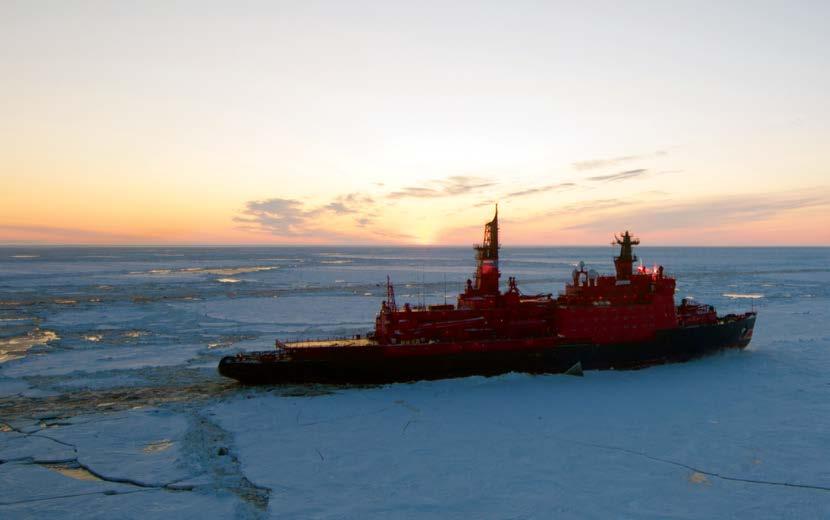
Technical
Ship Management International Issue 106 November/December 2023
The ship’s energy source will be two RITM-400 nuclear reactors engineered and produced by the Rosatom subsidiary JSC Afrikantov OKBM. The machinery outfit will include a steam turbine plant and four turbo generators of 37MW apiece, and an electric propulsion system whereby a 30MW electric motor on each of four shaftlines will deliver a maximum combined 120MW through four propellers. Longterm plans call for second and third ships of this remarkable class, tailored to the toughest operating scenarios in the Russian Arctic.
Complementing the commitment to nuclear propulsion technology, Rosmorport introduced one of the world’s most powerful non-nuclear icebreakers into Arctic service last year. Following a long-delayed construction process, the diesel-electric Viktor Chernomyrdin was completed by Baltiyskiy Zavod at the end of 2020, and spent the 20212022 icebreaking season in the Gulf of Finland, escorting merchant ships to Vyborg, Vysotsk and Primorsk. The decision to deploy the vessel to the NSR, and use the ship’s dual-draught and ‘double-acting’ manoeuvrability to effect in both the seaway and shallow estuaries, led to ice trials being conducted in the Kara Sea, demonstrating the ability to negotiate ice up to two metres-thick.
Besides icebreaking and escorting, the Viktor Chernomyrdin is equipped for emergency towing, search and rescue, oil spill response, and offshore construction, and is also certificated for passenger carrying on Arctic cruises. The vessel is of the Project 22600 type, known as the LK-25 class, embodying a hybrid-type propulsion configuration using a 10MW electric motor driving a centreline propeller,
bounded on each side by a 7.5MW Azipod azimuthing propulsion unit. The Azipods confer the ‘double-acting’ capability, enabling icebreaking and ice forcing running either astern or bow-first.
A further phase in the systematic development of the NSR was signalled by the government’s recent presentation of a new infrastructure plan for the Arkhangelsk region. A primary objective is the extension of the capabilities of the White Sea port of Arkhangelsk, which handled some 6.5mt of cargo in 2022, playing a key role in the shipment of zinc and lead concentrates and other primary goods, and serving as an interface for industrial projects, including coal and oil resource exploitation, in the Far North.

The port has recently gained an important addition to its regular shipping services by way of a new, direct connection with Qingdao and other Chinese ports for containerised goods. Using the eastern section of the NSR and the so-called North East passage, the line was inaugurated in September by a 29,000dwt Chinese vessel. It is understood that the service will include a flow of wood products emanating from the forestry industry in the Archangelsk region, and destined for China’s furniture makers.
China’s emergence as a burgeoning buyer of Russian hydrocarbon resources is a boon to Russian economic resilience and the NSR conduit, and a recent agreement on Russian training of Indian merchant marine seafarers for navigation on the Arctic seaway is also indicative of relationships that are being built elsewhere in the face of sanctions. l
Technical

Navigation
Data is our new North Star
By Charlie Fardon, Head of Sustainability, UK Hydrographic Office
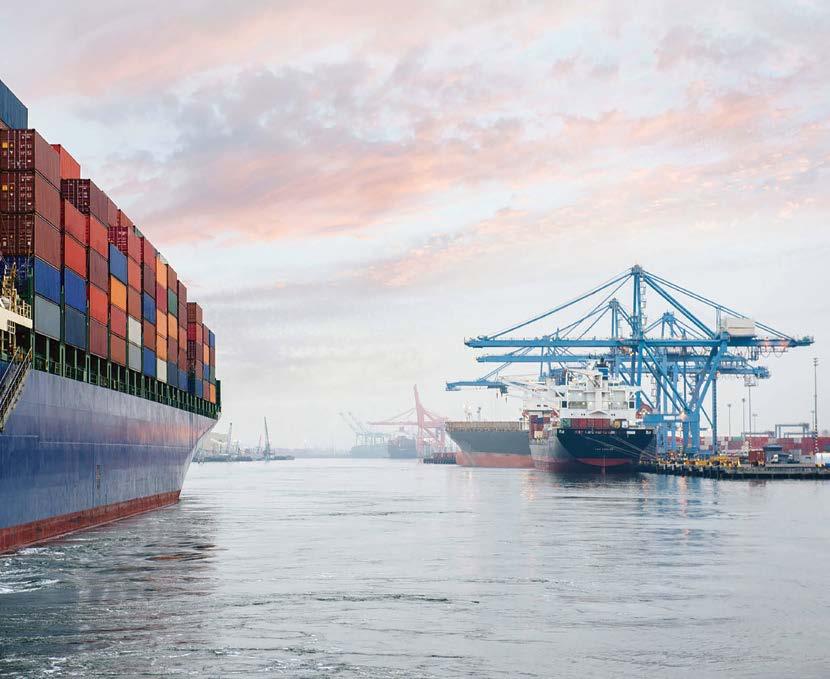
For centuries, seafarers navigated the oceans using the stars. However, in recent years, data has become our new north star with mariners now relying on a sophisticated network of sensors, satellite GPS and radar systems, weather forecasts, and real-time voyage data as navigational aids.
The role of data in the maritime industry has become increasingly significant, particularly in the context of decarbonisation efforts. But an industry powered by alternative fuels is still some way off, meaning shipping must find immediate solutions to meet its ambitious sustainability targets. Many companies have turned to digitalisation to develop emission-saving technology, leading to skyrocketing demand for software solutions.
In the challenge to reduce emissions, navigational data is playing a pivotal role. Established navigational routes have long been unquestioned, with vessels taking tried and tested routes to get from point A to B. But failing to question the efficiency of these routes is a dated perspective that could become widely accepted if left unchallenged.
Today, we possess in-depth data about our oceans, giving mariners an authoritative view of their surroundings. While this information is primarily used to ensure safety, pigeonholing its capability is a missed opportunity. Advanced surveying tools that we now have at our disposal provide unprecedented knowledge about the oceans and seabed topography. This information is a vastly underutilised resource.

With more granular geographical information, we can now chart shorter and more efficient routes. Shorter journeys translate to reduced fuel consumption and, consequently, fewer emissions – a game changer in the journey to decarbonise. Not only can we chart more efficient ‘base’ routes, the integration of data analytics and machine-learning algorithms enables shipping companies to identify live route adjustments based on changing weather conditions.
Projects focused on voyage optimisation, such as Blue Visby, are also essential in our efforts to achieve our sustainability targets. The Blue Visby Consortium harnesses data, including navigational, to optimise a vessels arrival time at the port. By optimising the time vessels arrive in ports and formalising the process through contractual agreements, we can eliminate the wasteful ‘sail fast then wait’ practice. Vessels will no longer have to sail full steam ahead as they have the security of knowing they have an allocated slot at the port. Thus, allowing them to implement voyage optimisation solutions that help reduce emissions, fuels, and costs. This green solution would not be possible without in-depth navigational detail.
Data has become our new ‘North Star’ in navigating the maritime industry’s future. By harnessing the full potential of navigational data, we can chart a course towards sustainability, fostering a cleaner, more efficient maritime sector. l
87 106 November/December 2023 Ship Management International

Clean Seas Air lubrication can help mitigate underwater radiated noise

Dr Arno Dubois, Lead Hydrodynamicist at Silverstream Technologies, discusses the importance of underwater radiated noise (URN) as an issue and a possible way to help mitigate it.
There has recently been an increase in focus on minimising URN from shipping. At MEPC 80 in July 2023, the IMO adopted new guidelines for the reduction of URN from the global merchant fleet. The guidelines came into effect on 1 August 2023 and included updated technical knowledge, standards and recommendations.
In a sign of just how key this challenge is to the shipping industry, the IMO highlighted ‘UN Sustainable Development Goal 14: Life Below Water’ as a priority in its recent World Maritime Day theme and recognised the importance of reducing URN to conserving the marine ecosystem.
URN is an issue that must be tackled because it has a harmful impact on the critical life functions of a wide range of marine life. Whales, dolphins and millions of other underwater species rely on sound for communication, navigation and hunting, which URN from ships can interfere with.
There is an increasing body of research into minimising URN. A recent whitepaper titled ‘Ship Hull Air Lubrication: Aspects of Cavitation, Underwater Radiated Noise and Propulsion’ conducted by Professor John Carlton – fellow of the Royal Academy of Engineering and Professor of Marine Engineering at University of London – has analysed how air bubbles can potentially reduce URN.
It is Silverstream’s interpretation, based on the whitepaper’s findings, that the Silverstream® System reduces URN emissions both from the hull and the propeller. There appears to be a masking effect on the noise emitted from ships that is caused by the bubble carpet an air lubrication system produces. Meanwhile, the noise levels generated by the propeller can be significantly reduced through the cushioning effect of emitted pressure pulses by air introduced through the air lubrication system.
Writing about reducing hull and propellor noise, in his own words Professor Carlton states: “the presence of air
in the form of an air bubble mixture around the hull, for example as generated by an air lubrication system, will significantly attenuate the transmission of noise from the ship into the sea environment… the presence of air in the propeller disc as introduced by an air lubrication system, rather than negatively affecting performance, attenuates higher harmonics of radiated pressure spectrum emitted by cavitating propeller.”
The whitepaper’s findings are in line with the offshore and defence industries’ research too. As outlined by Professor Carlton, “systems of air bubbles are used in offshore engineering works such as piling operations to limit the propagation of noise into the underwater marine environment. The use of air curtains also finds application in military ships where air is used to form an air-bubble screen around the hull of the ship, reducing the transmission of machinery noise to the surrounding waters.”
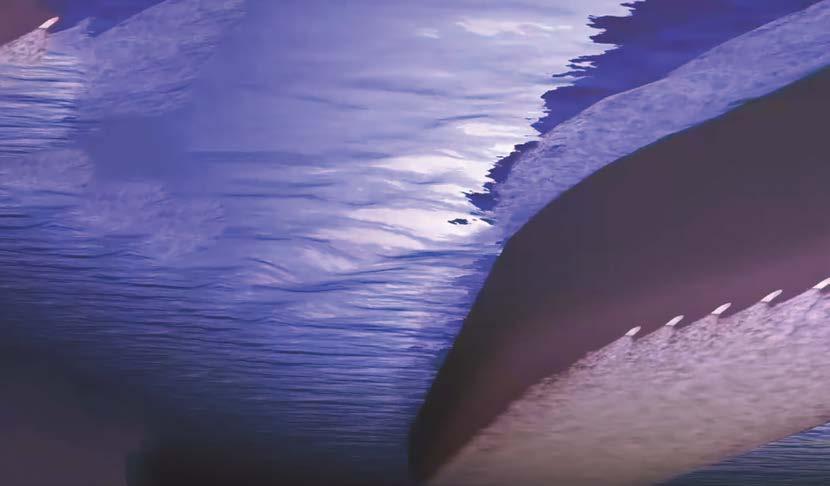
The bottom line is that two of the biggest priorities for the IMO are reducing shipping emissions and minimising the impact of shipping on the marine ecosystem. Thankfully, the industry now has increasing access to solutions that can address both challenges at once, tremendously reducing our impact on the oceans on which we all rely. l
89 106 November/December 2023 Ship Management International
Objects of Desire
» Pen art
With its homage to Vincent van Gogh Limited Edition 888, Montblanc celebrates one of the most popular painters of the late 19th century with possibly one of the most expensive pens around! This unique masterpiece emphasises his time in Saint-Rémy-de-Provence and Auvers-sur-Oise, with a design reflecting the Provencal skies and one of his most famous paintings, the ‘Wheatfield with Crows’. The engraved 1889 on the barrel ring, next to Vincent’s signature in blue lacquer, commemorates the year when he moved to Saint-Rémy. Vincent Van Gogh created impressions near the asylum where he lived, marking his maturity as an artist. The provincial blue skies and wheatfields are reflected in translucent lacquer inlays on the fountain pen.
Montblanc Masters of Art Limited Edition 888
£8,600.00 montblanc.com

» From desert to super-city

» Sensory experience
Don’t miss out on a creative master chocolatier working with the freshest ingredients and creating memorable moments of joy. Läderach chocolate are delightful Swiss-made treats to ensure a sensory experience of the most authentic chocolates and textures. Freshly made in Switzerland, and handcrafted with premium quality ingredients creating some of the finest tasting chocolate in the world. Visit shops in Switzerland and Germany or shop online where the selection will leave you salivating.
Chocolate selection
From about £15 to £270 laderach.com
Dubai’s not for everyone but its ascension from desert to a modern super-city within 50 years has to be witnessed. Born from oil riches into gravity-defying skyscrapers, man-made land masses, and a slew of state-of-the-art hotels including the Burj al Arab, considered the world’s most expensive. Those staying in one of the royal suites are privy to not one, but two jacuzzis, and an entryway decked out in marble and gold, all for a starting price of $9,000 per night. Atlantis the Palm, meanwhile, has hosted celebrities from Michael Jackson to Kim Kardashian, and the ‘underwater’ suites have floor-to-ceiling windows peering into a three-million-gallon aquarium. Time perhaps for a well-earned visit?

90 Ship Management International Issue 106 November/December 2023

» Luxury at its best
» Striking skis
As if designer gear couldn’t get flashier, check out these bold designer skis to accompany the Louis Vuitton’s Winter Resort skiwear. The Monogram Stripe Skis combine an iconic house signature with high-level performance. Meticulously handcrafted in poplar, beechwood, fibreglass and steel, they feature the historic monogram pattern in a rich blue accented by bright red and white stripes making anyone on these, eye-catching on the slopes. Handmade. Bindings included. Limited edition of 200. W 12.5 x L 168 x D 5 cm/W 4.9 x L 66.1 x D 2 inches.
Monogram Stripe Skis
£6,700.00
uk.louisvuitton.com
Zeelander is a high-end boutique yacht brand specializing in sports cruisers up to 66 feet. Each is made to order at the company’s state-of-the-art facility in the Netherlands. Limited yearly production ensures each vessel is crafted with exclusive care and attention, delivering a timeless work of art that embodies Zeelander’s rich heritage and contemporary style. Whisper in the wind, a sensual soul, The Zeelander 6 has all the ingredients for the most intimate weekend getaway, with a masterful layout and most elegant design. 9ft, SPEED40kt, depending on choice of engine.
Zeelander 6
$1million new zeelander.com

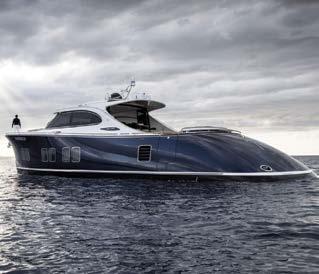
This burl wood design roulette set by Philos brings the luxury of the casino to your home, featured in a stunning display case, the set includes everything you need for a night of friendly gambling. Opening the lid reveals a mahogany toned surround for a single zero wheel, given a smooth spin with the golden handle. The 200 chips, balls and money rake are housed in a convenient front drawer with delicate golden handles. Finish with a personalised message on a front brass plate for a most wonderful gift. Game size: 385 x 385 x 188mm. Includes a chip rake, two metal balls, 200 roulette chips. Materials: MDF, acrylic, felt, metal.
Roulette Set in Display Case
£295 farrar-tanner.co.uk
91 106 November/December 2023 Ship Management International
Objects of Desire
» Tabletop casino
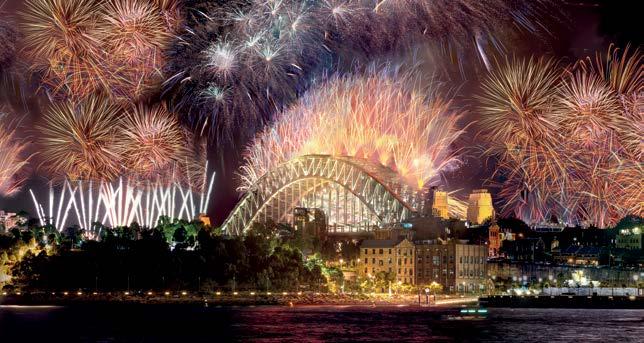
New Year’s Eve, Sydney, Australia
Sydney fireworks
For a spectacular New Year spend it in Sydney celebrating 2024! It’s one of the largest free public events in the world and spans six kilometres (four miles) of Sydney Harbour and the Harbour Bridge, providing the perfect vantage point from which to view the 80,000 fireworks that are set off during an amazing show. The warm evenings during December also make this a much more pleasant viewing experience.
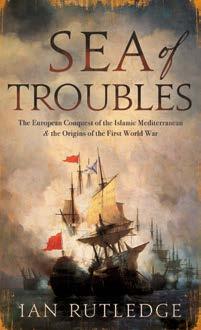
The Sea of Troubles Saqi Books, ISBN: 9780863569500 Ian Rutledge
In the mid-eighteenth century most of the Mediterranean coastline was controlled by the Ottoman Empire, a vast Islamic power regarded by Christian Europe with awe and fear. By the end of the First World War, this great civilisation had been completely subjugated, and its territories occupied by European powers. Sea of Troubles is the definitive account of the European conquest of the Levant and North Africa over three centuries. Ian Rutledge reveals the intense imperial rivalry between six European powers, Britain, France, Italy, Spain, Austria-Hungary and Russia - who all jostled for control of the trade, lands and wealth of the Islamic Mediterranean. The competition between these states made their conquest more difficult than any they’d ever encountered. Yet, as new contenders entered the contest, and as rivalries intensified in the early twentieth century, events would spiral out of control as the continent headed towards the First World War.
92 Ship Management International Issue 106 November/December 2023
Review
Destination Cuba
The Malecón, Havana’s evocative 7km-long sea drive, is one of the city’s most soulful and quintessentially Cuban thoroughfares and a favoured meeting place for lovers, philosophers, poets, traveling minstrels, fishers and Florida-gazers. The Malecón’s atmosphere is most potent at sunset, when the weak yellow light from creamy Vedado filters like a dim torch onto the buildings of Centro Habana, lending their dilapidated facades a distinctly romantic quality. A salubrious oceanside boulevard since the 1900s for Havana’s middle classes, the Malecón expanded rapidly eastward in the century’s first decade, with a mishmash of architecture that mixed sturdy neoclassicism with whimsical art nouveau. By the 1920s the road had reached the outer limits of Vedado, and by the early 1950s it had metamorphosed into a busy six-lane highway that carried streams of wave-dodging Buicks and Chevrolets from the grey hulk of the Castillo de San Salvador de la Punta to the borders of Miramar. Today the Malecón remains Havana’s most authentic open-air theatre, sometimes dubbed ‘the world’s longest sofa,’ where the whole city comes to meet, greet, date and debate. With so many places to experience it’s hard to narrow it down, but start here and it can only get better from there on.

Paris Icon louvre.fr

Tea Culture
Yi Feng Galleria, 99 East Beijing Road, Huangpu, Shanghai, China
Ritzcarlton.com
You can tell from its name that the restaurant is serious about the national beverage, given these are the professional tea masters that brew the perfect cup using top quality loose leaves and natural spring water. As for the food, the chef hails from Guangdong and displays his skills in signatures like Huai Yang-style marinated squab in herb-infused brine, and braised yellow croaker with rice cake. Double-boiled oxtail soup with whelk is a health tonic that tastes superb. For reservations call +86 21 6333 0383 1 Michelin Star.

Experience the world’s most visited art museum, with 10.1 million people passing through the iconic pyramid in 2018. A city within a city, and a vast, multi-level maze of galleries, passageways, staircases and escalators. It’s also the largest art museum in the world, at 72,735 metres squared (about the size of ten football pitches). Famous for its glorious art including the Mona Lisa, the Louvre is also a collection of masterpieces modified and added to from one century to another. With 35,000 works of art and artefacts on show, it’s split into eight departments and housed across three wings. The main attraction here is painting and sculpture, from ancient statues to modern masterpieces. Check online as to which days are showing what exhibitions.
93 106 November/December 2023 Ship Management International
books, theatre, dining, events, culture, films, festival, music, art, dvd, wine
Lifestyle

Stylish Toyota sports car with BMW input offers best of both worlds
By Rob Auchterlonie
CONTRARY to popular belief, not everyone wants to drive around in SUVs. So thank goodness there are still manufacturers who are prepared to take a punt and have a true two-seater sports car on offer, as well as the usual fare, in their sales brochures.
Take a bow, Toyota.
Like every version that has gone before it – and there have been a few –Toyota’s GR Supra hit the streets with a hefty six cylinder petrol engine shoving the power to the rear wheels.
Those who are happy to sit as low as a rattlesnake’s wotsits and glance out the side window to get a look at the door handle of the SUV in the traffic queue beside you will surely love it.
There’s also a milder 2.0 litre version and while both look the same, the telltale is the red Supra badge on the rear of the more interesting one.
It’s a bit closer to Germany than Japan though – the development costs were shared with BMW for their
Z4 so there are inevitable similarities, particularly with BMW’s excellent i-system, but Supra’s unique styling sets it apart – the view via the door mirrors of the bulbous sculpted haunches that curve over the rear of the car are styling perfection, and the view forward over the bonnet isn’t too shabby either.
So, a car you’re likely to be swayed by the looks of and the anticipation of a bit of fun. There’s an auto option but sampled here is the 335 bhp 3.0 litre six cylinder mated to a good old six speed manual box.
There’s a distinctive bark as you head towards the upper echelons of the engine revolutions, accompanied by a chorus of pops and crackles when you ease off the accelerator.
An auto box is available but opt for the six speed manual. That set-up makes it a bit more rewarding than some and quick, smooth gearchanges require a higher degree of concentration than is the norm. There’s a definite gate that
94 Ship Management International Issue 106 November/December 2023

Road test: Toyota GR Supra 3.0 manual
95 106 November/December 2023 Ship Management International Lifestyle


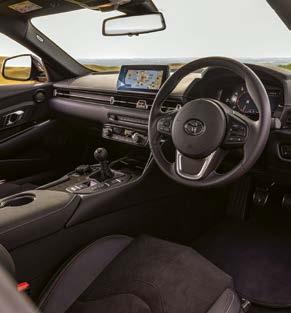
demands a degree of precision when shifting, as well as a clutch that liked to be pushed to the extent of its travel, but get it all in sync and there’s a sense of a job well done.
Old school, and while it might take a trip or two to perfect, it’s worth the effort.
Sporty steering with a decent level of precision and strong brakes are box tickers, and while the average road where we live contains more holes than a chunk of Gruyere – and consequently has the ability to make the Supra shudder over the worst of them - find a piece of decent smooth blacktop and progress is relatively serene.
In the main you can have a fairly normal conversation in the cabin, but on poor surfaces the road noise from the tyres builds to the point that even the radio struggles a bit, despite the 10 speakers dotted around the cabin.
An electronically controlled
Price: £54,630
Engine: 3.0 litre, six cylinder, petrol
Power: 335bhp
Torque: 369lb/ft
Transmission: six speed manual
Top speed: 155mp (limited)
0-62mph: 4.6 seconds
Economy: 32mpg
CO2 emissions: 198g/km
limited-slip differential is standard on all models, and while it helps you get the power down on the road, the GR Supra has a tendency to break traction, partly due to the weight of the engine sitting up front.
You sit low in supportive seats that have adjustable lumbar support
and side bolsters so the ideal position isn’t too hard to find. The sculpted roof helps with headroom, and with all round visibility short on supply the rear view camera is something you can’t do without.
Loads of standard kit – and loads of appeal. l
96 Ship Management International Issue 106 November/December 2023
Toyota GR Supra
Lifestyle
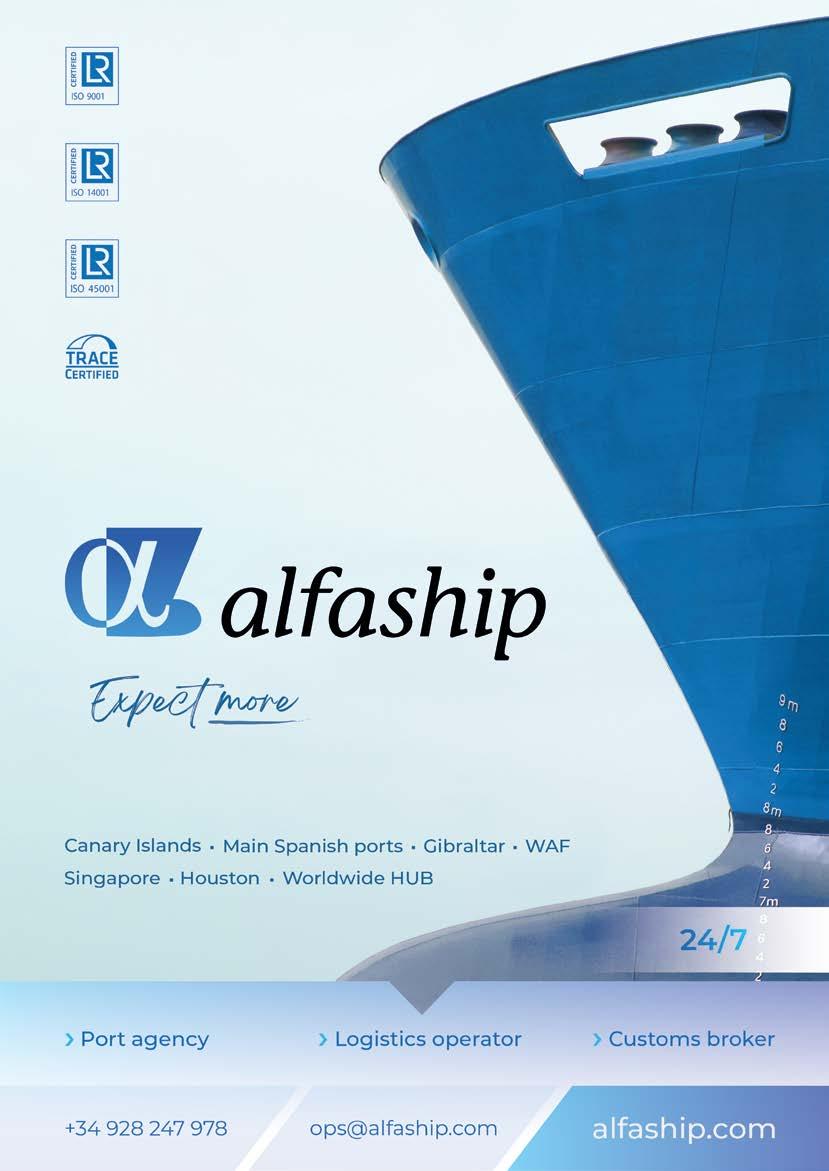
































 By Robert Hodge
By Robert Hodge









 Bjørn Martin Klokkernes CEO, Star Information Services
Bjørn Martin Klokkernes CEO, Star Information Services



































































 PHOTO: BUREAU VERITAS
PHOTO: BUREAU VERITAS














































